CHCECE023: Analyse Information to Inform Learning (Core Unit) Assessment
VerifiedAdded on 2022/09/01
|34
|9885
|48
AI Summary
This is the Diploma of Early Childhood Education and Care | CHCECE023: Analyze information to inform learning (Core Unit) Assessment.
>> Get more chcece023 assessment answers
Contribute Materials
Your contribution can guide someone’s learning journey. Share your
documents today.
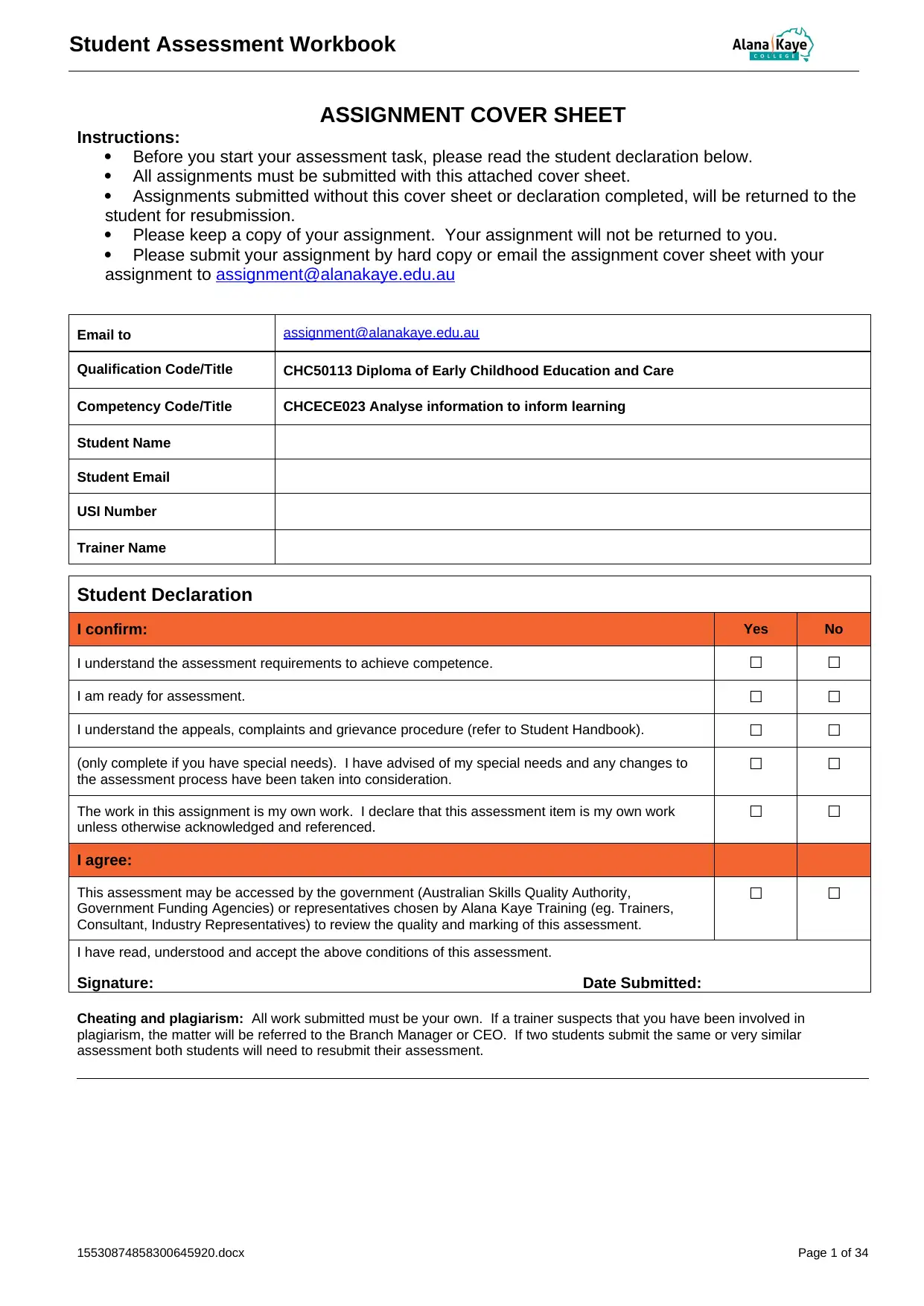
Student Assessment Workbook
ASSIGNMENT COVER SHEET
Instructions:
Before you start your assessment task, please read the student declaration below.
All assignments must be submitted with this attached cover sheet.
Assignments submitted without this cover sheet or declaration completed, will be returned to the
student for resubmission.
Please keep a copy of your assignment. Your assignment will not be returned to you.
Please submit your assignment by hard copy or email the assignment cover sheet with your
assignment to assignment@alanakaye.edu.au
Email to assignment@alanakaye.edu.au
Qualification Code/Title CHC50113 Diploma of Early Childhood Education and Care
Competency Code/Title CHCECE023 Analyse information to inform learning
Student Name
Student Email
USI Number
Trainer Name
Student Declaration
I confirm: Yes No
I understand the assessment requirements to achieve competence. ☐ ☐
I am ready for assessment. ☐ ☐
I understand the appeals, complaints and grievance procedure (refer to Student Handbook). ☐ ☐
(only complete if you have special needs). I have advised of my special needs and any changes to
the assessment process have been taken into consideration.
☐ ☐
The work in this assignment is my own work. I declare that this assessment item is my own work
unless otherwise acknowledged and referenced.
☐ ☐
I agree:
This assessment may be accessed by the government (Australian Skills Quality Authority,
Government Funding Agencies) or representatives chosen by Alana Kaye Training (eg. Trainers,
Consultant, Industry Representatives) to review the quality and marking of this assessment.
☐ ☐
I have read, understood and accept the above conditions of this assessment.
Signature: Date Submitted:
Cheating and plagiarism: All work submitted must be your own. If a trainer suspects that you have been involved in
plagiarism, the matter will be referred to the Branch Manager or CEO. If two students submit the same or very similar
assessment both students will need to resubmit their assessment.
15530874858300645920.docx Page 1 of 34
ASSIGNMENT COVER SHEET
Instructions:
Before you start your assessment task, please read the student declaration below.
All assignments must be submitted with this attached cover sheet.
Assignments submitted without this cover sheet or declaration completed, will be returned to the
student for resubmission.
Please keep a copy of your assignment. Your assignment will not be returned to you.
Please submit your assignment by hard copy or email the assignment cover sheet with your
assignment to assignment@alanakaye.edu.au
Email to assignment@alanakaye.edu.au
Qualification Code/Title CHC50113 Diploma of Early Childhood Education and Care
Competency Code/Title CHCECE023 Analyse information to inform learning
Student Name
Student Email
USI Number
Trainer Name
Student Declaration
I confirm: Yes No
I understand the assessment requirements to achieve competence. ☐ ☐
I am ready for assessment. ☐ ☐
I understand the appeals, complaints and grievance procedure (refer to Student Handbook). ☐ ☐
(only complete if you have special needs). I have advised of my special needs and any changes to
the assessment process have been taken into consideration.
☐ ☐
The work in this assignment is my own work. I declare that this assessment item is my own work
unless otherwise acknowledged and referenced.
☐ ☐
I agree:
This assessment may be accessed by the government (Australian Skills Quality Authority,
Government Funding Agencies) or representatives chosen by Alana Kaye Training (eg. Trainers,
Consultant, Industry Representatives) to review the quality and marking of this assessment.
☐ ☐
I have read, understood and accept the above conditions of this assessment.
Signature: Date Submitted:
Cheating and plagiarism: All work submitted must be your own. If a trainer suspects that you have been involved in
plagiarism, the matter will be referred to the Branch Manager or CEO. If two students submit the same or very similar
assessment both students will need to resubmit their assessment.
15530874858300645920.docx Page 1 of 34
Secure Best Marks with AI Grader
Need help grading? Try our AI Grader for instant feedback on your assignments.
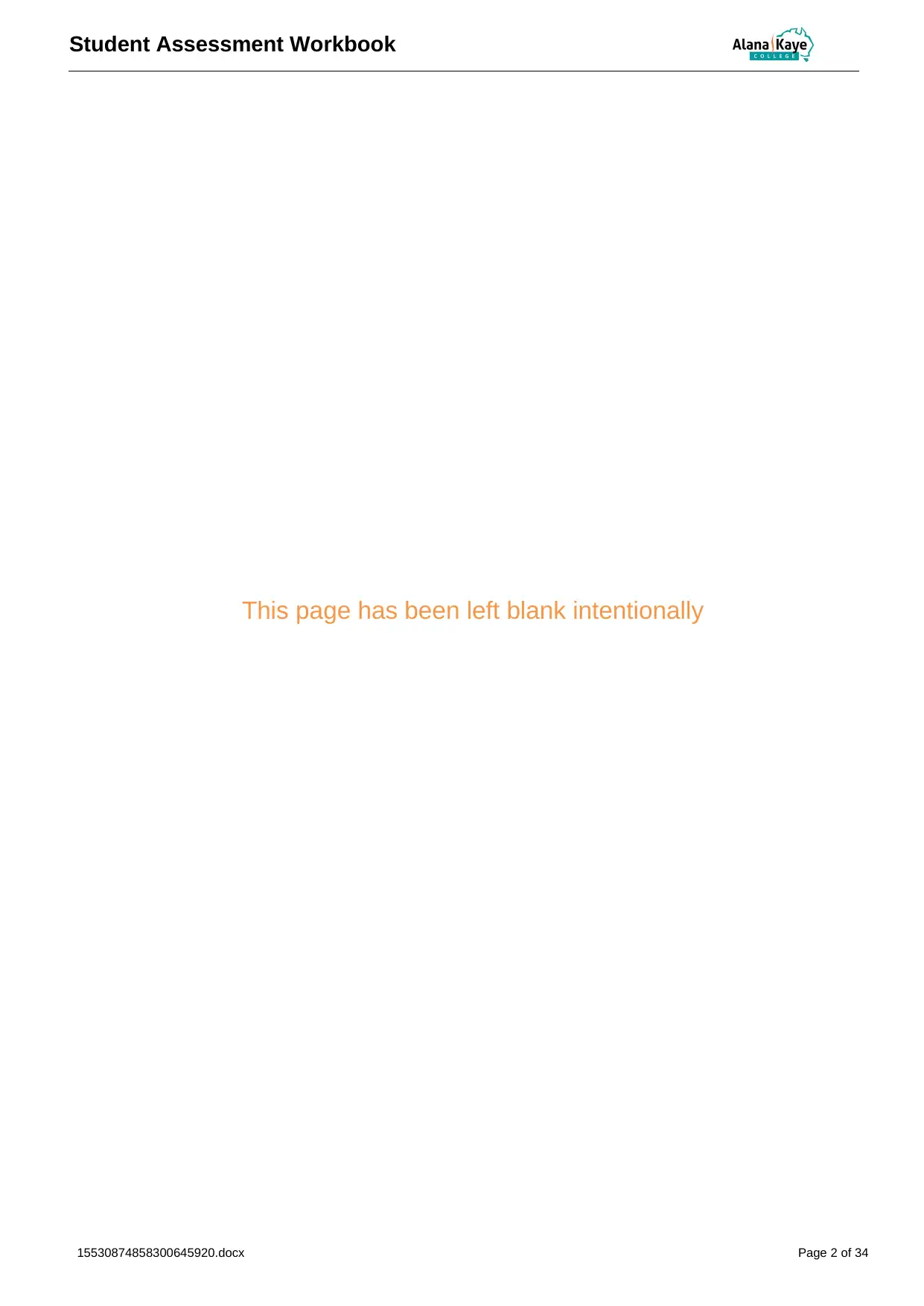
Student Assessment Workbook
This page has been left blank intentionally
15530874858300645920.docx Page 2 of 34
This page has been left blank intentionally
15530874858300645920.docx Page 2 of 34
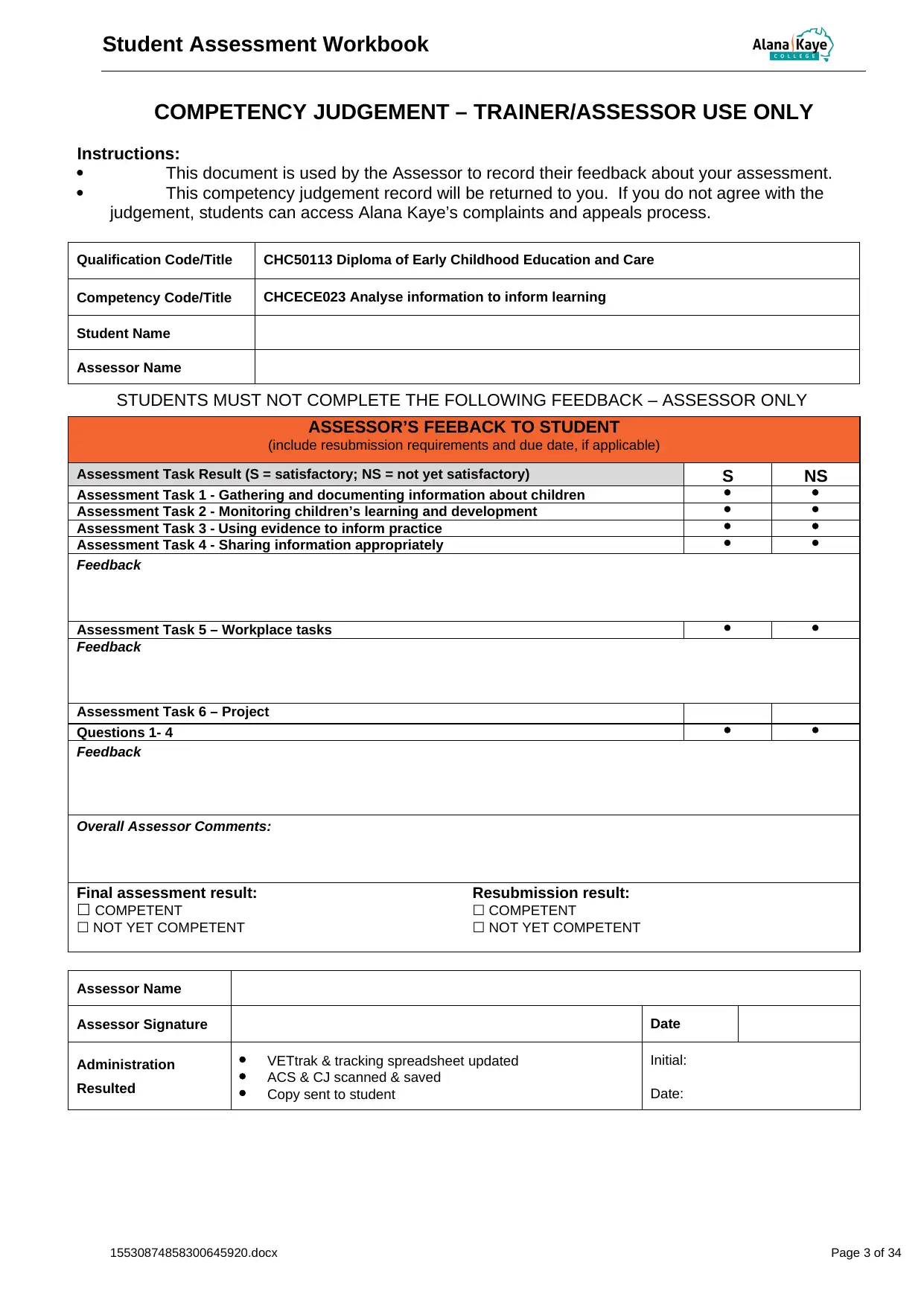
Student Assessment Workbook
COMPETENCY JUDGEMENT – TRAINER/ASSESSOR USE ONLY
Instructions:
This document is used by the Assessor to record their feedback about your assessment.
This competency judgement record will be returned to you. If you do not agree with the
judgement, students can access Alana Kaye’s complaints and appeals process.
Qualification Code/Title CHC50113 Diploma of Early Childhood Education and Care
Competency Code/Title CHCECE023 Analyse information to inform learning
Student Name
Assessor Name
STUDENTS MUST NOT COMPLETE THE FOLLOWING FEEDBACK – ASSESSOR ONLY
ASSESSOR’S FEEBACK TO STUDENT
(include resubmission requirements and due date, if applicable)
Assessment Task Result (S = satisfactory; NS = not yet satisfactory) S NS
Assessment Task 1 - Gathering and documenting information about children
Assessment Task 2 - Monitoring children’s learning and development
Assessment Task 3 - Using evidence to inform practice
Assessment Task 4 - Sharing information appropriately
Feedback
Assessment Task 5 – Workplace tasks
Feedback
Assessment Task 6 – Project
Questions 1- 4
Feedback
Overall Assessor Comments:
Final assessment result: Resubmission result:
☐ COMPETENT ☐ COMPETENT
☐ NOT YET COMPETENT ☐ NOT YET COMPETENT
Assessor Name
Assessor Signature Date
Administration
Resulted
VETtrak & tracking spreadsheet updated
ACS & CJ scanned & saved
Copy sent to student
Initial:
Date:
15530874858300645920.docx Page 3 of 34
COMPETENCY JUDGEMENT – TRAINER/ASSESSOR USE ONLY
Instructions:
This document is used by the Assessor to record their feedback about your assessment.
This competency judgement record will be returned to you. If you do not agree with the
judgement, students can access Alana Kaye’s complaints and appeals process.
Qualification Code/Title CHC50113 Diploma of Early Childhood Education and Care
Competency Code/Title CHCECE023 Analyse information to inform learning
Student Name
Assessor Name
STUDENTS MUST NOT COMPLETE THE FOLLOWING FEEDBACK – ASSESSOR ONLY
ASSESSOR’S FEEBACK TO STUDENT
(include resubmission requirements and due date, if applicable)
Assessment Task Result (S = satisfactory; NS = not yet satisfactory) S NS
Assessment Task 1 - Gathering and documenting information about children
Assessment Task 2 - Monitoring children’s learning and development
Assessment Task 3 - Using evidence to inform practice
Assessment Task 4 - Sharing information appropriately
Feedback
Assessment Task 5 – Workplace tasks
Feedback
Assessment Task 6 – Project
Questions 1- 4
Feedback
Overall Assessor Comments:
Final assessment result: Resubmission result:
☐ COMPETENT ☐ COMPETENT
☐ NOT YET COMPETENT ☐ NOT YET COMPETENT
Assessor Name
Assessor Signature Date
Administration
Resulted
VETtrak & tracking spreadsheet updated
ACS & CJ scanned & saved
Copy sent to student
Initial:
Date:
15530874858300645920.docx Page 3 of 34
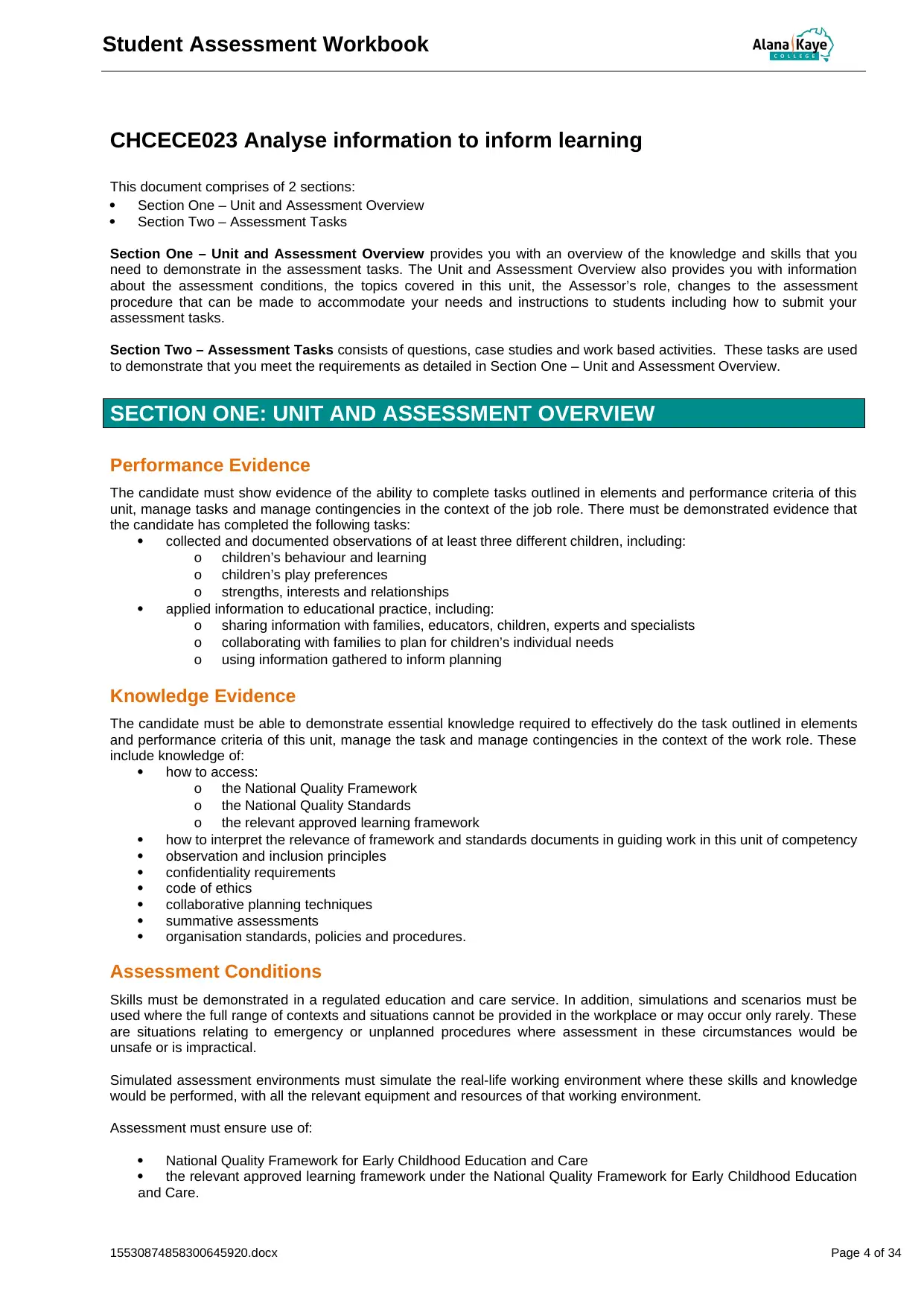
Student Assessment Workbook
CHCECE023 Analyse information to inform learning
This document comprises of 2 sections:
Section One – Unit and Assessment Overview
Section Two – Assessment Tasks
Section One – Unit and Assessment Overview provides you with an overview of the knowledge and skills that you
need to demonstrate in the assessment tasks. The Unit and Assessment Overview also provides you with information
about the assessment conditions, the topics covered in this unit, the Assessor’s role, changes to the assessment
procedure that can be made to accommodate your needs and instructions to students including how to submit your
assessment tasks.
Section Two – Assessment Tasks consists of questions, case studies and work based activities. These tasks are used
to demonstrate that you meet the requirements as detailed in Section One – Unit and Assessment Overview.
SECTION ONE: UNIT AND ASSESSMENT OVERVIEW
Performance Evidence
The candidate must show evidence of the ability to complete tasks outlined in elements and performance criteria of this
unit, manage tasks and manage contingencies in the context of the job role. There must be demonstrated evidence that
the candidate has completed the following tasks:
collected and documented observations of at least three different children, including:
o children’s behaviour and learning
o children’s play preferences
o strengths, interests and relationships
applied information to educational practice, including:
o sharing information with families, educators, children, experts and specialists
o collaborating with families to plan for children’s individual needs
o using information gathered to inform planning
Knowledge Evidence
The candidate must be able to demonstrate essential knowledge required to effectively do the task outlined in elements
and performance criteria of this unit, manage the task and manage contingencies in the context of the work role. These
include knowledge of:
how to access:
o the National Quality Framework
o the National Quality Standards
o the relevant approved learning framework
how to interpret the relevance of framework and standards documents in guiding work in this unit of competency
observation and inclusion principles
confidentiality requirements
code of ethics
collaborative planning techniques
summative assessments
organisation standards, policies and procedures.
Assessment Conditions
Skills must be demonstrated in a regulated education and care service. In addition, simulations and scenarios must be
used where the full range of contexts and situations cannot be provided in the workplace or may occur only rarely. These
are situations relating to emergency or unplanned procedures where assessment in these circumstances would be
unsafe or is impractical.
Simulated assessment environments must simulate the real-life working environment where these skills and knowledge
would be performed, with all the relevant equipment and resources of that working environment.
Assessment must ensure use of:
National Quality Framework for Early Childhood Education and Care
the relevant approved learning framework under the National Quality Framework for Early Childhood Education
and Care.
15530874858300645920.docx Page 4 of 34
CHCECE023 Analyse information to inform learning
This document comprises of 2 sections:
Section One – Unit and Assessment Overview
Section Two – Assessment Tasks
Section One – Unit and Assessment Overview provides you with an overview of the knowledge and skills that you
need to demonstrate in the assessment tasks. The Unit and Assessment Overview also provides you with information
about the assessment conditions, the topics covered in this unit, the Assessor’s role, changes to the assessment
procedure that can be made to accommodate your needs and instructions to students including how to submit your
assessment tasks.
Section Two – Assessment Tasks consists of questions, case studies and work based activities. These tasks are used
to demonstrate that you meet the requirements as detailed in Section One – Unit and Assessment Overview.
SECTION ONE: UNIT AND ASSESSMENT OVERVIEW
Performance Evidence
The candidate must show evidence of the ability to complete tasks outlined in elements and performance criteria of this
unit, manage tasks and manage contingencies in the context of the job role. There must be demonstrated evidence that
the candidate has completed the following tasks:
collected and documented observations of at least three different children, including:
o children’s behaviour and learning
o children’s play preferences
o strengths, interests and relationships
applied information to educational practice, including:
o sharing information with families, educators, children, experts and specialists
o collaborating with families to plan for children’s individual needs
o using information gathered to inform planning
Knowledge Evidence
The candidate must be able to demonstrate essential knowledge required to effectively do the task outlined in elements
and performance criteria of this unit, manage the task and manage contingencies in the context of the work role. These
include knowledge of:
how to access:
o the National Quality Framework
o the National Quality Standards
o the relevant approved learning framework
how to interpret the relevance of framework and standards documents in guiding work in this unit of competency
observation and inclusion principles
confidentiality requirements
code of ethics
collaborative planning techniques
summative assessments
organisation standards, policies and procedures.
Assessment Conditions
Skills must be demonstrated in a regulated education and care service. In addition, simulations and scenarios must be
used where the full range of contexts and situations cannot be provided in the workplace or may occur only rarely. These
are situations relating to emergency or unplanned procedures where assessment in these circumstances would be
unsafe or is impractical.
Simulated assessment environments must simulate the real-life working environment where these skills and knowledge
would be performed, with all the relevant equipment and resources of that working environment.
Assessment must ensure use of:
National Quality Framework for Early Childhood Education and Care
the relevant approved learning framework under the National Quality Framework for Early Childhood Education
and Care.
15530874858300645920.docx Page 4 of 34
Secure Best Marks with AI Grader
Need help grading? Try our AI Grader for instant feedback on your assignments.
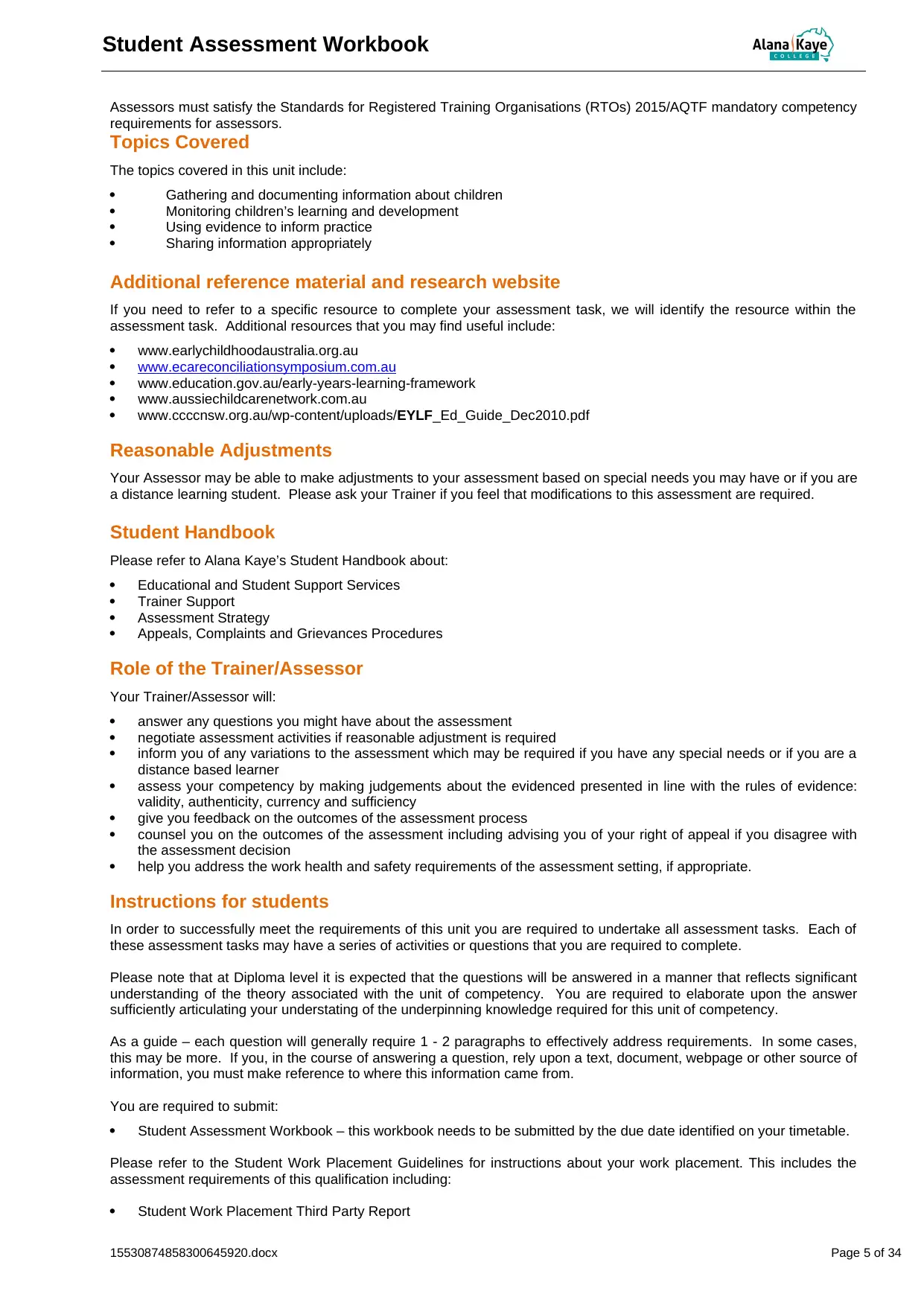
Student Assessment Workbook
Assessors must satisfy the Standards for Registered Training Organisations (RTOs) 2015/AQTF mandatory competency
requirements for assessors.
Topics Covered
The topics covered in this unit include:
Gathering and documenting information about children
Monitoring children’s learning and development
Using evidence to inform practice
Sharing information appropriately
Additional reference material and research website
If you need to refer to a specific resource to complete your assessment task, we will identify the resource within the
assessment task. Additional resources that you may find useful include:
www.earlychildhoodaustralia.org.au
www.ecareconciliationsymposium.com.au
www.education.gov.au/early-years-learning-framework
www.aussiechildcarenetwork.com.au
www.ccccnsw.org.au/wp-content/uploads/EYLF_Ed_Guide_Dec2010.pdf
Reasonable Adjustments
Your Assessor may be able to make adjustments to your assessment based on special needs you may have or if you are
a distance learning student. Please ask your Trainer if you feel that modifications to this assessment are required.
Student Handbook
Please refer to Alana Kaye’s Student Handbook about:
Educational and Student Support Services
Trainer Support
Assessment Strategy
Appeals, Complaints and Grievances Procedures
Role of the Trainer/Assessor
Your Trainer/Assessor will:
answer any questions you might have about the assessment
negotiate assessment activities if reasonable adjustment is required
inform you of any variations to the assessment which may be required if you have any special needs or if you are a
distance based learner
assess your competency by making judgements about the evidenced presented in line with the rules of evidence:
validity, authenticity, currency and sufficiency
give you feedback on the outcomes of the assessment process
counsel you on the outcomes of the assessment including advising you of your right of appeal if you disagree with
the assessment decision
help you address the work health and safety requirements of the assessment setting, if appropriate.
Instructions for students
In order to successfully meet the requirements of this unit you are required to undertake all assessment tasks. Each of
these assessment tasks may have a series of activities or questions that you are required to complete.
Please note that at Diploma level it is expected that the questions will be answered in a manner that reflects significant
understanding of the theory associated with the unit of competency. You are required to elaborate upon the answer
sufficiently articulating your understating of the underpinning knowledge required for this unit of competency.
As a guide – each question will generally require 1 - 2 paragraphs to effectively address requirements. In some cases,
this may be more. If you, in the course of answering a question, rely upon a text, document, webpage or other source of
information, you must make reference to where this information came from.
You are required to submit:
Student Assessment Workbook – this workbook needs to be submitted by the due date identified on your timetable.
Please refer to the Student Work Placement Guidelines for instructions about your work placement. This includes the
assessment requirements of this qualification including:
Student Work Placement Third Party Report
15530874858300645920.docx Page 5 of 34
Assessors must satisfy the Standards for Registered Training Organisations (RTOs) 2015/AQTF mandatory competency
requirements for assessors.
Topics Covered
The topics covered in this unit include:
Gathering and documenting information about children
Monitoring children’s learning and development
Using evidence to inform practice
Sharing information appropriately
Additional reference material and research website
If you need to refer to a specific resource to complete your assessment task, we will identify the resource within the
assessment task. Additional resources that you may find useful include:
www.earlychildhoodaustralia.org.au
www.ecareconciliationsymposium.com.au
www.education.gov.au/early-years-learning-framework
www.aussiechildcarenetwork.com.au
www.ccccnsw.org.au/wp-content/uploads/EYLF_Ed_Guide_Dec2010.pdf
Reasonable Adjustments
Your Assessor may be able to make adjustments to your assessment based on special needs you may have or if you are
a distance learning student. Please ask your Trainer if you feel that modifications to this assessment are required.
Student Handbook
Please refer to Alana Kaye’s Student Handbook about:
Educational and Student Support Services
Trainer Support
Assessment Strategy
Appeals, Complaints and Grievances Procedures
Role of the Trainer/Assessor
Your Trainer/Assessor will:
answer any questions you might have about the assessment
negotiate assessment activities if reasonable adjustment is required
inform you of any variations to the assessment which may be required if you have any special needs or if you are a
distance based learner
assess your competency by making judgements about the evidenced presented in line with the rules of evidence:
validity, authenticity, currency and sufficiency
give you feedback on the outcomes of the assessment process
counsel you on the outcomes of the assessment including advising you of your right of appeal if you disagree with
the assessment decision
help you address the work health and safety requirements of the assessment setting, if appropriate.
Instructions for students
In order to successfully meet the requirements of this unit you are required to undertake all assessment tasks. Each of
these assessment tasks may have a series of activities or questions that you are required to complete.
Please note that at Diploma level it is expected that the questions will be answered in a manner that reflects significant
understanding of the theory associated with the unit of competency. You are required to elaborate upon the answer
sufficiently articulating your understating of the underpinning knowledge required for this unit of competency.
As a guide – each question will generally require 1 - 2 paragraphs to effectively address requirements. In some cases,
this may be more. If you, in the course of answering a question, rely upon a text, document, webpage or other source of
information, you must make reference to where this information came from.
You are required to submit:
Student Assessment Workbook – this workbook needs to be submitted by the due date identified on your timetable.
Please refer to the Student Work Placement Guidelines for instructions about your work placement. This includes the
assessment requirements of this qualification including:
Student Work Placement Third Party Report
15530874858300645920.docx Page 5 of 34
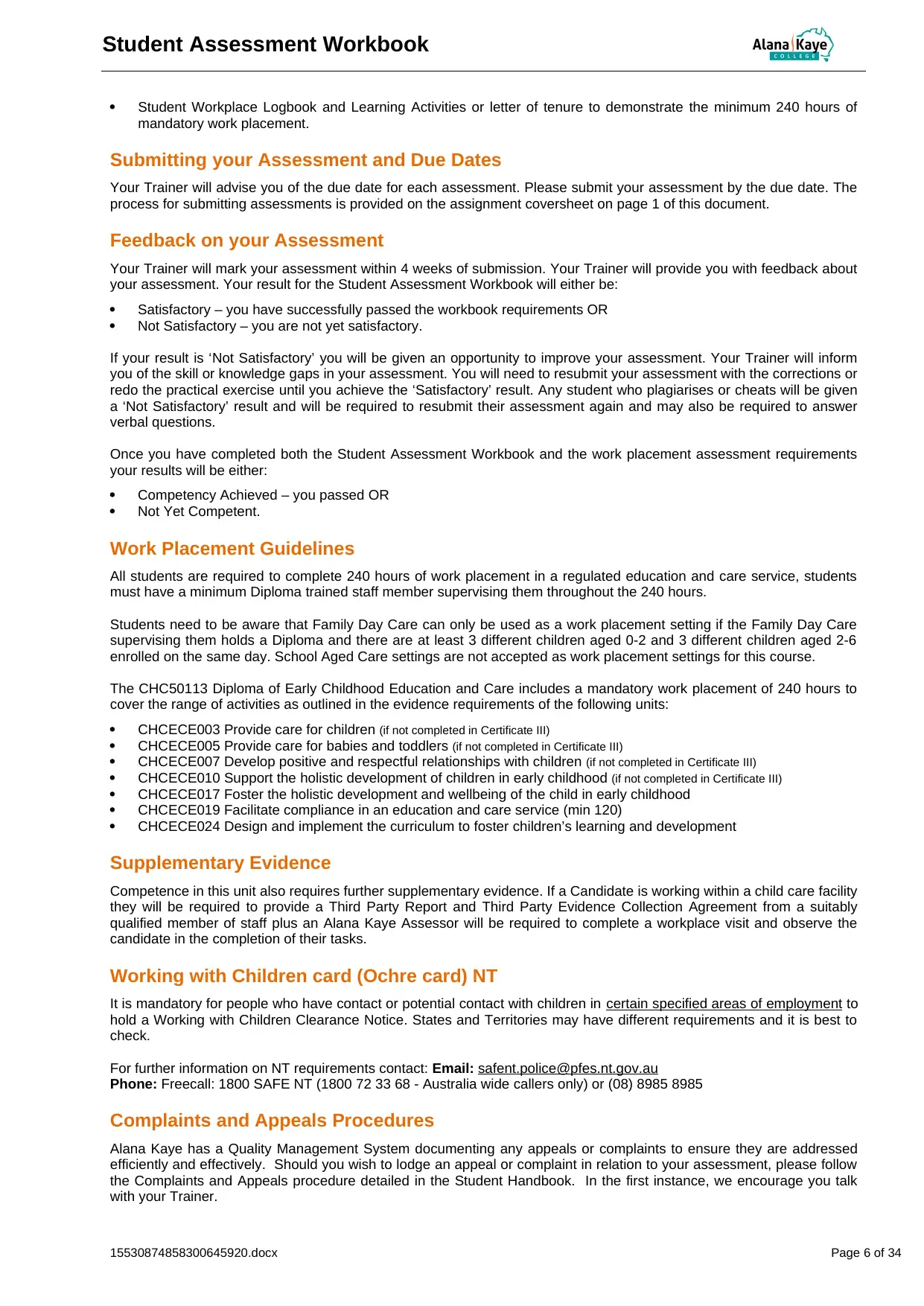
Student Assessment Workbook
Student Workplace Logbook and Learning Activities or letter of tenure to demonstrate the minimum 240 hours of
mandatory work placement.
Submitting your Assessment and Due Dates
Your Trainer will advise you of the due date for each assessment. Please submit your assessment by the due date. The
process for submitting assessments is provided on the assignment coversheet on page 1 of this document.
Feedback on your Assessment
Your Trainer will mark your assessment within 4 weeks of submission. Your Trainer will provide you with feedback about
your assessment. Your result for the Student Assessment Workbook will either be:
Satisfactory – you have successfully passed the workbook requirements OR
Not Satisfactory – you are not yet satisfactory.
If your result is ‘Not Satisfactory’ you will be given an opportunity to improve your assessment. Your Trainer will inform
you of the skill or knowledge gaps in your assessment. You will need to resubmit your assessment with the corrections or
redo the practical exercise until you achieve the ‘Satisfactory’ result. Any student who plagiarises or cheats will be given
a ‘Not Satisfactory’ result and will be required to resubmit their assessment again and may also be required to answer
verbal questions.
Once you have completed both the Student Assessment Workbook and the work placement assessment requirements
your results will be either:
Competency Achieved – you passed OR
Not Yet Competent.
Work Placement Guidelines
All students are required to complete 240 hours of work placement in a regulated education and care service, students
must have a minimum Diploma trained staff member supervising them throughout the 240 hours.
Students need to be aware that Family Day Care can only be used as a work placement setting if the Family Day Care
supervising them holds a Diploma and there are at least 3 different children aged 0-2 and 3 different children aged 2-6
enrolled on the same day. School Aged Care settings are not accepted as work placement settings for this course.
The CHC50113 Diploma of Early Childhood Education and Care includes a mandatory work placement of 240 hours to
cover the range of activities as outlined in the evidence requirements of the following units:
CHCECE003 Provide care for children (if not completed in Certificate III)
CHCECE005 Provide care for babies and toddlers (if not completed in Certificate III)
CHCECE007 Develop positive and respectful relationships with children (if not completed in Certificate III)
CHCECE010 Support the holistic development of children in early childhood (if not completed in Certificate III)
CHCECE017 Foster the holistic development and wellbeing of the child in early childhood
CHCECE019 Facilitate compliance in an education and care service (min 120)
CHCECE024 Design and implement the curriculum to foster children’s learning and development
Supplementary Evidence
Competence in this unit also requires further supplementary evidence. If a Candidate is working within a child care facility
they will be required to provide a Third Party Report and Third Party Evidence Collection Agreement from a suitably
qualified member of staff plus an Alana Kaye Assessor will be required to complete a workplace visit and observe the
candidate in the completion of their tasks.
Working with Children card (Ochre card) NT
It is mandatory for people who have contact or potential contact with children in certain specified areas of employment to
hold a Working with Children Clearance Notice. States and Territories may have different requirements and it is best to
check.
For further information on NT requirements contact: Email: safent.police@pfes.nt.gov.au
Phone: Freecall: 1800 SAFE NT (1800 72 33 68 - Australia wide callers only) or (08) 8985 8985
Complaints and Appeals Procedures
Alana Kaye has a Quality Management System documenting any appeals or complaints to ensure they are addressed
efficiently and effectively. Should you wish to lodge an appeal or complaint in relation to your assessment, please follow
the Complaints and Appeals procedure detailed in the Student Handbook. In the first instance, we encourage you talk
with your Trainer.
15530874858300645920.docx Page 6 of 34
Student Workplace Logbook and Learning Activities or letter of tenure to demonstrate the minimum 240 hours of
mandatory work placement.
Submitting your Assessment and Due Dates
Your Trainer will advise you of the due date for each assessment. Please submit your assessment by the due date. The
process for submitting assessments is provided on the assignment coversheet on page 1 of this document.
Feedback on your Assessment
Your Trainer will mark your assessment within 4 weeks of submission. Your Trainer will provide you with feedback about
your assessment. Your result for the Student Assessment Workbook will either be:
Satisfactory – you have successfully passed the workbook requirements OR
Not Satisfactory – you are not yet satisfactory.
If your result is ‘Not Satisfactory’ you will be given an opportunity to improve your assessment. Your Trainer will inform
you of the skill or knowledge gaps in your assessment. You will need to resubmit your assessment with the corrections or
redo the practical exercise until you achieve the ‘Satisfactory’ result. Any student who plagiarises or cheats will be given
a ‘Not Satisfactory’ result and will be required to resubmit their assessment again and may also be required to answer
verbal questions.
Once you have completed both the Student Assessment Workbook and the work placement assessment requirements
your results will be either:
Competency Achieved – you passed OR
Not Yet Competent.
Work Placement Guidelines
All students are required to complete 240 hours of work placement in a regulated education and care service, students
must have a minimum Diploma trained staff member supervising them throughout the 240 hours.
Students need to be aware that Family Day Care can only be used as a work placement setting if the Family Day Care
supervising them holds a Diploma and there are at least 3 different children aged 0-2 and 3 different children aged 2-6
enrolled on the same day. School Aged Care settings are not accepted as work placement settings for this course.
The CHC50113 Diploma of Early Childhood Education and Care includes a mandatory work placement of 240 hours to
cover the range of activities as outlined in the evidence requirements of the following units:
CHCECE003 Provide care for children (if not completed in Certificate III)
CHCECE005 Provide care for babies and toddlers (if not completed in Certificate III)
CHCECE007 Develop positive and respectful relationships with children (if not completed in Certificate III)
CHCECE010 Support the holistic development of children in early childhood (if not completed in Certificate III)
CHCECE017 Foster the holistic development and wellbeing of the child in early childhood
CHCECE019 Facilitate compliance in an education and care service (min 120)
CHCECE024 Design and implement the curriculum to foster children’s learning and development
Supplementary Evidence
Competence in this unit also requires further supplementary evidence. If a Candidate is working within a child care facility
they will be required to provide a Third Party Report and Third Party Evidence Collection Agreement from a suitably
qualified member of staff plus an Alana Kaye Assessor will be required to complete a workplace visit and observe the
candidate in the completion of their tasks.
Working with Children card (Ochre card) NT
It is mandatory for people who have contact or potential contact with children in certain specified areas of employment to
hold a Working with Children Clearance Notice. States and Territories may have different requirements and it is best to
check.
For further information on NT requirements contact: Email: safent.police@pfes.nt.gov.au
Phone: Freecall: 1800 SAFE NT (1800 72 33 68 - Australia wide callers only) or (08) 8985 8985
Complaints and Appeals Procedures
Alana Kaye has a Quality Management System documenting any appeals or complaints to ensure they are addressed
efficiently and effectively. Should you wish to lodge an appeal or complaint in relation to your assessment, please follow
the Complaints and Appeals procedure detailed in the Student Handbook. In the first instance, we encourage you talk
with your Trainer.
15530874858300645920.docx Page 6 of 34
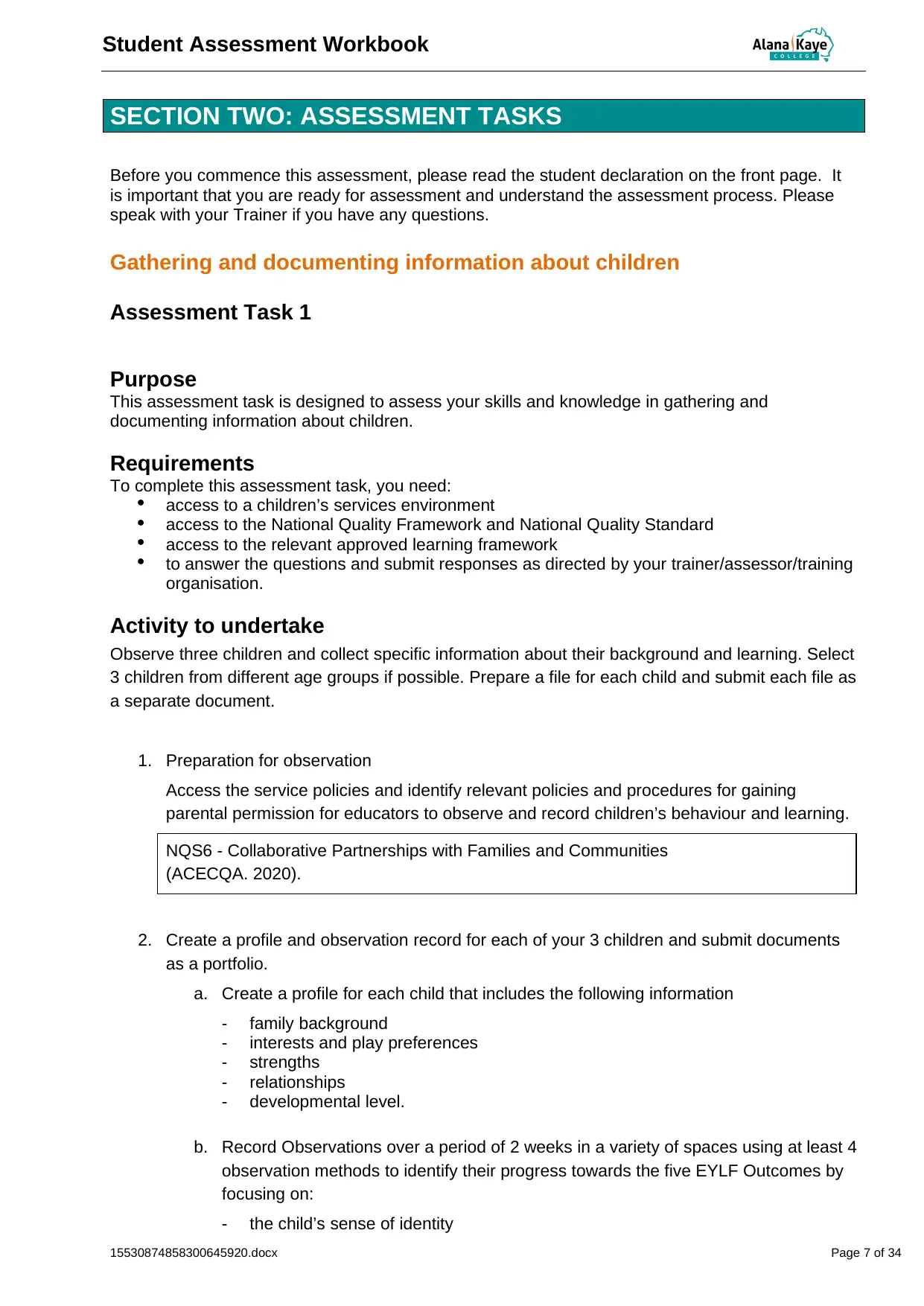
Student Assessment Workbook
SECTION TWO: ASSESSMENT TASKS
Before you commence this assessment, please read the student declaration on the front page. It
is important that you are ready for assessment and understand the assessment process. Please
speak with your Trainer if you have any questions.
Gathering and documenting information about children
Assessment Task 1
Purpose
This assessment task is designed to assess your skills and knowledge in gathering and
documenting information about children.
Requirements
To complete this assessment task, you need:
access to a children’s services environment
access to the National Quality Framework and National Quality Standard
access to the relevant approved learning framework
to answer the questions and submit responses as directed by your trainer/assessor/training
organisation.
Activity to undertake
Observe three children and collect specific information about their background and learning. Select
3 children from different age groups if possible. Prepare a file for each child and submit each file as
a separate document.
1. Preparation for observation
Access the service policies and identify relevant policies and procedures for gaining
parental permission for educators to observe and record children’s behaviour and learning.
NQS6 - Collaborative Partnerships with Families and Communities
(ACECQA. 2020).
2. Create a profile and observation record for each of your 3 children and submit documents
as a portfolio.
a. Create a profile for each child that includes the following information
- family background
- interests and play preferences
- strengths
- relationships
- developmental level.
b. Record Observations over a period of 2 weeks in a variety of spaces using at least 4
observation methods to identify their progress towards the five EYLF Outcomes by
focusing on:
- the child’s sense of identity
15530874858300645920.docx Page 7 of 34
SECTION TWO: ASSESSMENT TASKS
Before you commence this assessment, please read the student declaration on the front page. It
is important that you are ready for assessment and understand the assessment process. Please
speak with your Trainer if you have any questions.
Gathering and documenting information about children
Assessment Task 1
Purpose
This assessment task is designed to assess your skills and knowledge in gathering and
documenting information about children.
Requirements
To complete this assessment task, you need:
access to a children’s services environment
access to the National Quality Framework and National Quality Standard
access to the relevant approved learning framework
to answer the questions and submit responses as directed by your trainer/assessor/training
organisation.
Activity to undertake
Observe three children and collect specific information about their background and learning. Select
3 children from different age groups if possible. Prepare a file for each child and submit each file as
a separate document.
1. Preparation for observation
Access the service policies and identify relevant policies and procedures for gaining
parental permission for educators to observe and record children’s behaviour and learning.
NQS6 - Collaborative Partnerships with Families and Communities
(ACECQA. 2020).
2. Create a profile and observation record for each of your 3 children and submit documents
as a portfolio.
a. Create a profile for each child that includes the following information
- family background
- interests and play preferences
- strengths
- relationships
- developmental level.
b. Record Observations over a period of 2 weeks in a variety of spaces using at least 4
observation methods to identify their progress towards the five EYLF Outcomes by
focusing on:
- the child’s sense of identity
15530874858300645920.docx Page 7 of 34
Paraphrase This Document
Need a fresh take? Get an instant paraphrase of this document with our AI Paraphraser
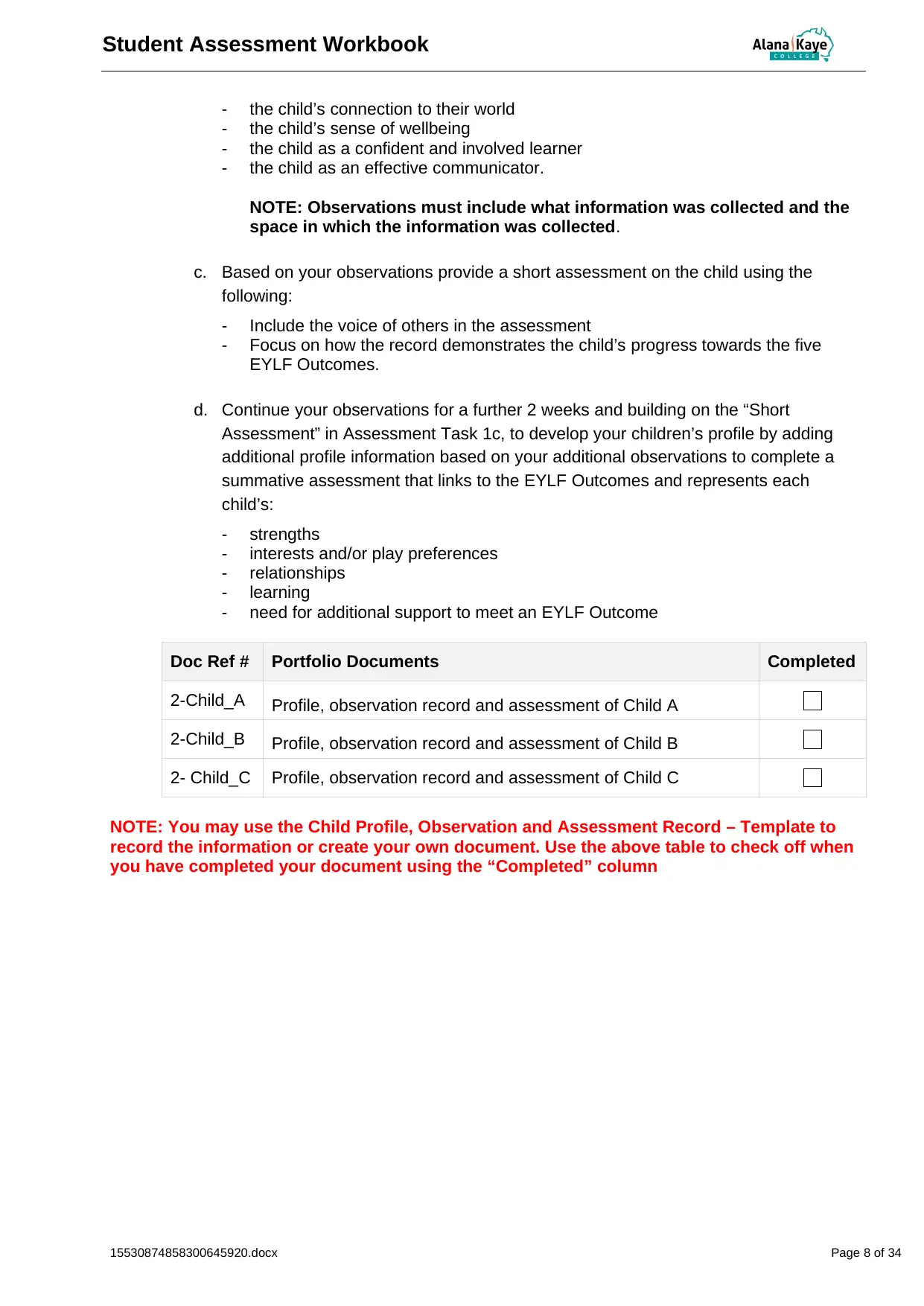
Student Assessment Workbook
- the child’s connection to their world
- the child’s sense of wellbeing
- the child as a confident and involved learner
- the child as an effective communicator.
NOTE: Observations must include what information was collected and the
space in which the information was collected.
c. Based on your observations provide a short assessment on the child using the
following:
- Include the voice of others in the assessment
- Focus on how the record demonstrates the child’s progress towards the five
EYLF Outcomes.
d. Continue your observations for a further 2 weeks and building on the “Short
Assessment” in Assessment Task 1c, to develop your children’s profile by adding
additional profile information based on your additional observations to complete a
summative assessment that links to the EYLF Outcomes and represents each
child’s:
- strengths
- interests and/or play preferences
- relationships
- learning
- need for additional support to meet an EYLF Outcome
Doc Ref # Portfolio Documents Completed
2-Child_A Profile, observation record and assessment of Child A
2-Child_B Profile, observation record and assessment of Child B
2- Child_C Profile, observation record and assessment of Child C
NOTE: You may use the Child Profile, Observation and Assessment Record – Template to
record the information or create your own document. Use the above table to check off when
you have completed your document using the “Completed” column
15530874858300645920.docx Page 8 of 34
- the child’s connection to their world
- the child’s sense of wellbeing
- the child as a confident and involved learner
- the child as an effective communicator.
NOTE: Observations must include what information was collected and the
space in which the information was collected.
c. Based on your observations provide a short assessment on the child using the
following:
- Include the voice of others in the assessment
- Focus on how the record demonstrates the child’s progress towards the five
EYLF Outcomes.
d. Continue your observations for a further 2 weeks and building on the “Short
Assessment” in Assessment Task 1c, to develop your children’s profile by adding
additional profile information based on your additional observations to complete a
summative assessment that links to the EYLF Outcomes and represents each
child’s:
- strengths
- interests and/or play preferences
- relationships
- learning
- need for additional support to meet an EYLF Outcome
Doc Ref # Portfolio Documents Completed
2-Child_A Profile, observation record and assessment of Child A
2-Child_B Profile, observation record and assessment of Child B
2- Child_C Profile, observation record and assessment of Child C
NOTE: You may use the Child Profile, Observation and Assessment Record – Template to
record the information or create your own document. Use the above table to check off when
you have completed your document using the “Completed” column
15530874858300645920.docx Page 8 of 34
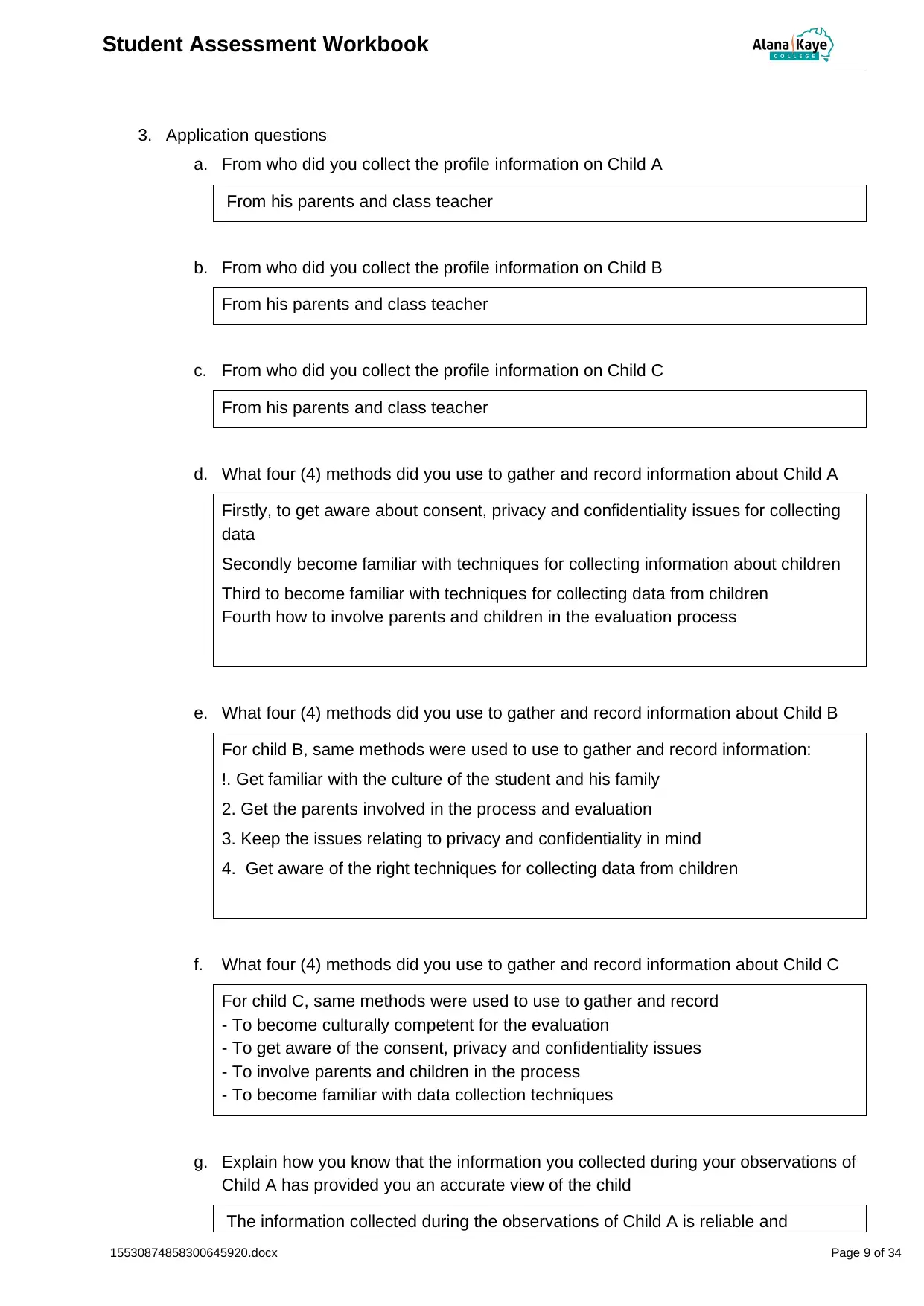
Student Assessment Workbook
3. Application questions
a. From who did you collect the profile information on Child A
From his parents and class teacher
b. From who did you collect the profile information on Child B
From his parents and class teacher
c. From who did you collect the profile information on Child C
From his parents and class teacher
d. What four (4) methods did you use to gather and record information about Child A
Firstly, to get aware about consent, privacy and confidentiality issues for collecting
data
Secondly become familiar with techniques for collecting information about children
Third to become familiar with techniques for collecting data from children
Fourth how to involve parents and children in the evaluation process
e. What four (4) methods did you use to gather and record information about Child B
For child B, same methods were used to use to gather and record information:
!. Get familiar with the culture of the student and his family
2. Get the parents involved in the process and evaluation
3. Keep the issues relating to privacy and confidentiality in mind
4. Get aware of the right techniques for collecting data from children
f. What four (4) methods did you use to gather and record information about Child C
For child C, same methods were used to use to gather and record
- To become culturally competent for the evaluation
- To get aware of the consent, privacy and confidentiality issues
- To involve parents and children in the process
- To become familiar with data collection techniques
g. Explain how you know that the information you collected during your observations of
Child A has provided you an accurate view of the child
The information collected during the observations of Child A is reliable and
15530874858300645920.docx Page 9 of 34
3. Application questions
a. From who did you collect the profile information on Child A
From his parents and class teacher
b. From who did you collect the profile information on Child B
From his parents and class teacher
c. From who did you collect the profile information on Child C
From his parents and class teacher
d. What four (4) methods did you use to gather and record information about Child A
Firstly, to get aware about consent, privacy and confidentiality issues for collecting
data
Secondly become familiar with techniques for collecting information about children
Third to become familiar with techniques for collecting data from children
Fourth how to involve parents and children in the evaluation process
e. What four (4) methods did you use to gather and record information about Child B
For child B, same methods were used to use to gather and record information:
!. Get familiar with the culture of the student and his family
2. Get the parents involved in the process and evaluation
3. Keep the issues relating to privacy and confidentiality in mind
4. Get aware of the right techniques for collecting data from children
f. What four (4) methods did you use to gather and record information about Child C
For child C, same methods were used to use to gather and record
- To become culturally competent for the evaluation
- To get aware of the consent, privacy and confidentiality issues
- To involve parents and children in the process
- To become familiar with data collection techniques
g. Explain how you know that the information you collected during your observations of
Child A has provided you an accurate view of the child
The information collected during the observations of Child A is reliable and
15530874858300645920.docx Page 9 of 34
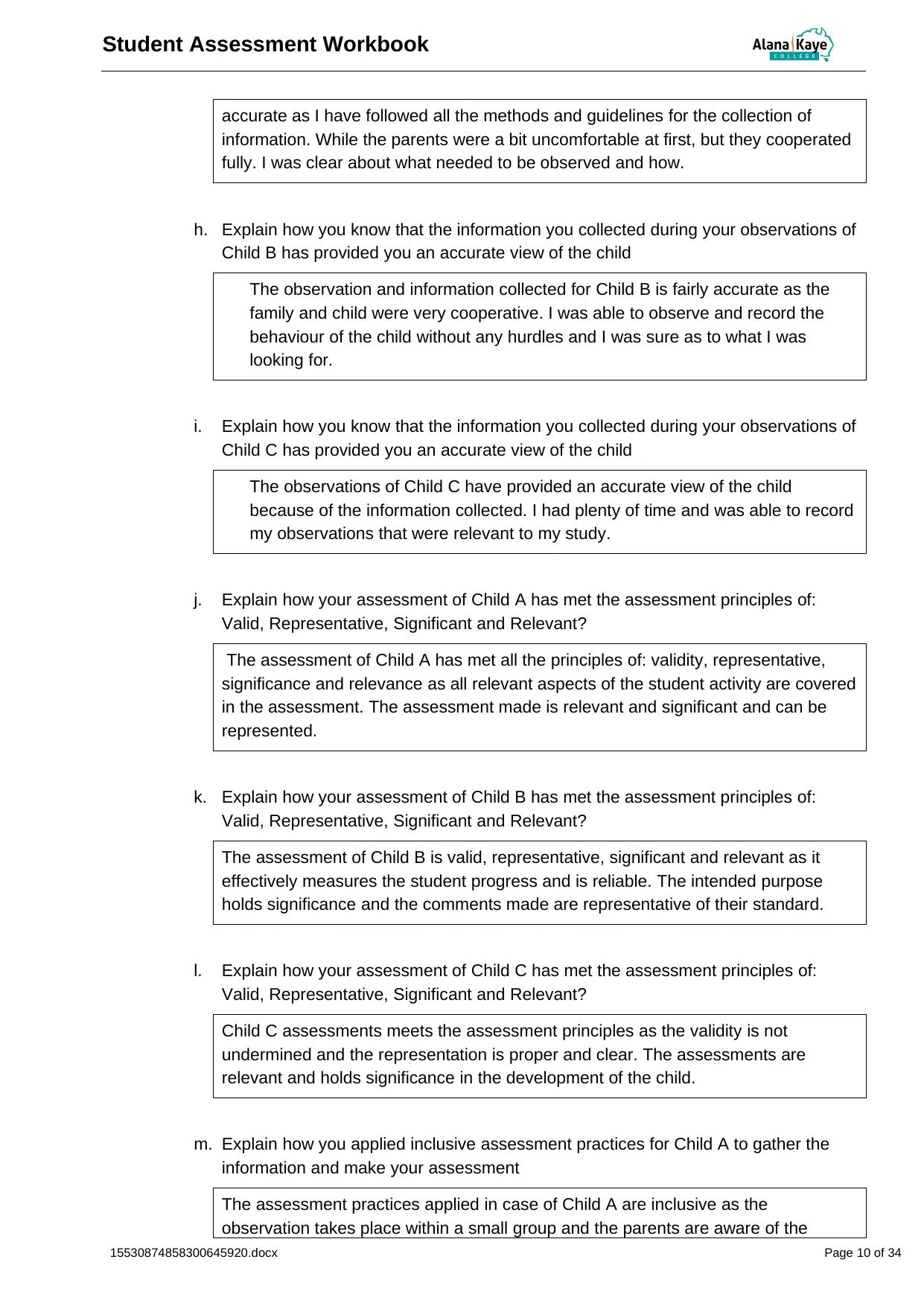
Student Assessment Workbook
accurate as I have followed all the methods and guidelines for the collection of
information. While the parents were a bit uncomfortable at first, but they cooperated
fully. I was clear about what needed to be observed and how.
h. Explain how you know that the information you collected during your observations of
Child B has provided you an accurate view of the child
The observation and information collected for Child B is fairly accurate as the
family and child were very cooperative. I was able to observe and record the
behaviour of the child without any hurdles and I was sure as to what I was
looking for.
i. Explain how you know that the information you collected during your observations of
Child C has provided you an accurate view of the child
The observations of Child C have provided an accurate view of the child
because of the information collected. I had plenty of time and was able to record
my observations that were relevant to my study.
j. Explain how your assessment of Child A has met the assessment principles of:
Valid, Representative, Significant and Relevant?
The assessment of Child A has met all the principles of: validity, representative,
significance and relevance as all relevant aspects of the student activity are covered
in the assessment. The assessment made is relevant and significant and can be
represented.
k. Explain how your assessment of Child B has met the assessment principles of:
Valid, Representative, Significant and Relevant?
The assessment of Child B is valid, representative, significant and relevant as it
effectively measures the student progress and is reliable. The intended purpose
holds significance and the comments made are representative of their standard.
l. Explain how your assessment of Child C has met the assessment principles of:
Valid, Representative, Significant and Relevant?
Child C assessments meets the assessment principles as the validity is not
undermined and the representation is proper and clear. The assessments are
relevant and holds significance in the development of the child.
m. Explain how you applied inclusive assessment practices for Child A to gather the
information and make your assessment
The assessment practices applied in case of Child A are inclusive as the
observation takes place within a small group and the parents are aware of the
15530874858300645920.docx Page 10 of 34
accurate as I have followed all the methods and guidelines for the collection of
information. While the parents were a bit uncomfortable at first, but they cooperated
fully. I was clear about what needed to be observed and how.
h. Explain how you know that the information you collected during your observations of
Child B has provided you an accurate view of the child
The observation and information collected for Child B is fairly accurate as the
family and child were very cooperative. I was able to observe and record the
behaviour of the child without any hurdles and I was sure as to what I was
looking for.
i. Explain how you know that the information you collected during your observations of
Child C has provided you an accurate view of the child
The observations of Child C have provided an accurate view of the child
because of the information collected. I had plenty of time and was able to record
my observations that were relevant to my study.
j. Explain how your assessment of Child A has met the assessment principles of:
Valid, Representative, Significant and Relevant?
The assessment of Child A has met all the principles of: validity, representative,
significance and relevance as all relevant aspects of the student activity are covered
in the assessment. The assessment made is relevant and significant and can be
represented.
k. Explain how your assessment of Child B has met the assessment principles of:
Valid, Representative, Significant and Relevant?
The assessment of Child B is valid, representative, significant and relevant as it
effectively measures the student progress and is reliable. The intended purpose
holds significance and the comments made are representative of their standard.
l. Explain how your assessment of Child C has met the assessment principles of:
Valid, Representative, Significant and Relevant?
Child C assessments meets the assessment principles as the validity is not
undermined and the representation is proper and clear. The assessments are
relevant and holds significance in the development of the child.
m. Explain how you applied inclusive assessment practices for Child A to gather the
information and make your assessment
The assessment practices applied in case of Child A are inclusive as the
observation takes place within a small group and the parents are aware of the
15530874858300645920.docx Page 10 of 34
Secure Best Marks with AI Grader
Need help grading? Try our AI Grader for instant feedback on your assignments.
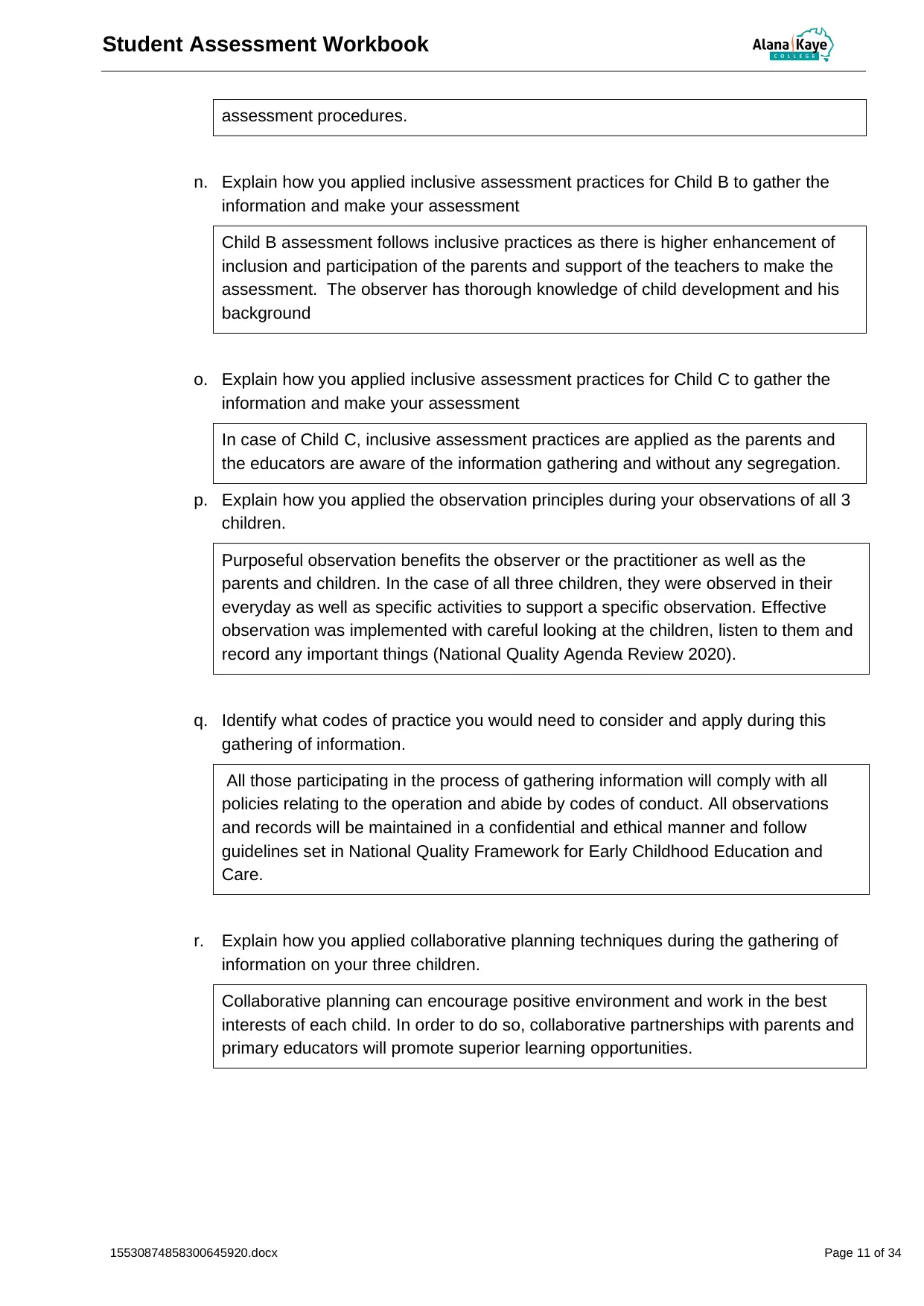
Student Assessment Workbook
assessment procedures.
n. Explain how you applied inclusive assessment practices for Child B to gather the
information and make your assessment
Child B assessment follows inclusive practices as there is higher enhancement of
inclusion and participation of the parents and support of the teachers to make the
assessment. The observer has thorough knowledge of child development and his
background
o. Explain how you applied inclusive assessment practices for Child C to gather the
information and make your assessment
In case of Child C, inclusive assessment practices are applied as the parents and
the educators are aware of the information gathering and without any segregation.
p. Explain how you applied the observation principles during your observations of all 3
children.
Purposeful observation benefits the observer or the practitioner as well as the
parents and children. In the case of all three children, they were observed in their
everyday as well as specific activities to support a specific observation. Effective
observation was implemented with careful looking at the children, listen to them and
record any important things (National Quality Agenda Review 2020).
q. Identify what codes of practice you would need to consider and apply during this
gathering of information.
All those participating in the process of gathering information will comply with all
policies relating to the operation and abide by codes of conduct. All observations
and records will be maintained in a confidential and ethical manner and follow
guidelines set in National Quality Framework for Early Childhood Education and
Care.
r. Explain how you applied collaborative planning techniques during the gathering of
information on your three children.
Collaborative planning can encourage positive environment and work in the best
interests of each child. In order to do so, collaborative partnerships with parents and
primary educators will promote superior learning opportunities.
15530874858300645920.docx Page 11 of 34
assessment procedures.
n. Explain how you applied inclusive assessment practices for Child B to gather the
information and make your assessment
Child B assessment follows inclusive practices as there is higher enhancement of
inclusion and participation of the parents and support of the teachers to make the
assessment. The observer has thorough knowledge of child development and his
background
o. Explain how you applied inclusive assessment practices for Child C to gather the
information and make your assessment
In case of Child C, inclusive assessment practices are applied as the parents and
the educators are aware of the information gathering and without any segregation.
p. Explain how you applied the observation principles during your observations of all 3
children.
Purposeful observation benefits the observer or the practitioner as well as the
parents and children. In the case of all three children, they were observed in their
everyday as well as specific activities to support a specific observation. Effective
observation was implemented with careful looking at the children, listen to them and
record any important things (National Quality Agenda Review 2020).
q. Identify what codes of practice you would need to consider and apply during this
gathering of information.
All those participating in the process of gathering information will comply with all
policies relating to the operation and abide by codes of conduct. All observations
and records will be maintained in a confidential and ethical manner and follow
guidelines set in National Quality Framework for Early Childhood Education and
Care.
r. Explain how you applied collaborative planning techniques during the gathering of
information on your three children.
Collaborative planning can encourage positive environment and work in the best
interests of each child. In order to do so, collaborative partnerships with parents and
primary educators will promote superior learning opportunities.
15530874858300645920.docx Page 11 of 34
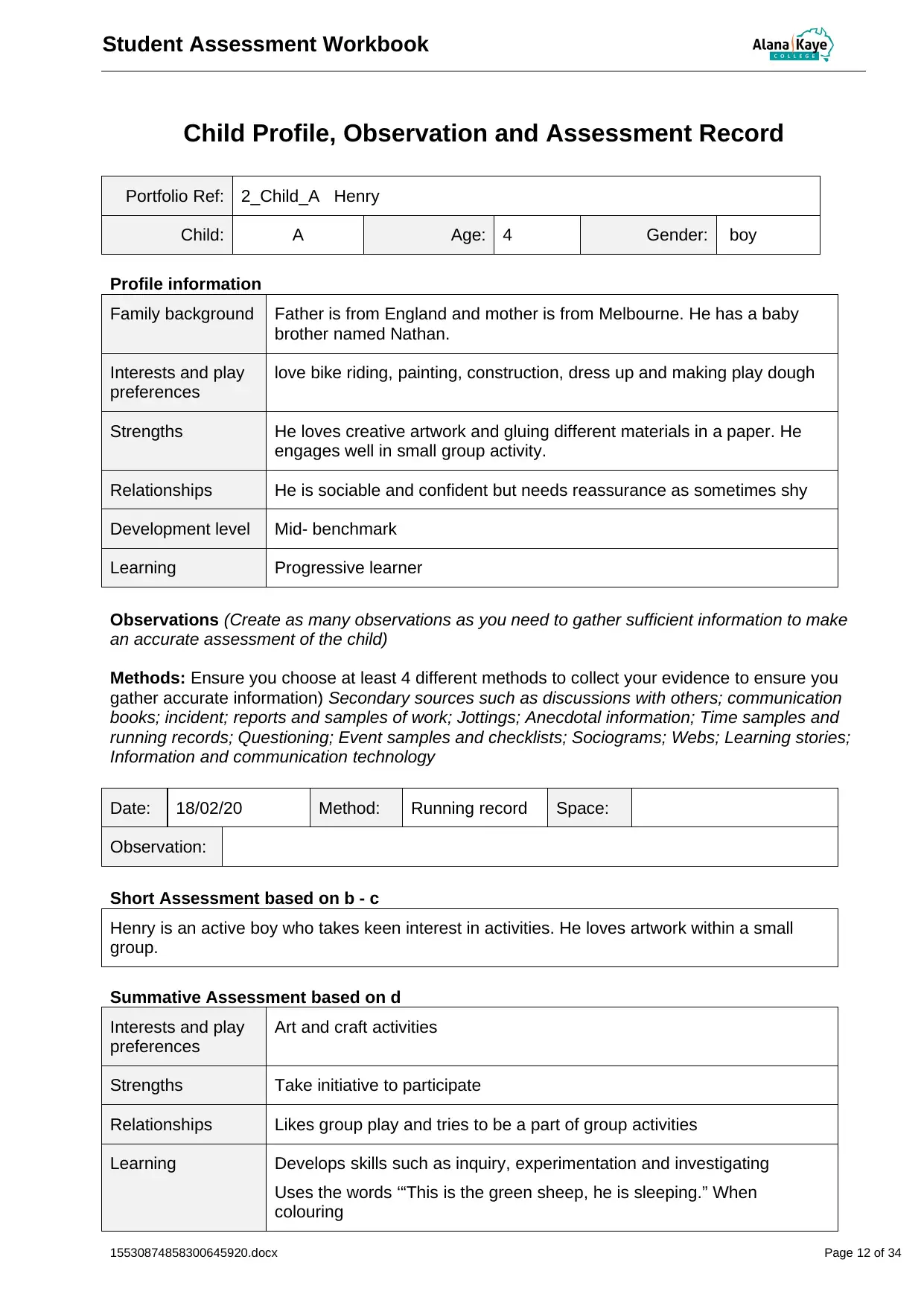
Student Assessment Workbook
Child Profile, Observation and Assessment Record
Portfolio Ref: 2_Child_A Henry
Child: A Age: 4 Gender: boy
Profile information
Family background Father is from England and mother is from Melbourne. He has a baby
brother named Nathan.
Interests and play
preferences
love bike riding, painting, construction, dress up and making play dough
Strengths He loves creative artwork and gluing different materials in a paper. He
engages well in small group activity.
Relationships He is sociable and confident but needs reassurance as sometimes shy
Development level Mid- benchmark
Learning Progressive learner
Observations (Create as many observations as you need to gather sufficient information to make
an accurate assessment of the child)
Methods: Ensure you choose at least 4 different methods to collect your evidence to ensure you
gather accurate information) Secondary sources such as discussions with others; communication
books; incident; reports and samples of work; Jottings; Anecdotal information; Time samples and
running records; Questioning; Event samples and checklists; Sociograms; Webs; Learning stories;
Information and communication technology
Date: 18/02/20 Method: Running record Space:
Observation:
Short Assessment based on b - c
Henry is an active boy who takes keen interest in activities. He loves artwork within a small
group.
Summative Assessment based on d
Interests and play
preferences
Art and craft activities
Strengths Take initiative to participate
Relationships Likes group play and tries to be a part of group activities
Learning Develops skills such as inquiry, experimentation and investigating
Uses the words ‘“This is the green sheep, he is sleeping.” When
colouring
15530874858300645920.docx Page 12 of 34
Child Profile, Observation and Assessment Record
Portfolio Ref: 2_Child_A Henry
Child: A Age: 4 Gender: boy
Profile information
Family background Father is from England and mother is from Melbourne. He has a baby
brother named Nathan.
Interests and play
preferences
love bike riding, painting, construction, dress up and making play dough
Strengths He loves creative artwork and gluing different materials in a paper. He
engages well in small group activity.
Relationships He is sociable and confident but needs reassurance as sometimes shy
Development level Mid- benchmark
Learning Progressive learner
Observations (Create as many observations as you need to gather sufficient information to make
an accurate assessment of the child)
Methods: Ensure you choose at least 4 different methods to collect your evidence to ensure you
gather accurate information) Secondary sources such as discussions with others; communication
books; incident; reports and samples of work; Jottings; Anecdotal information; Time samples and
running records; Questioning; Event samples and checklists; Sociograms; Webs; Learning stories;
Information and communication technology
Date: 18/02/20 Method: Running record Space:
Observation:
Short Assessment based on b - c
Henry is an active boy who takes keen interest in activities. He loves artwork within a small
group.
Summative Assessment based on d
Interests and play
preferences
Art and craft activities
Strengths Take initiative to participate
Relationships Likes group play and tries to be a part of group activities
Learning Develops skills such as inquiry, experimentation and investigating
Uses the words ‘“This is the green sheep, he is sleeping.” When
colouring
15530874858300645920.docx Page 12 of 34
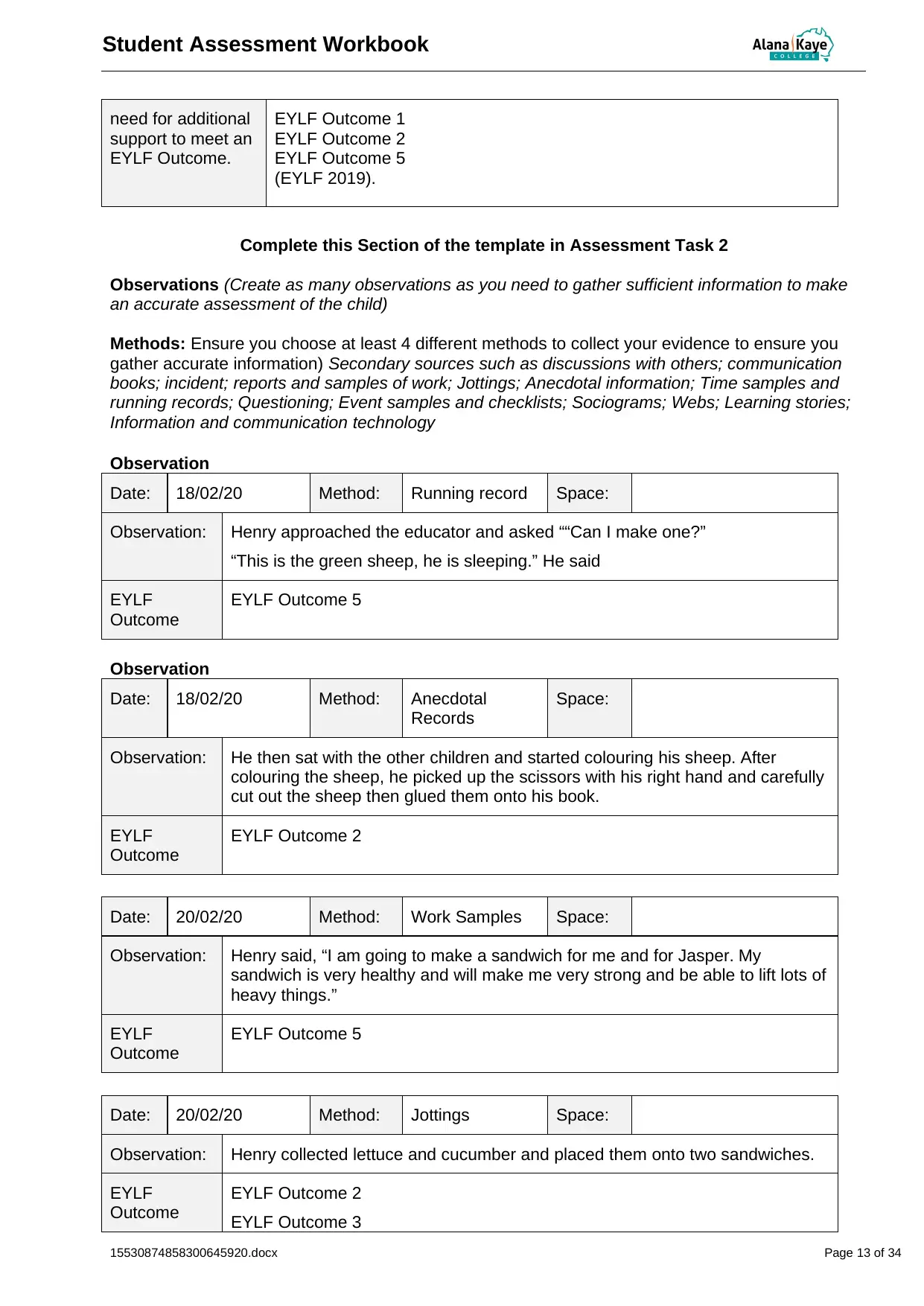
Student Assessment Workbook
need for additional
support to meet an
EYLF Outcome.
EYLF Outcome 1
EYLF Outcome 2
EYLF Outcome 5
(EYLF 2019).
Complete this Section of the template in Assessment Task 2
Observations (Create as many observations as you need to gather sufficient information to make
an accurate assessment of the child)
Methods: Ensure you choose at least 4 different methods to collect your evidence to ensure you
gather accurate information) Secondary sources such as discussions with others; communication
books; incident; reports and samples of work; Jottings; Anecdotal information; Time samples and
running records; Questioning; Event samples and checklists; Sociograms; Webs; Learning stories;
Information and communication technology
Observation
Date: 18/02/20 Method: Running record Space:
Observation: Henry approached the educator and asked ““Can I make one?”
“This is the green sheep, he is sleeping.” He said
EYLF
Outcome
EYLF Outcome 5
Observation
Date: 18/02/20 Method: Anecdotal
Records
Space:
Observation: He then sat with the other children and started colouring his sheep. After
colouring the sheep, he picked up the scissors with his right hand and carefully
cut out the sheep then glued them onto his book.
EYLF
Outcome
EYLF Outcome 2
Date: 20/02/20 Method: Work Samples Space:
Observation: Henry said, “I am going to make a sandwich for me and for Jasper. My
sandwich is very healthy and will make me very strong and be able to lift lots of
heavy things.”
EYLF
Outcome
EYLF Outcome 5
Date: 20/02/20 Method: Jottings Space:
Observation: Henry collected lettuce and cucumber and placed them onto two sandwiches.
EYLF
Outcome
EYLF Outcome 2
EYLF Outcome 3
15530874858300645920.docx Page 13 of 34
need for additional
support to meet an
EYLF Outcome.
EYLF Outcome 1
EYLF Outcome 2
EYLF Outcome 5
(EYLF 2019).
Complete this Section of the template in Assessment Task 2
Observations (Create as many observations as you need to gather sufficient information to make
an accurate assessment of the child)
Methods: Ensure you choose at least 4 different methods to collect your evidence to ensure you
gather accurate information) Secondary sources such as discussions with others; communication
books; incident; reports and samples of work; Jottings; Anecdotal information; Time samples and
running records; Questioning; Event samples and checklists; Sociograms; Webs; Learning stories;
Information and communication technology
Observation
Date: 18/02/20 Method: Running record Space:
Observation: Henry approached the educator and asked ““Can I make one?”
“This is the green sheep, he is sleeping.” He said
EYLF
Outcome
EYLF Outcome 5
Observation
Date: 18/02/20 Method: Anecdotal
Records
Space:
Observation: He then sat with the other children and started colouring his sheep. After
colouring the sheep, he picked up the scissors with his right hand and carefully
cut out the sheep then glued them onto his book.
EYLF
Outcome
EYLF Outcome 2
Date: 20/02/20 Method: Work Samples Space:
Observation: Henry said, “I am going to make a sandwich for me and for Jasper. My
sandwich is very healthy and will make me very strong and be able to lift lots of
heavy things.”
EYLF
Outcome
EYLF Outcome 5
Date: 20/02/20 Method: Jottings Space:
Observation: Henry collected lettuce and cucumber and placed them onto two sandwiches.
EYLF
Outcome
EYLF Outcome 2
EYLF Outcome 3
15530874858300645920.docx Page 13 of 34
Paraphrase This Document
Need a fresh take? Get an instant paraphrase of this document with our AI Paraphraser
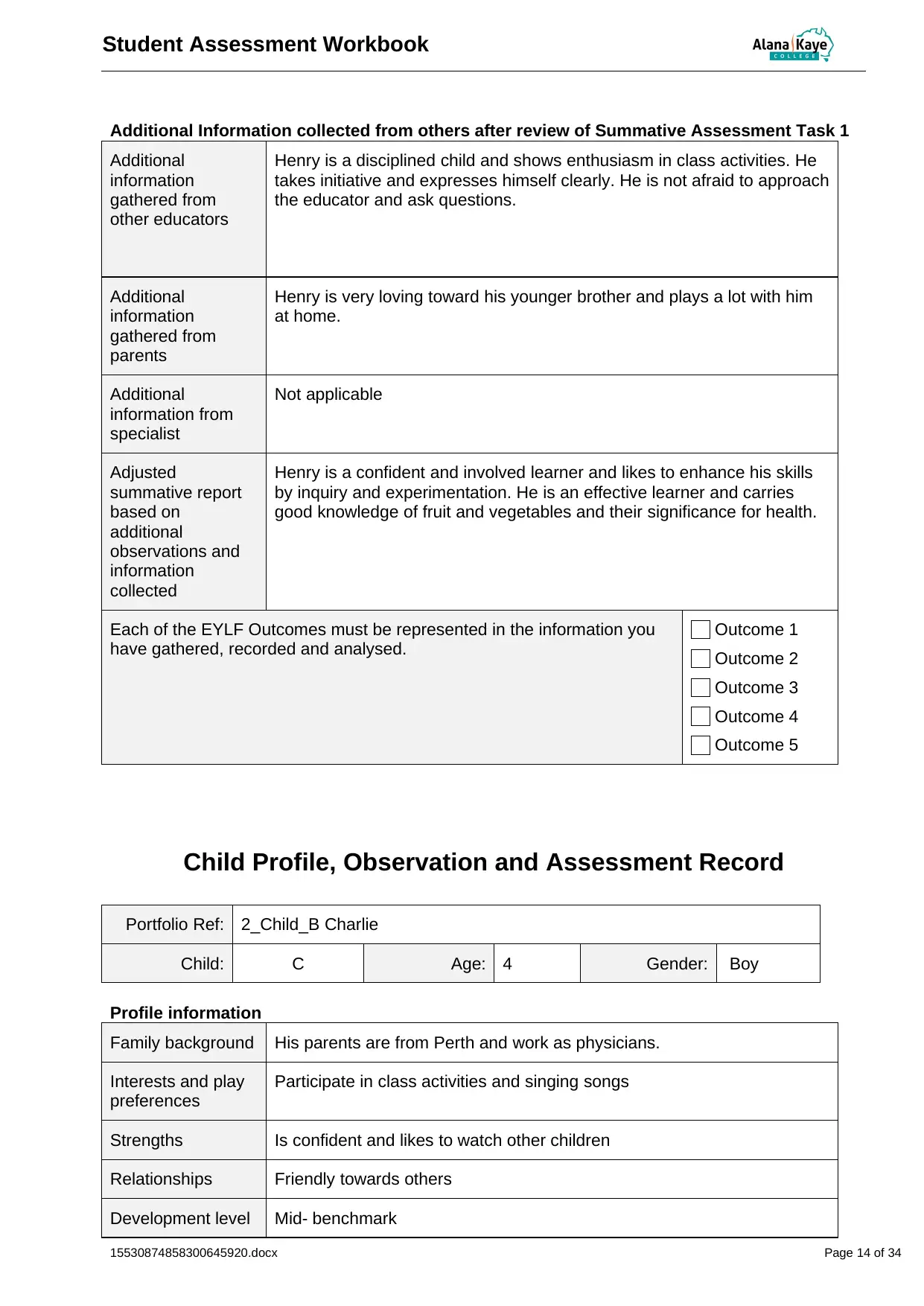
Student Assessment Workbook
Additional Information collected from others after review of Summative Assessment Task 1
Additional
information
gathered from
other educators
Henry is a disciplined child and shows enthusiasm in class activities. He
takes initiative and expresses himself clearly. He is not afraid to approach
the educator and ask questions.
Additional
information
gathered from
parents
Henry is very loving toward his younger brother and plays a lot with him
at home.
Additional
information from
specialist
Not applicable
Adjusted
summative report
based on
additional
observations and
information
collected
Henry is a confident and involved learner and likes to enhance his skills
by inquiry and experimentation. He is an effective learner and carries
good knowledge of fruit and vegetables and their significance for health.
Each of the EYLF Outcomes must be represented in the information you
have gathered, recorded and analysed.
Outcome 1
Outcome 2
Outcome 3
Outcome 4
Outcome 5
Child Profile, Observation and Assessment Record
Portfolio Ref: 2_Child_B Charlie
Child: C Age: 4 Gender: Boy
Profile information
Family background His parents are from Perth and work as physicians.
Interests and play
preferences
Participate in class activities and singing songs
Strengths Is confident and likes to watch other children
Relationships Friendly towards others
Development level Mid- benchmark
15530874858300645920.docx Page 14 of 34
Additional Information collected from others after review of Summative Assessment Task 1
Additional
information
gathered from
other educators
Henry is a disciplined child and shows enthusiasm in class activities. He
takes initiative and expresses himself clearly. He is not afraid to approach
the educator and ask questions.
Additional
information
gathered from
parents
Henry is very loving toward his younger brother and plays a lot with him
at home.
Additional
information from
specialist
Not applicable
Adjusted
summative report
based on
additional
observations and
information
collected
Henry is a confident and involved learner and likes to enhance his skills
by inquiry and experimentation. He is an effective learner and carries
good knowledge of fruit and vegetables and their significance for health.
Each of the EYLF Outcomes must be represented in the information you
have gathered, recorded and analysed.
Outcome 1
Outcome 2
Outcome 3
Outcome 4
Outcome 5
Child Profile, Observation and Assessment Record
Portfolio Ref: 2_Child_B Charlie
Child: C Age: 4 Gender: Boy
Profile information
Family background His parents are from Perth and work as physicians.
Interests and play
preferences
Participate in class activities and singing songs
Strengths Is confident and likes to watch other children
Relationships Friendly towards others
Development level Mid- benchmark
15530874858300645920.docx Page 14 of 34
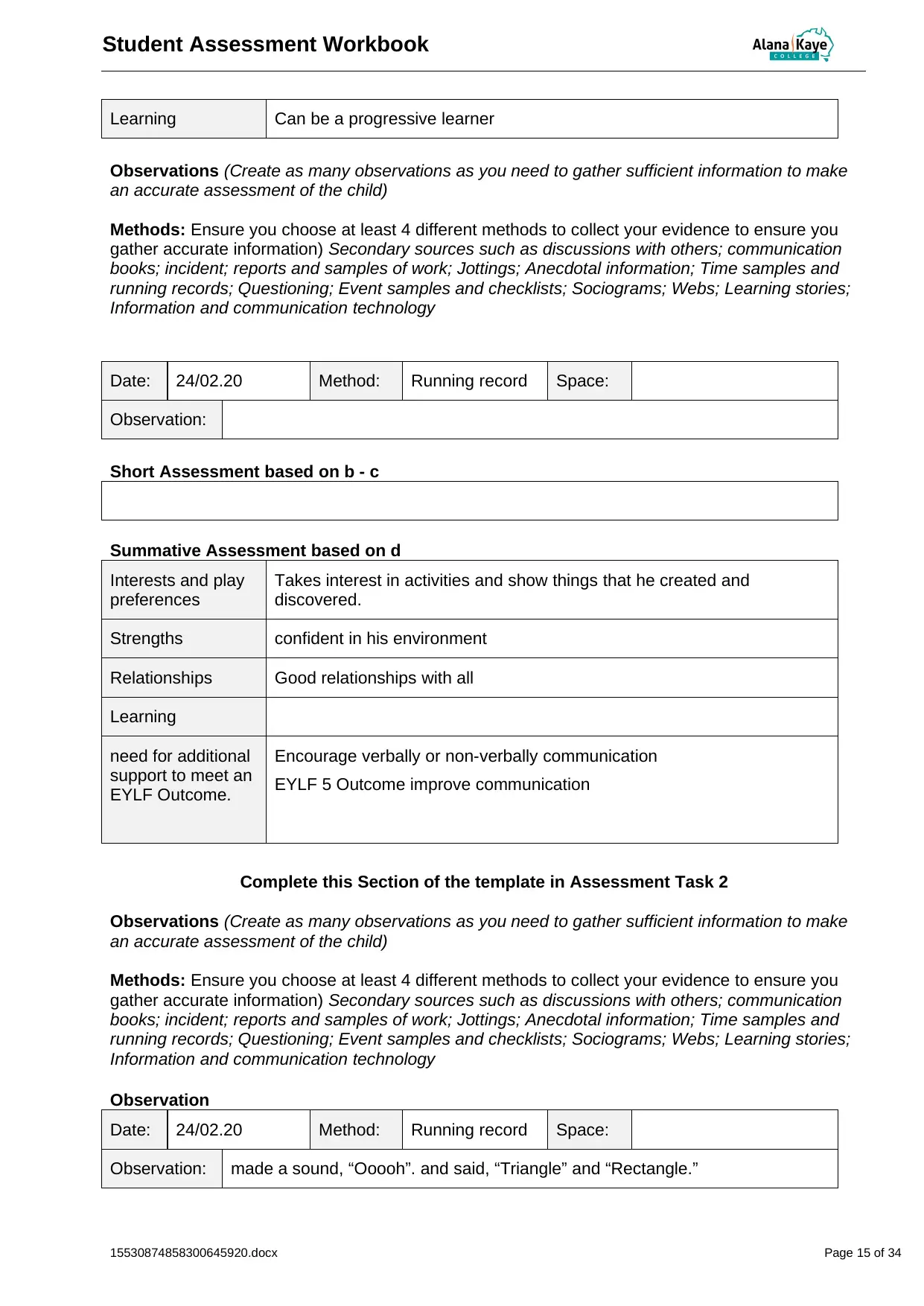
Student Assessment Workbook
Learning Can be a progressive learner
Observations (Create as many observations as you need to gather sufficient information to make
an accurate assessment of the child)
Methods: Ensure you choose at least 4 different methods to collect your evidence to ensure you
gather accurate information) Secondary sources such as discussions with others; communication
books; incident; reports and samples of work; Jottings; Anecdotal information; Time samples and
running records; Questioning; Event samples and checklists; Sociograms; Webs; Learning stories;
Information and communication technology
Date: 24/02.20 Method: Running record Space:
Observation:
Short Assessment based on b - c
Summative Assessment based on d
Interests and play
preferences
Takes interest in activities and show things that he created and
discovered.
Strengths confident in his environment
Relationships Good relationships with all
Learning
need for additional
support to meet an
EYLF Outcome.
Encourage verbally or non-verbally communication
EYLF 5 Outcome improve communication
Complete this Section of the template in Assessment Task 2
Observations (Create as many observations as you need to gather sufficient information to make
an accurate assessment of the child)
Methods: Ensure you choose at least 4 different methods to collect your evidence to ensure you
gather accurate information) Secondary sources such as discussions with others; communication
books; incident; reports and samples of work; Jottings; Anecdotal information; Time samples and
running records; Questioning; Event samples and checklists; Sociograms; Webs; Learning stories;
Information and communication technology
Observation
Date: 24/02.20 Method: Running record Space:
Observation: made a sound, “Ooooh”. and said, “Triangle” and “Rectangle.”
15530874858300645920.docx Page 15 of 34
Learning Can be a progressive learner
Observations (Create as many observations as you need to gather sufficient information to make
an accurate assessment of the child)
Methods: Ensure you choose at least 4 different methods to collect your evidence to ensure you
gather accurate information) Secondary sources such as discussions with others; communication
books; incident; reports and samples of work; Jottings; Anecdotal information; Time samples and
running records; Questioning; Event samples and checklists; Sociograms; Webs; Learning stories;
Information and communication technology
Date: 24/02.20 Method: Running record Space:
Observation:
Short Assessment based on b - c
Summative Assessment based on d
Interests and play
preferences
Takes interest in activities and show things that he created and
discovered.
Strengths confident in his environment
Relationships Good relationships with all
Learning
need for additional
support to meet an
EYLF Outcome.
Encourage verbally or non-verbally communication
EYLF 5 Outcome improve communication
Complete this Section of the template in Assessment Task 2
Observations (Create as many observations as you need to gather sufficient information to make
an accurate assessment of the child)
Methods: Ensure you choose at least 4 different methods to collect your evidence to ensure you
gather accurate information) Secondary sources such as discussions with others; communication
books; incident; reports and samples of work; Jottings; Anecdotal information; Time samples and
running records; Questioning; Event samples and checklists; Sociograms; Webs; Learning stories;
Information and communication technology
Observation
Date: 24/02.20 Method: Running record Space:
Observation: made a sound, “Ooooh”. and said, “Triangle” and “Rectangle.”
15530874858300645920.docx Page 15 of 34
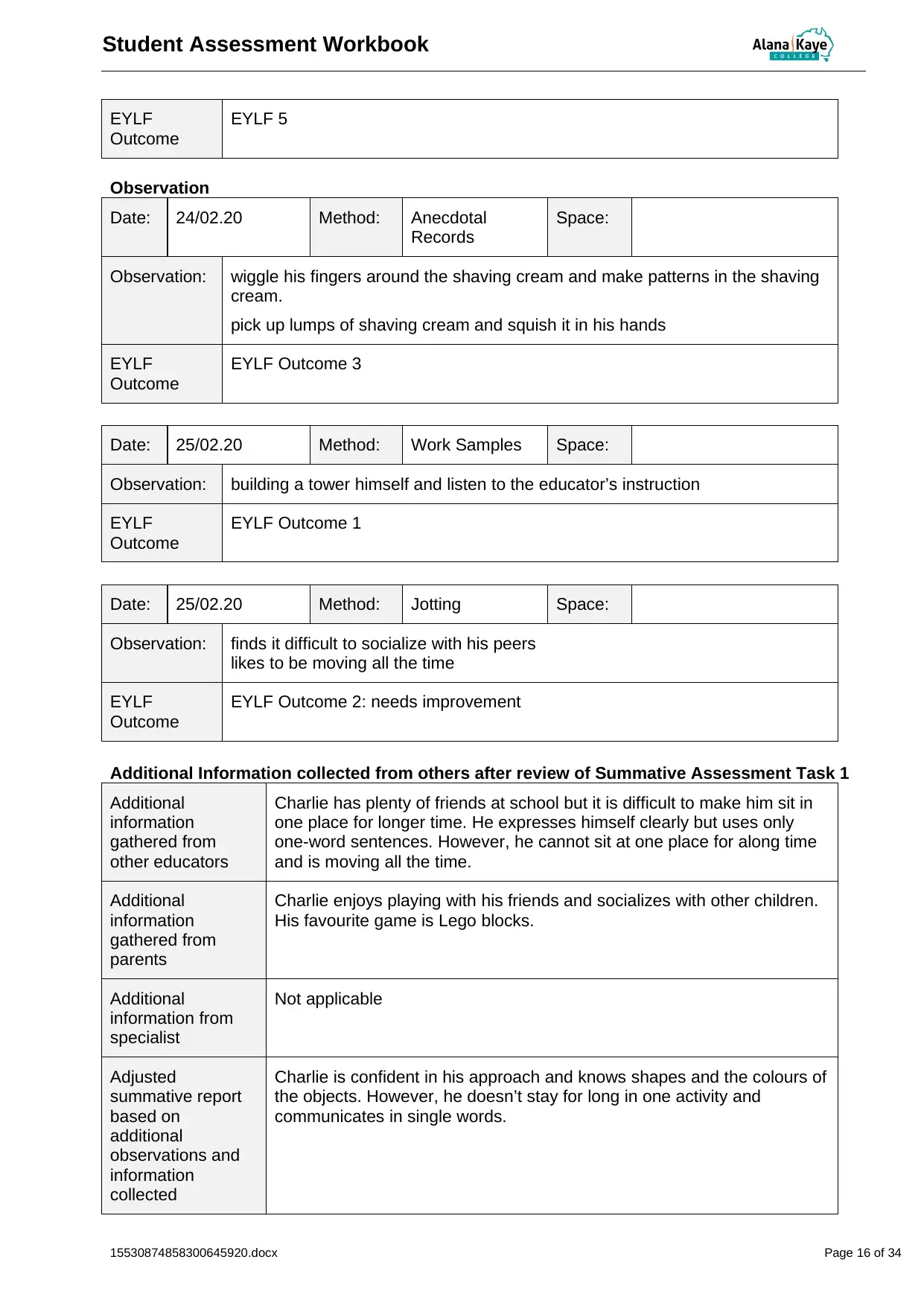
Student Assessment Workbook
EYLF
Outcome
EYLF 5
Observation
Date: 24/02.20 Method: Anecdotal
Records
Space:
Observation: wiggle his fingers around the shaving cream and make patterns in the shaving
cream.
pick up lumps of shaving cream and squish it in his hands
EYLF
Outcome
EYLF Outcome 3
Date: 25/02.20 Method: Work Samples Space:
Observation: building a tower himself and listen to the educator’s instruction
EYLF
Outcome
EYLF Outcome 1
Date: 25/02.20 Method: Jotting Space:
Observation: finds it difficult to socialize with his peers
likes to be moving all the time
EYLF
Outcome
EYLF Outcome 2: needs improvement
Additional Information collected from others after review of Summative Assessment Task 1
Additional
information
gathered from
other educators
Charlie has plenty of friends at school but it is difficult to make him sit in
one place for longer time. He expresses himself clearly but uses only
one-word sentences. However, he cannot sit at one place for along time
and is moving all the time.
Additional
information
gathered from
parents
Charlie enjoys playing with his friends and socializes with other children.
His favourite game is Lego blocks.
Additional
information from
specialist
Not applicable
Adjusted
summative report
based on
additional
observations and
information
collected
Charlie is confident in his approach and knows shapes and the colours of
the objects. However, he doesn’t stay for long in one activity and
communicates in single words.
15530874858300645920.docx Page 16 of 34
EYLF
Outcome
EYLF 5
Observation
Date: 24/02.20 Method: Anecdotal
Records
Space:
Observation: wiggle his fingers around the shaving cream and make patterns in the shaving
cream.
pick up lumps of shaving cream and squish it in his hands
EYLF
Outcome
EYLF Outcome 3
Date: 25/02.20 Method: Work Samples Space:
Observation: building a tower himself and listen to the educator’s instruction
EYLF
Outcome
EYLF Outcome 1
Date: 25/02.20 Method: Jotting Space:
Observation: finds it difficult to socialize with his peers
likes to be moving all the time
EYLF
Outcome
EYLF Outcome 2: needs improvement
Additional Information collected from others after review of Summative Assessment Task 1
Additional
information
gathered from
other educators
Charlie has plenty of friends at school but it is difficult to make him sit in
one place for longer time. He expresses himself clearly but uses only
one-word sentences. However, he cannot sit at one place for along time
and is moving all the time.
Additional
information
gathered from
parents
Charlie enjoys playing with his friends and socializes with other children.
His favourite game is Lego blocks.
Additional
information from
specialist
Not applicable
Adjusted
summative report
based on
additional
observations and
information
collected
Charlie is confident in his approach and knows shapes and the colours of
the objects. However, he doesn’t stay for long in one activity and
communicates in single words.
15530874858300645920.docx Page 16 of 34
Secure Best Marks with AI Grader
Need help grading? Try our AI Grader for instant feedback on your assignments.
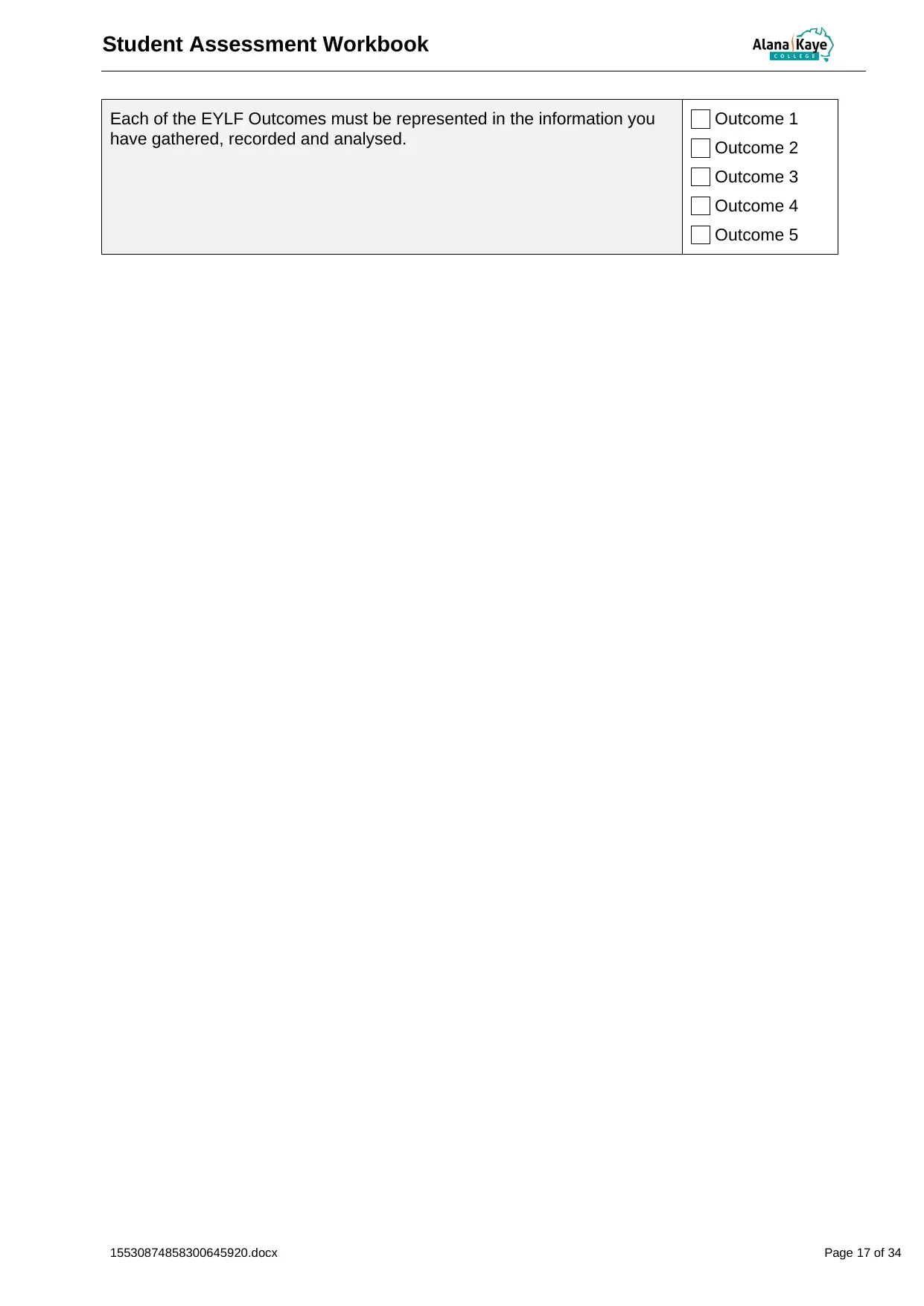
Student Assessment Workbook
Each of the EYLF Outcomes must be represented in the information you
have gathered, recorded and analysed.
Outcome 1
Outcome 2
Outcome 3
Outcome 4
Outcome 5
15530874858300645920.docx Page 17 of 34
Each of the EYLF Outcomes must be represented in the information you
have gathered, recorded and analysed.
Outcome 1
Outcome 2
Outcome 3
Outcome 4
Outcome 5
15530874858300645920.docx Page 17 of 34
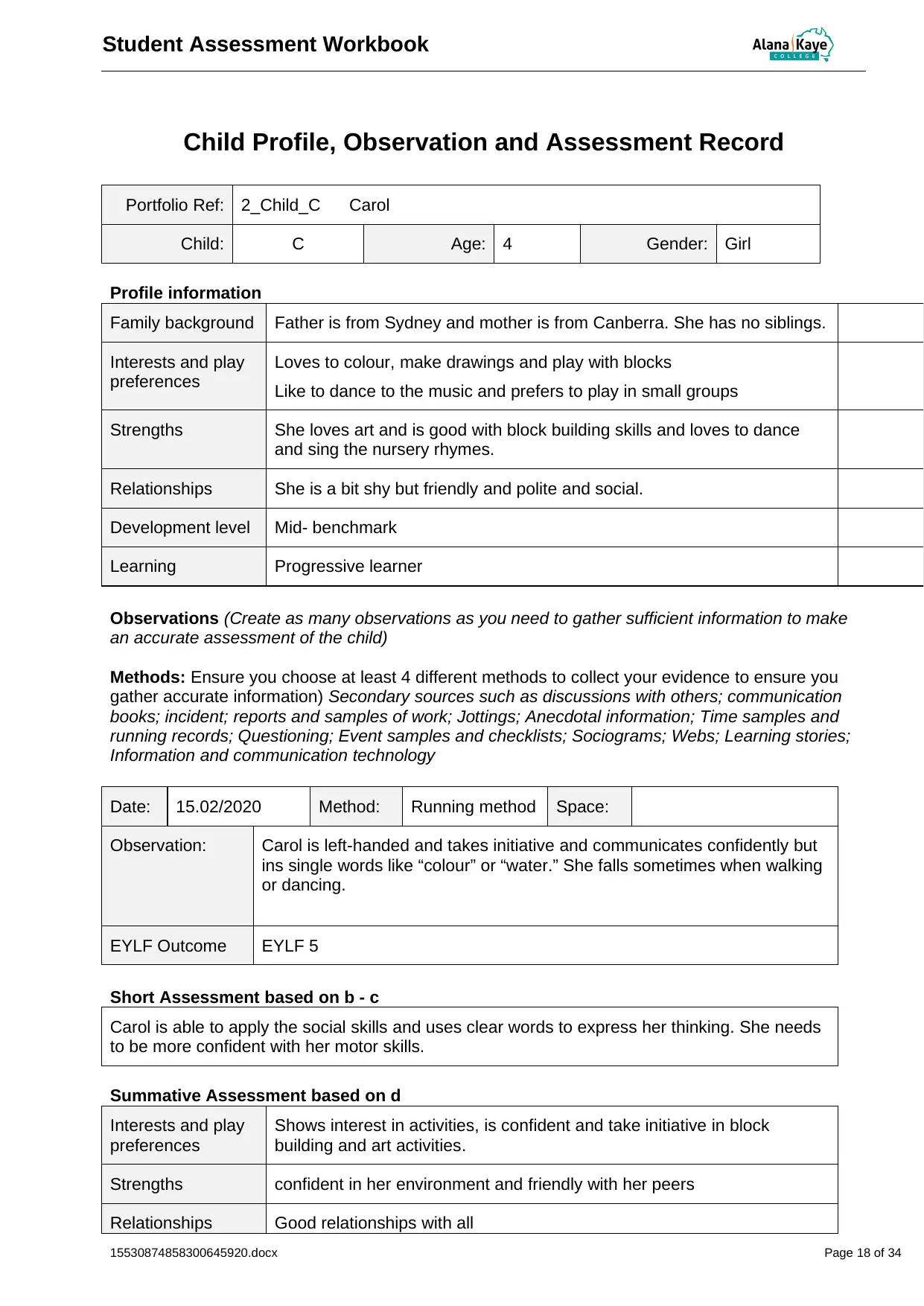
Student Assessment Workbook
Child Profile, Observation and Assessment Record
Portfolio Ref: 2_Child_C Carol
Child: C Age: 4 Gender: Girl
Profile information
Family background Father is from Sydney and mother is from Canberra. She has no siblings.
Interests and play
preferences
Loves to colour, make drawings and play with blocks
Like to dance to the music and prefers to play in small groups
Strengths She loves art and is good with block building skills and loves to dance
and sing the nursery rhymes.
Relationships She is a bit shy but friendly and polite and social.
Development level Mid- benchmark
Learning Progressive learner
Observations (Create as many observations as you need to gather sufficient information to make
an accurate assessment of the child)
Methods: Ensure you choose at least 4 different methods to collect your evidence to ensure you
gather accurate information) Secondary sources such as discussions with others; communication
books; incident; reports and samples of work; Jottings; Anecdotal information; Time samples and
running records; Questioning; Event samples and checklists; Sociograms; Webs; Learning stories;
Information and communication technology
Date: 15.02/2020 Method: Running method Space:
Observation: Carol is left-handed and takes initiative and communicates confidently but
ins single words like “colour” or “water.” She falls sometimes when walking
or dancing.
EYLF Outcome EYLF 5
Short Assessment based on b - c
Carol is able to apply the social skills and uses clear words to express her thinking. She needs
to be more confident with her motor skills.
Summative Assessment based on d
Interests and play
preferences
Shows interest in activities, is confident and take initiative in block
building and art activities.
Strengths confident in her environment and friendly with her peers
Relationships Good relationships with all
15530874858300645920.docx Page 18 of 34
Child Profile, Observation and Assessment Record
Portfolio Ref: 2_Child_C Carol
Child: C Age: 4 Gender: Girl
Profile information
Family background Father is from Sydney and mother is from Canberra. She has no siblings.
Interests and play
preferences
Loves to colour, make drawings and play with blocks
Like to dance to the music and prefers to play in small groups
Strengths She loves art and is good with block building skills and loves to dance
and sing the nursery rhymes.
Relationships She is a bit shy but friendly and polite and social.
Development level Mid- benchmark
Learning Progressive learner
Observations (Create as many observations as you need to gather sufficient information to make
an accurate assessment of the child)
Methods: Ensure you choose at least 4 different methods to collect your evidence to ensure you
gather accurate information) Secondary sources such as discussions with others; communication
books; incident; reports and samples of work; Jottings; Anecdotal information; Time samples and
running records; Questioning; Event samples and checklists; Sociograms; Webs; Learning stories;
Information and communication technology
Date: 15.02/2020 Method: Running method Space:
Observation: Carol is left-handed and takes initiative and communicates confidently but
ins single words like “colour” or “water.” She falls sometimes when walking
or dancing.
EYLF Outcome EYLF 5
Short Assessment based on b - c
Carol is able to apply the social skills and uses clear words to express her thinking. She needs
to be more confident with her motor skills.
Summative Assessment based on d
Interests and play
preferences
Shows interest in activities, is confident and take initiative in block
building and art activities.
Strengths confident in her environment and friendly with her peers
Relationships Good relationships with all
15530874858300645920.docx Page 18 of 34
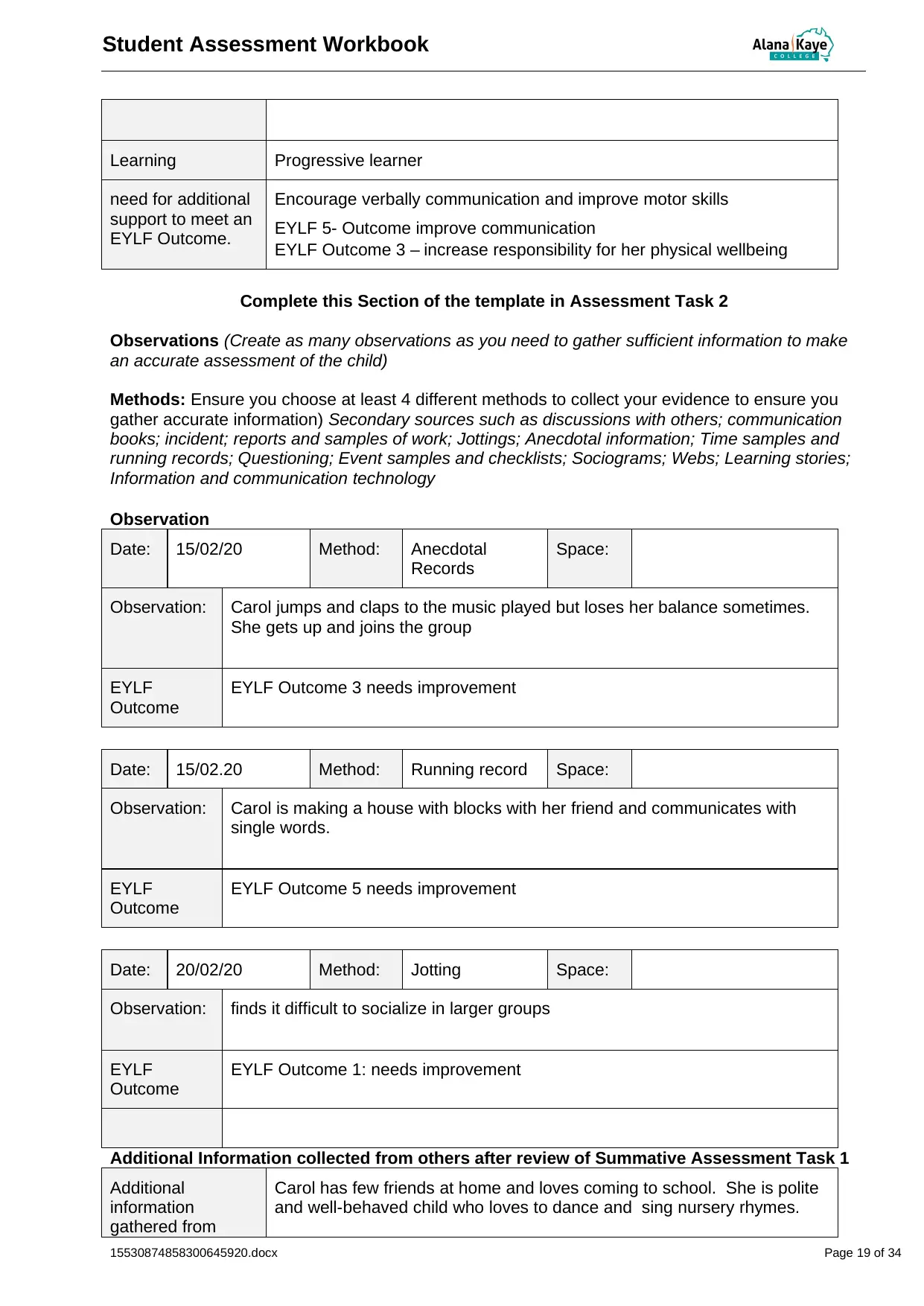
Student Assessment Workbook
Learning Progressive learner
need for additional
support to meet an
EYLF Outcome.
Encourage verbally communication and improve motor skills
EYLF 5- Outcome improve communication
EYLF Outcome 3 – increase responsibility for her physical wellbeing
Complete this Section of the template in Assessment Task 2
Observations (Create as many observations as you need to gather sufficient information to make
an accurate assessment of the child)
Methods: Ensure you choose at least 4 different methods to collect your evidence to ensure you
gather accurate information) Secondary sources such as discussions with others; communication
books; incident; reports and samples of work; Jottings; Anecdotal information; Time samples and
running records; Questioning; Event samples and checklists; Sociograms; Webs; Learning stories;
Information and communication technology
Observation
Date: 15/02/20 Method: Anecdotal
Records
Space:
Observation: Carol jumps and claps to the music played but loses her balance sometimes.
She gets up and joins the group
EYLF
Outcome
EYLF Outcome 3 needs improvement
Date: 15/02.20 Method: Running record Space:
Observation: Carol is making a house with blocks with her friend and communicates with
single words.
EYLF
Outcome
EYLF Outcome 5 needs improvement
Date: 20/02/20 Method: Jotting Space:
Observation: finds it difficult to socialize in larger groups
EYLF
Outcome
EYLF Outcome 1: needs improvement
Additional Information collected from others after review of Summative Assessment Task 1
Additional
information
gathered from
Carol has few friends at home and loves coming to school. She is polite
and well-behaved child who loves to dance and sing nursery rhymes.
15530874858300645920.docx Page 19 of 34
Learning Progressive learner
need for additional
support to meet an
EYLF Outcome.
Encourage verbally communication and improve motor skills
EYLF 5- Outcome improve communication
EYLF Outcome 3 – increase responsibility for her physical wellbeing
Complete this Section of the template in Assessment Task 2
Observations (Create as many observations as you need to gather sufficient information to make
an accurate assessment of the child)
Methods: Ensure you choose at least 4 different methods to collect your evidence to ensure you
gather accurate information) Secondary sources such as discussions with others; communication
books; incident; reports and samples of work; Jottings; Anecdotal information; Time samples and
running records; Questioning; Event samples and checklists; Sociograms; Webs; Learning stories;
Information and communication technology
Observation
Date: 15/02/20 Method: Anecdotal
Records
Space:
Observation: Carol jumps and claps to the music played but loses her balance sometimes.
She gets up and joins the group
EYLF
Outcome
EYLF Outcome 3 needs improvement
Date: 15/02.20 Method: Running record Space:
Observation: Carol is making a house with blocks with her friend and communicates with
single words.
EYLF
Outcome
EYLF Outcome 5 needs improvement
Date: 20/02/20 Method: Jotting Space:
Observation: finds it difficult to socialize in larger groups
EYLF
Outcome
EYLF Outcome 1: needs improvement
Additional Information collected from others after review of Summative Assessment Task 1
Additional
information
gathered from
Carol has few friends at home and loves coming to school. She is polite
and well-behaved child who loves to dance and sing nursery rhymes.
15530874858300645920.docx Page 19 of 34
Paraphrase This Document
Need a fresh take? Get an instant paraphrase of this document with our AI Paraphraser
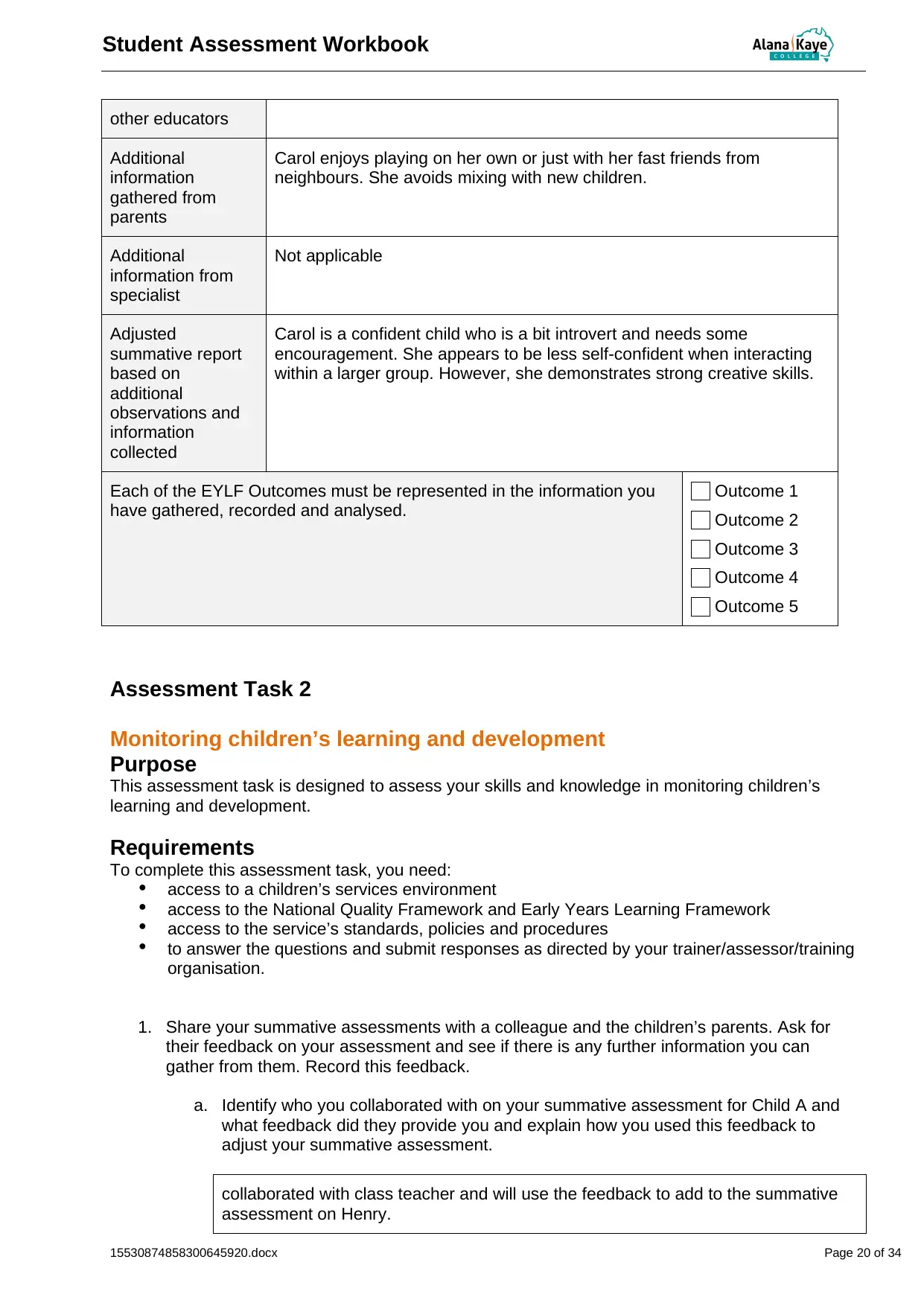
Student Assessment Workbook
other educators
Additional
information
gathered from
parents
Carol enjoys playing on her own or just with her fast friends from
neighbours. She avoids mixing with new children.
Additional
information from
specialist
Not applicable
Adjusted
summative report
based on
additional
observations and
information
collected
Carol is a confident child who is a bit introvert and needs some
encouragement. She appears to be less self-confident when interacting
within a larger group. However, she demonstrates strong creative skills.
Each of the EYLF Outcomes must be represented in the information you
have gathered, recorded and analysed.
Outcome 1
Outcome 2
Outcome 3
Outcome 4
Outcome 5
Assessment Task 2
Monitoring children’s learning and development
Purpose
This assessment task is designed to assess your skills and knowledge in monitoring children’s
learning and development.
Requirements
To complete this assessment task, you need:
access to a children’s services environment
access to the National Quality Framework and Early Years Learning Framework
access to the service’s standards, policies and procedures
to answer the questions and submit responses as directed by your trainer/assessor/training
organisation.
1. Share your summative assessments with a colleague and the children’s parents. Ask for
their feedback on your assessment and see if there is any further information you can
gather from them. Record this feedback.
a. Identify who you collaborated with on your summative assessment for Child A and
what feedback did they provide you and explain how you used this feedback to
adjust your summative assessment.
collaborated with class teacher and will use the feedback to add to the summative
assessment on Henry.
15530874858300645920.docx Page 20 of 34
other educators
Additional
information
gathered from
parents
Carol enjoys playing on her own or just with her fast friends from
neighbours. She avoids mixing with new children.
Additional
information from
specialist
Not applicable
Adjusted
summative report
based on
additional
observations and
information
collected
Carol is a confident child who is a bit introvert and needs some
encouragement. She appears to be less self-confident when interacting
within a larger group. However, she demonstrates strong creative skills.
Each of the EYLF Outcomes must be represented in the information you
have gathered, recorded and analysed.
Outcome 1
Outcome 2
Outcome 3
Outcome 4
Outcome 5
Assessment Task 2
Monitoring children’s learning and development
Purpose
This assessment task is designed to assess your skills and knowledge in monitoring children’s
learning and development.
Requirements
To complete this assessment task, you need:
access to a children’s services environment
access to the National Quality Framework and Early Years Learning Framework
access to the service’s standards, policies and procedures
to answer the questions and submit responses as directed by your trainer/assessor/training
organisation.
1. Share your summative assessments with a colleague and the children’s parents. Ask for
their feedback on your assessment and see if there is any further information you can
gather from them. Record this feedback.
a. Identify who you collaborated with on your summative assessment for Child A and
what feedback did they provide you and explain how you used this feedback to
adjust your summative assessment.
collaborated with class teacher and will use the feedback to add to the summative
assessment on Henry.
15530874858300645920.docx Page 20 of 34
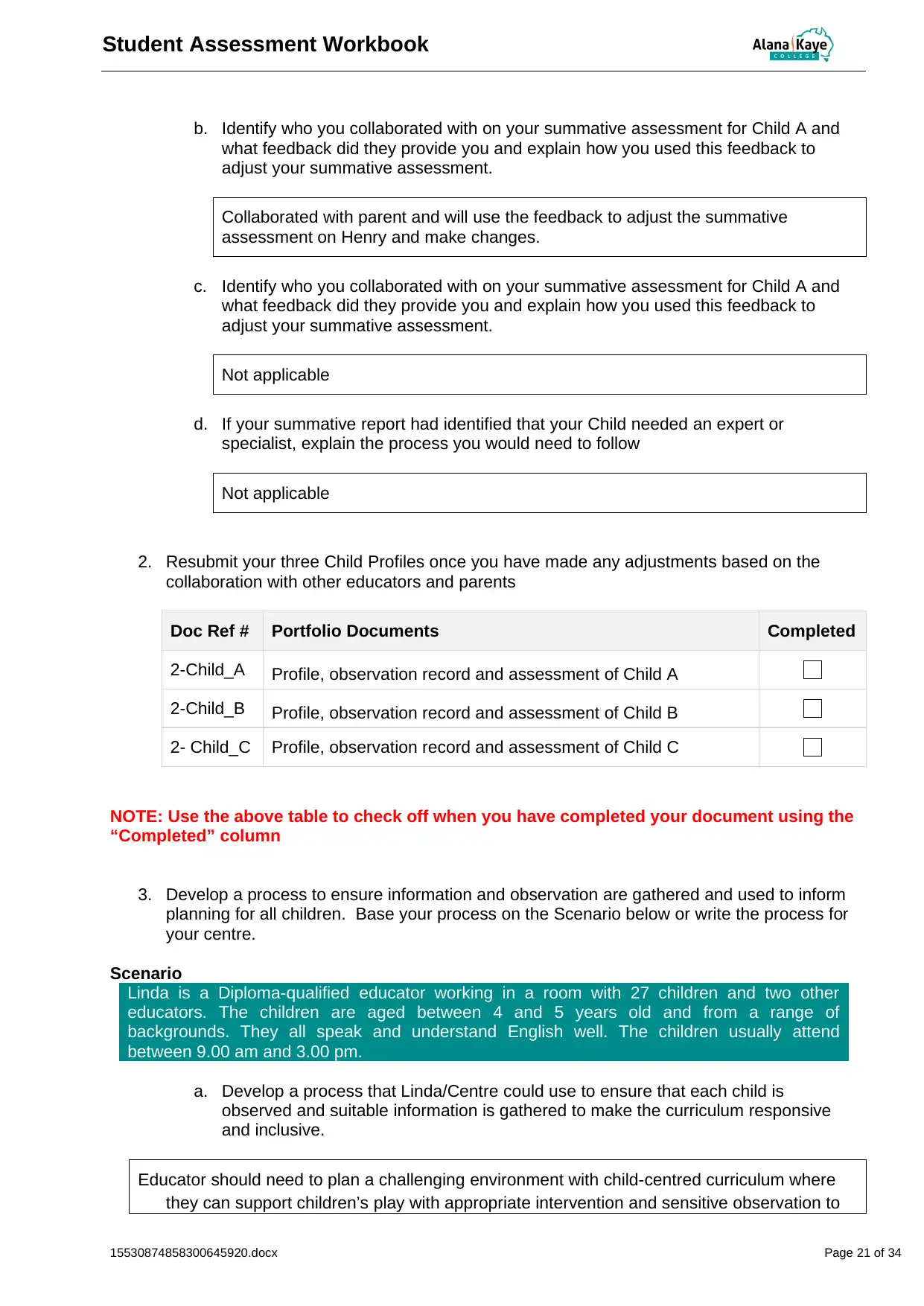
Student Assessment Workbook
b. Identify who you collaborated with on your summative assessment for Child A and
what feedback did they provide you and explain how you used this feedback to
adjust your summative assessment.
Collaborated with parent and will use the feedback to adjust the summative
assessment on Henry and make changes.
c. Identify who you collaborated with on your summative assessment for Child A and
what feedback did they provide you and explain how you used this feedback to
adjust your summative assessment.
Not applicable
d. If your summative report had identified that your Child needed an expert or
specialist, explain the process you would need to follow
Not applicable
2. Resubmit your three Child Profiles once you have made any adjustments based on the
collaboration with other educators and parents
Doc Ref # Portfolio Documents Completed
2-Child_A Profile, observation record and assessment of Child A
2-Child_B Profile, observation record and assessment of Child B
2- Child_C Profile, observation record and assessment of Child C
NOTE: Use the above table to check off when you have completed your document using the
“Completed” column
3. Develop a process to ensure information and observation are gathered and used to inform
planning for all children. Base your process on the Scenario below or write the process for
your centre.
Scenario
Linda is a Diploma-qualified educator working in a room with 27 children and two other
educators. The children are aged between 4 and 5 years old and from a range of
backgrounds. They all speak and understand English well. The children usually attend
between 9.00 am and 3.00 pm.
a. Develop a process that Linda/Centre could use to ensure that each child is
observed and suitable information is gathered to make the curriculum responsive
and inclusive.
Educator should need to plan a challenging environment with child-centred curriculum where
they can support children’s play with appropriate intervention and sensitive observation to
15530874858300645920.docx Page 21 of 34
b. Identify who you collaborated with on your summative assessment for Child A and
what feedback did they provide you and explain how you used this feedback to
adjust your summative assessment.
Collaborated with parent and will use the feedback to adjust the summative
assessment on Henry and make changes.
c. Identify who you collaborated with on your summative assessment for Child A and
what feedback did they provide you and explain how you used this feedback to
adjust your summative assessment.
Not applicable
d. If your summative report had identified that your Child needed an expert or
specialist, explain the process you would need to follow
Not applicable
2. Resubmit your three Child Profiles once you have made any adjustments based on the
collaboration with other educators and parents
Doc Ref # Portfolio Documents Completed
2-Child_A Profile, observation record and assessment of Child A
2-Child_B Profile, observation record and assessment of Child B
2- Child_C Profile, observation record and assessment of Child C
NOTE: Use the above table to check off when you have completed your document using the
“Completed” column
3. Develop a process to ensure information and observation are gathered and used to inform
planning for all children. Base your process on the Scenario below or write the process for
your centre.
Scenario
Linda is a Diploma-qualified educator working in a room with 27 children and two other
educators. The children are aged between 4 and 5 years old and from a range of
backgrounds. They all speak and understand English well. The children usually attend
between 9.00 am and 3.00 pm.
a. Develop a process that Linda/Centre could use to ensure that each child is
observed and suitable information is gathered to make the curriculum responsive
and inclusive.
Educator should need to plan a challenging environment with child-centred curriculum where
they can support children’s play with appropriate intervention and sensitive observation to
15530874858300645920.docx Page 21 of 34
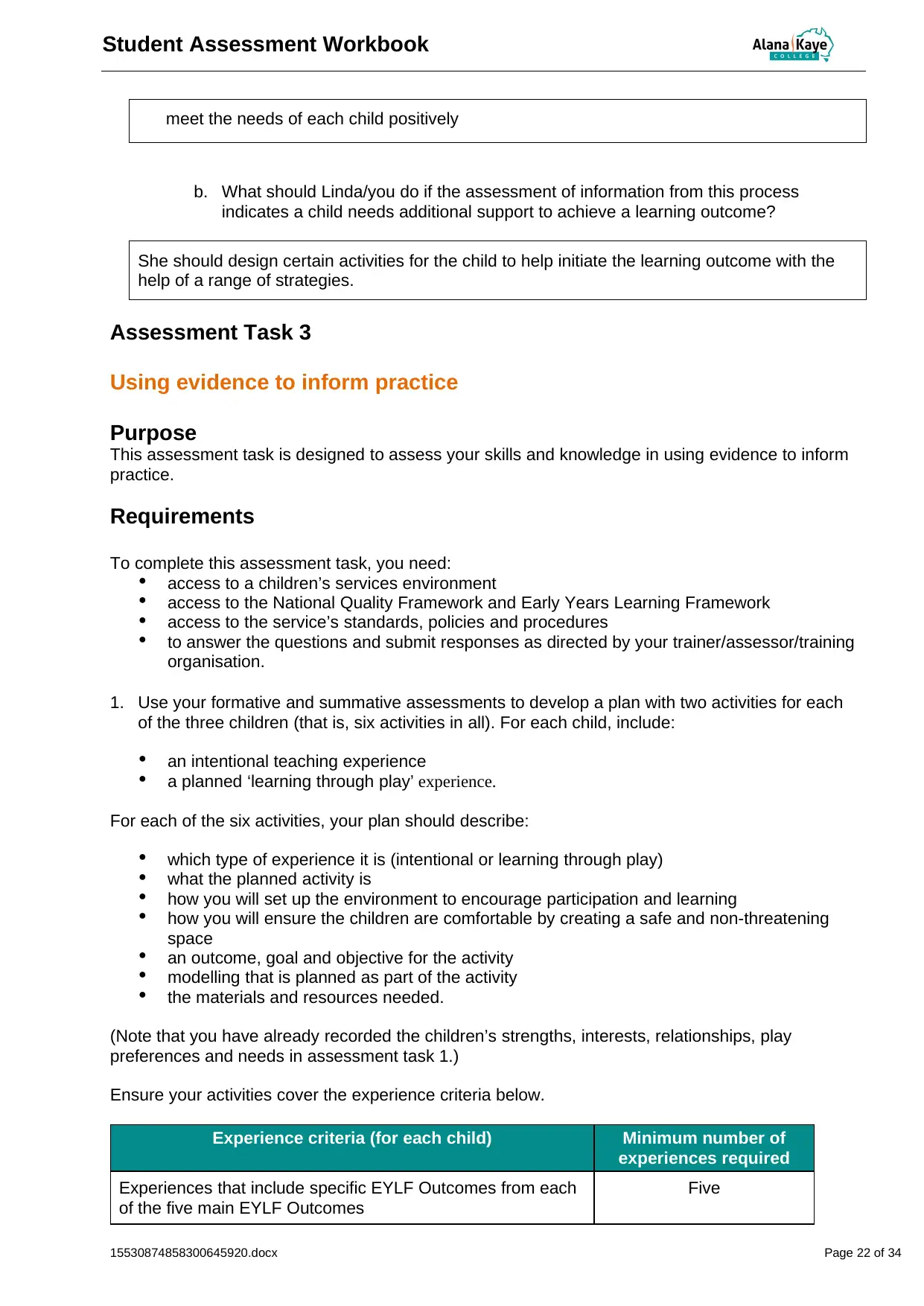
Student Assessment Workbook
meet the needs of each child positively
b. What should Linda/you do if the assessment of information from this process
indicates a child needs additional support to achieve a learning outcome?
She should design certain activities for the child to help initiate the learning outcome with the
help of a range of strategies.
Assessment Task 3
Using evidence to inform practice
Purpose
This assessment task is designed to assess your skills and knowledge in using evidence to inform
practice.
Requirements
To complete this assessment task, you need:
access to a children’s services environment
access to the National Quality Framework and Early Years Learning Framework
access to the service’s standards, policies and procedures
to answer the questions and submit responses as directed by your trainer/assessor/training
organisation.
1. Use your formative and summative assessments to develop a plan with two activities for each
of the three children (that is, six activities in all). For each child, include:
an intentional teaching experience
a planned ‘learning through play’ experience.
For each of the six activities, your plan should describe:
which type of experience it is (intentional or learning through play)
what the planned activity is
how you will set up the environment to encourage participation and learning
how you will ensure the children are comfortable by creating a safe and non-threatening
space
an outcome, goal and objective for the activity
modelling that is planned as part of the activity
the materials and resources needed.
(Note that you have already recorded the children’s strengths, interests, relationships, play
preferences and needs in assessment task 1.)
Ensure your activities cover the experience criteria below.
Experience criteria (for each child) Minimum number of
experiences required
Experiences that include specific EYLF Outcomes from each
of the five main EYLF Outcomes
Five
15530874858300645920.docx Page 22 of 34
meet the needs of each child positively
b. What should Linda/you do if the assessment of information from this process
indicates a child needs additional support to achieve a learning outcome?
She should design certain activities for the child to help initiate the learning outcome with the
help of a range of strategies.
Assessment Task 3
Using evidence to inform practice
Purpose
This assessment task is designed to assess your skills and knowledge in using evidence to inform
practice.
Requirements
To complete this assessment task, you need:
access to a children’s services environment
access to the National Quality Framework and Early Years Learning Framework
access to the service’s standards, policies and procedures
to answer the questions and submit responses as directed by your trainer/assessor/training
organisation.
1. Use your formative and summative assessments to develop a plan with two activities for each
of the three children (that is, six activities in all). For each child, include:
an intentional teaching experience
a planned ‘learning through play’ experience.
For each of the six activities, your plan should describe:
which type of experience it is (intentional or learning through play)
what the planned activity is
how you will set up the environment to encourage participation and learning
how you will ensure the children are comfortable by creating a safe and non-threatening
space
an outcome, goal and objective for the activity
modelling that is planned as part of the activity
the materials and resources needed.
(Note that you have already recorded the children’s strengths, interests, relationships, play
preferences and needs in assessment task 1.)
Ensure your activities cover the experience criteria below.
Experience criteria (for each child) Minimum number of
experiences required
Experiences that include specific EYLF Outcomes from each
of the five main EYLF Outcomes
Five
15530874858300645920.docx Page 22 of 34
Secure Best Marks with AI Grader
Need help grading? Try our AI Grader for instant feedback on your assignments.
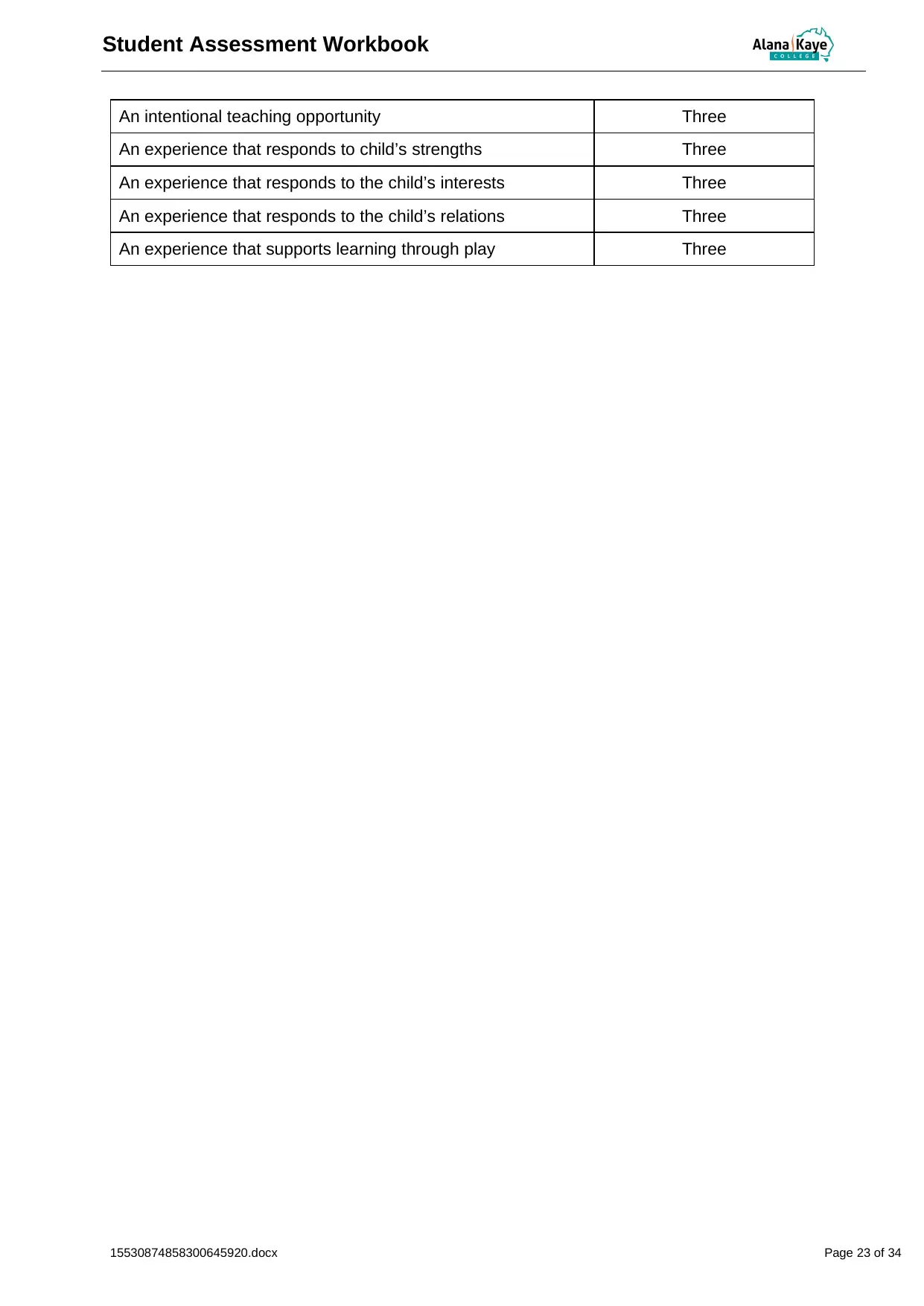
Student Assessment Workbook
An intentional teaching opportunity Three
An experience that responds to child’s strengths Three
An experience that responds to the child’s interests Three
An experience that responds to the child’s relations Three
An experience that supports learning through play Three
15530874858300645920.docx Page 23 of 34
An intentional teaching opportunity Three
An experience that responds to child’s strengths Three
An experience that responds to the child’s interests Three
An experience that responds to the child’s relations Three
An experience that supports learning through play Three
15530874858300645920.docx Page 23 of 34
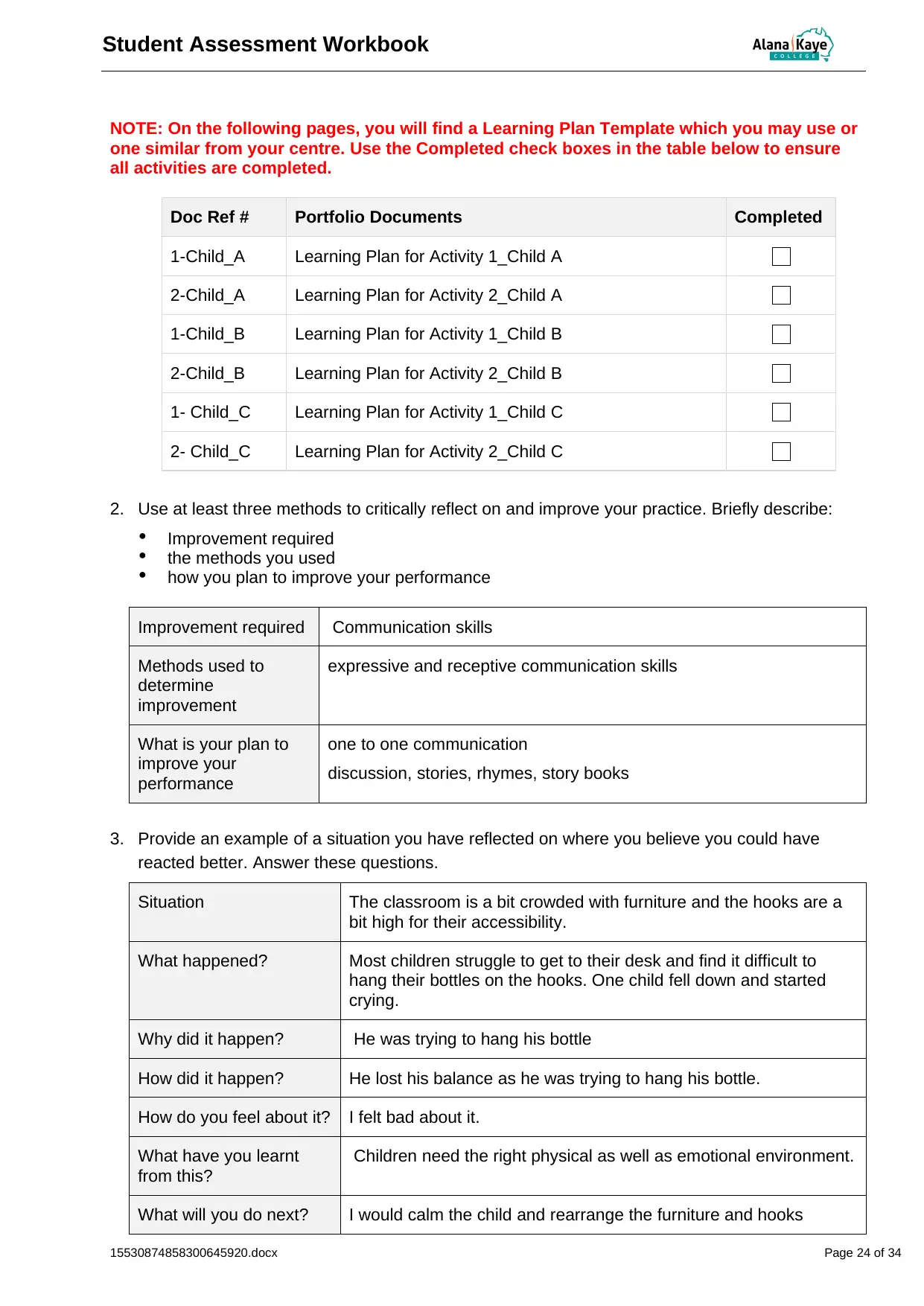
Student Assessment Workbook
NOTE: On the following pages, you will find a Learning Plan Template which you may use or
one similar from your centre. Use the Completed check boxes in the table below to ensure
all activities are completed.
Doc Ref # Portfolio Documents Completed
1-Child_A Learning Plan for Activity 1_Child A
2-Child_A Learning Plan for Activity 2_Child A
1-Child_B Learning Plan for Activity 1_Child B
2-Child_B Learning Plan for Activity 2_Child B
1- Child_C Learning Plan for Activity 1_Child C
2- Child_C Learning Plan for Activity 2_Child C
2. Use at least three methods to critically reflect on and improve your practice. Briefly describe:
Improvement required
the methods you used
how you plan to improve your performance
Improvement required Communication skills
Methods used to
determine
improvement
expressive and receptive communication skills
What is your plan to
improve your
performance
one to one communication
discussion, stories, rhymes, story books
3. Provide an example of a situation you have reflected on where you believe you could have
reacted better. Answer these questions.
Situation The classroom is a bit crowded with furniture and the hooks are a
bit high for their accessibility.
What happened? Most children struggle to get to their desk and find it difficult to
hang their bottles on the hooks. One child fell down and started
crying.
Why did it happen? He was trying to hang his bottle
How did it happen? He lost his balance as he was trying to hang his bottle.
How do you feel about it? I felt bad about it.
What have you learnt
from this?
Children need the right physical as well as emotional environment.
What will you do next? I would calm the child and rearrange the furniture and hooks
15530874858300645920.docx Page 24 of 34
NOTE: On the following pages, you will find a Learning Plan Template which you may use or
one similar from your centre. Use the Completed check boxes in the table below to ensure
all activities are completed.
Doc Ref # Portfolio Documents Completed
1-Child_A Learning Plan for Activity 1_Child A
2-Child_A Learning Plan for Activity 2_Child A
1-Child_B Learning Plan for Activity 1_Child B
2-Child_B Learning Plan for Activity 2_Child B
1- Child_C Learning Plan for Activity 1_Child C
2- Child_C Learning Plan for Activity 2_Child C
2. Use at least three methods to critically reflect on and improve your practice. Briefly describe:
Improvement required
the methods you used
how you plan to improve your performance
Improvement required Communication skills
Methods used to
determine
improvement
expressive and receptive communication skills
What is your plan to
improve your
performance
one to one communication
discussion, stories, rhymes, story books
3. Provide an example of a situation you have reflected on where you believe you could have
reacted better. Answer these questions.
Situation The classroom is a bit crowded with furniture and the hooks are a
bit high for their accessibility.
What happened? Most children struggle to get to their desk and find it difficult to
hang their bottles on the hooks. One child fell down and started
crying.
Why did it happen? He was trying to hang his bottle
How did it happen? He lost his balance as he was trying to hang his bottle.
How do you feel about it? I felt bad about it.
What have you learnt
from this?
Children need the right physical as well as emotional environment.
What will you do next? I would calm the child and rearrange the furniture and hooks
15530874858300645920.docx Page 24 of 34
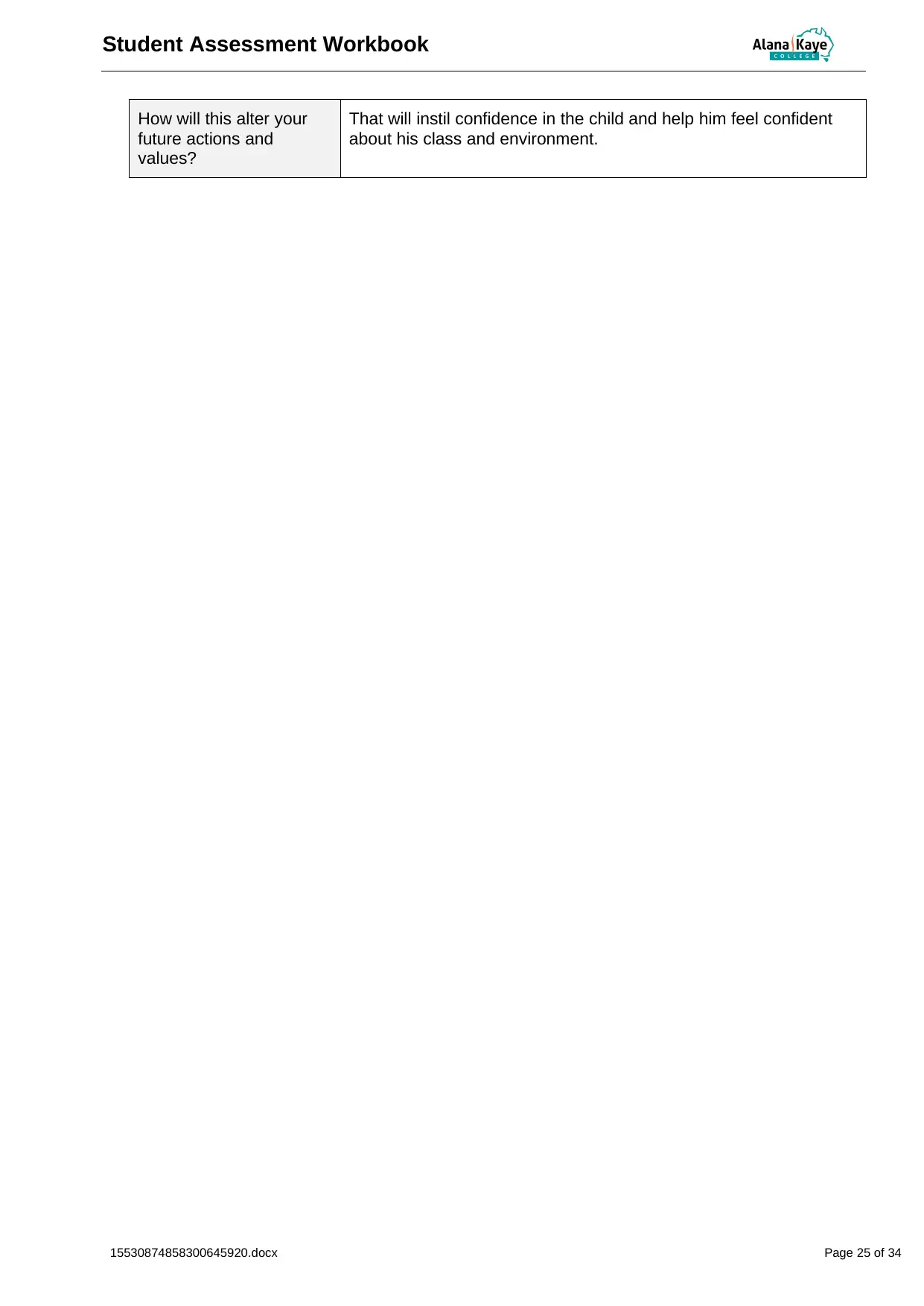
Student Assessment Workbook
How will this alter your
future actions and
values?
That will instil confidence in the child and help him feel confident
about his class and environment.
15530874858300645920.docx Page 25 of 34
How will this alter your
future actions and
values?
That will instil confidence in the child and help him feel confident
about his class and environment.
15530874858300645920.docx Page 25 of 34
Paraphrase This Document
Need a fresh take? Get an instant paraphrase of this document with our AI Paraphraser
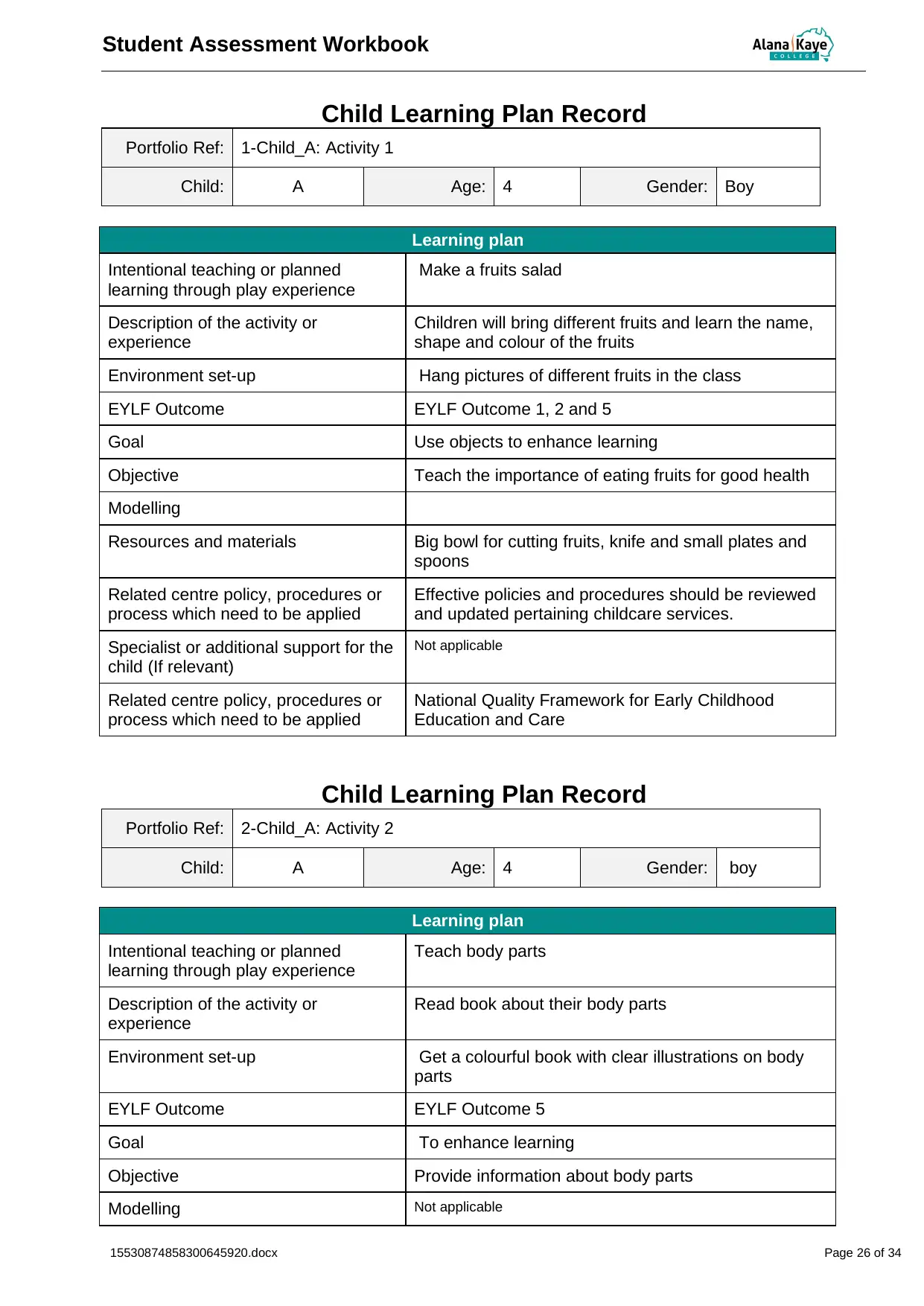
Student Assessment Workbook
Child Learning Plan Record
Portfolio Ref: 1-Child_A: Activity 1
Child: A Age: 4 Gender: Boy
Learning plan
Intentional teaching or planned
learning through play experience
Make a fruits salad
Description of the activity or
experience
Children will bring different fruits and learn the name,
shape and colour of the fruits
Environment set-up Hang pictures of different fruits in the class
EYLF Outcome EYLF Outcome 1, 2 and 5
Goal Use objects to enhance learning
Objective Teach the importance of eating fruits for good health
Modelling
Resources and materials Big bowl for cutting fruits, knife and small plates and
spoons
Related centre policy, procedures or
process which need to be applied
Effective policies and procedures should be reviewed
and updated pertaining childcare services.
Specialist or additional support for the
child (If relevant)
Not applicable
Related centre policy, procedures or
process which need to be applied
National Quality Framework for Early Childhood
Education and Care
Child Learning Plan Record
Portfolio Ref: 2-Child_A: Activity 2
Child: A Age: 4 Gender: boy
Learning plan
Intentional teaching or planned
learning through play experience
Teach body parts
Description of the activity or
experience
Read book about their body parts
Environment set-up Get a colourful book with clear illustrations on body
parts
EYLF Outcome EYLF Outcome 5
Goal To enhance learning
Objective Provide information about body parts
Modelling Not applicable
15530874858300645920.docx Page 26 of 34
Child Learning Plan Record
Portfolio Ref: 1-Child_A: Activity 1
Child: A Age: 4 Gender: Boy
Learning plan
Intentional teaching or planned
learning through play experience
Make a fruits salad
Description of the activity or
experience
Children will bring different fruits and learn the name,
shape and colour of the fruits
Environment set-up Hang pictures of different fruits in the class
EYLF Outcome EYLF Outcome 1, 2 and 5
Goal Use objects to enhance learning
Objective Teach the importance of eating fruits for good health
Modelling
Resources and materials Big bowl for cutting fruits, knife and small plates and
spoons
Related centre policy, procedures or
process which need to be applied
Effective policies and procedures should be reviewed
and updated pertaining childcare services.
Specialist or additional support for the
child (If relevant)
Not applicable
Related centre policy, procedures or
process which need to be applied
National Quality Framework for Early Childhood
Education and Care
Child Learning Plan Record
Portfolio Ref: 2-Child_A: Activity 2
Child: A Age: 4 Gender: boy
Learning plan
Intentional teaching or planned
learning through play experience
Teach body parts
Description of the activity or
experience
Read book about their body parts
Environment set-up Get a colourful book with clear illustrations on body
parts
EYLF Outcome EYLF Outcome 5
Goal To enhance learning
Objective Provide information about body parts
Modelling Not applicable
15530874858300645920.docx Page 26 of 34
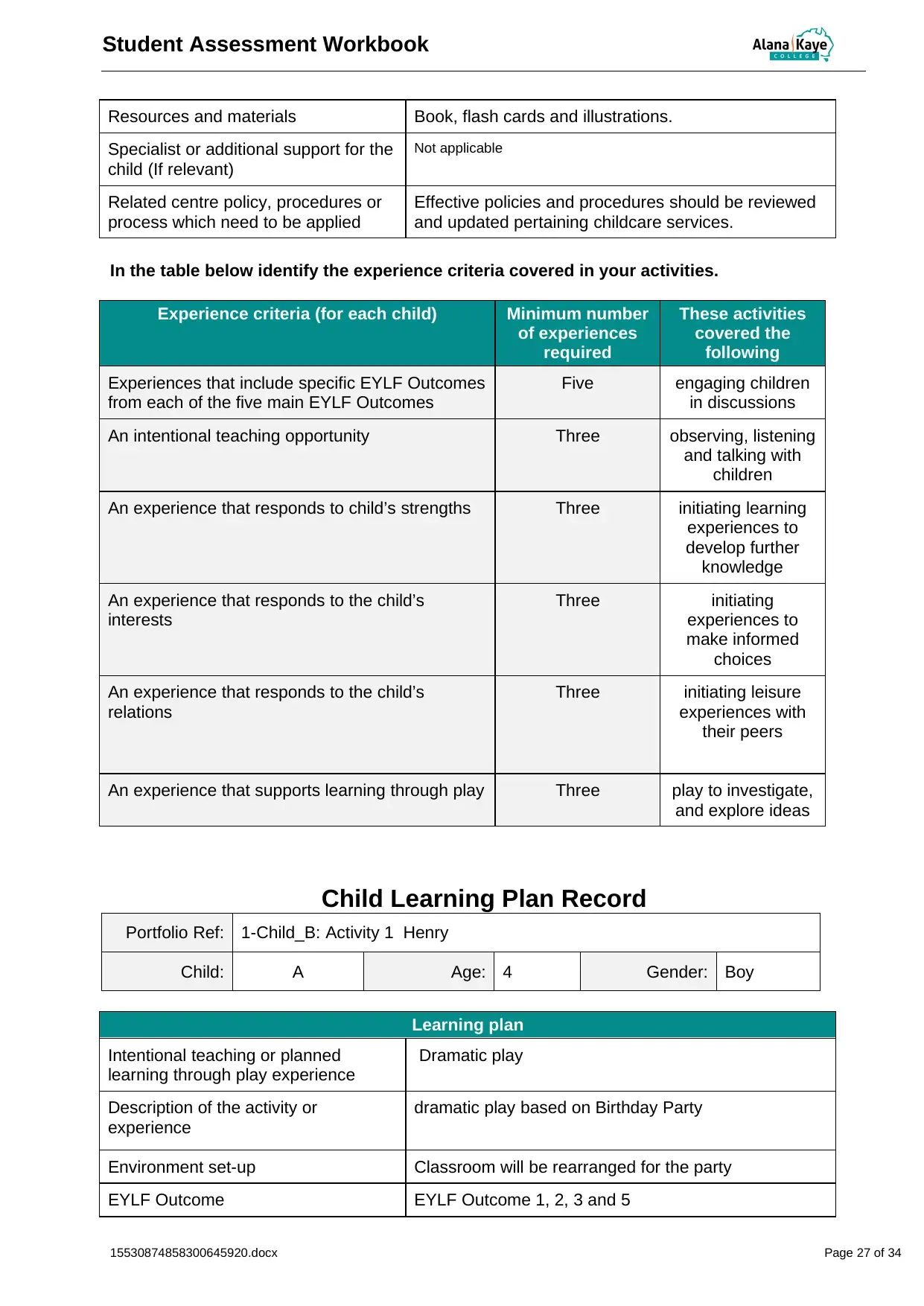
Student Assessment Workbook
Resources and materials Book, flash cards and illustrations.
Specialist or additional support for the
child (If relevant)
Not applicable
Related centre policy, procedures or
process which need to be applied
Effective policies and procedures should be reviewed
and updated pertaining childcare services.
In the table below identify the experience criteria covered in your activities.
Experience criteria (for each child) Minimum number
of experiences
required
These activities
covered the
following
Experiences that include specific EYLF Outcomes
from each of the five main EYLF Outcomes
Five engaging children
in discussions
An intentional teaching opportunity Three observing, listening
and talking with
children
An experience that responds to child’s strengths Three initiating learning
experiences to
develop further
knowledge
An experience that responds to the child’s
interests
Three initiating
experiences to
make informed
choices
An experience that responds to the child’s
relations
Three initiating leisure
experiences with
their peers
An experience that supports learning through play Three play to investigate,
and explore ideas
Child Learning Plan Record
Portfolio Ref: 1-Child_B: Activity 1 Henry
Child: A Age: 4 Gender: Boy
Learning plan
Intentional teaching or planned
learning through play experience
Dramatic play
Description of the activity or
experience
dramatic play based on Birthday Party
Environment set-up Classroom will be rearranged for the party
EYLF Outcome EYLF Outcome 1, 2, 3 and 5
15530874858300645920.docx Page 27 of 34
Resources and materials Book, flash cards and illustrations.
Specialist or additional support for the
child (If relevant)
Not applicable
Related centre policy, procedures or
process which need to be applied
Effective policies and procedures should be reviewed
and updated pertaining childcare services.
In the table below identify the experience criteria covered in your activities.
Experience criteria (for each child) Minimum number
of experiences
required
These activities
covered the
following
Experiences that include specific EYLF Outcomes
from each of the five main EYLF Outcomes
Five engaging children
in discussions
An intentional teaching opportunity Three observing, listening
and talking with
children
An experience that responds to child’s strengths Three initiating learning
experiences to
develop further
knowledge
An experience that responds to the child’s
interests
Three initiating
experiences to
make informed
choices
An experience that responds to the child’s
relations
Three initiating leisure
experiences with
their peers
An experience that supports learning through play Three play to investigate,
and explore ideas
Child Learning Plan Record
Portfolio Ref: 1-Child_B: Activity 1 Henry
Child: A Age: 4 Gender: Boy
Learning plan
Intentional teaching or planned
learning through play experience
Dramatic play
Description of the activity or
experience
dramatic play based on Birthday Party
Environment set-up Classroom will be rearranged for the party
EYLF Outcome EYLF Outcome 1, 2, 3 and 5
15530874858300645920.docx Page 27 of 34
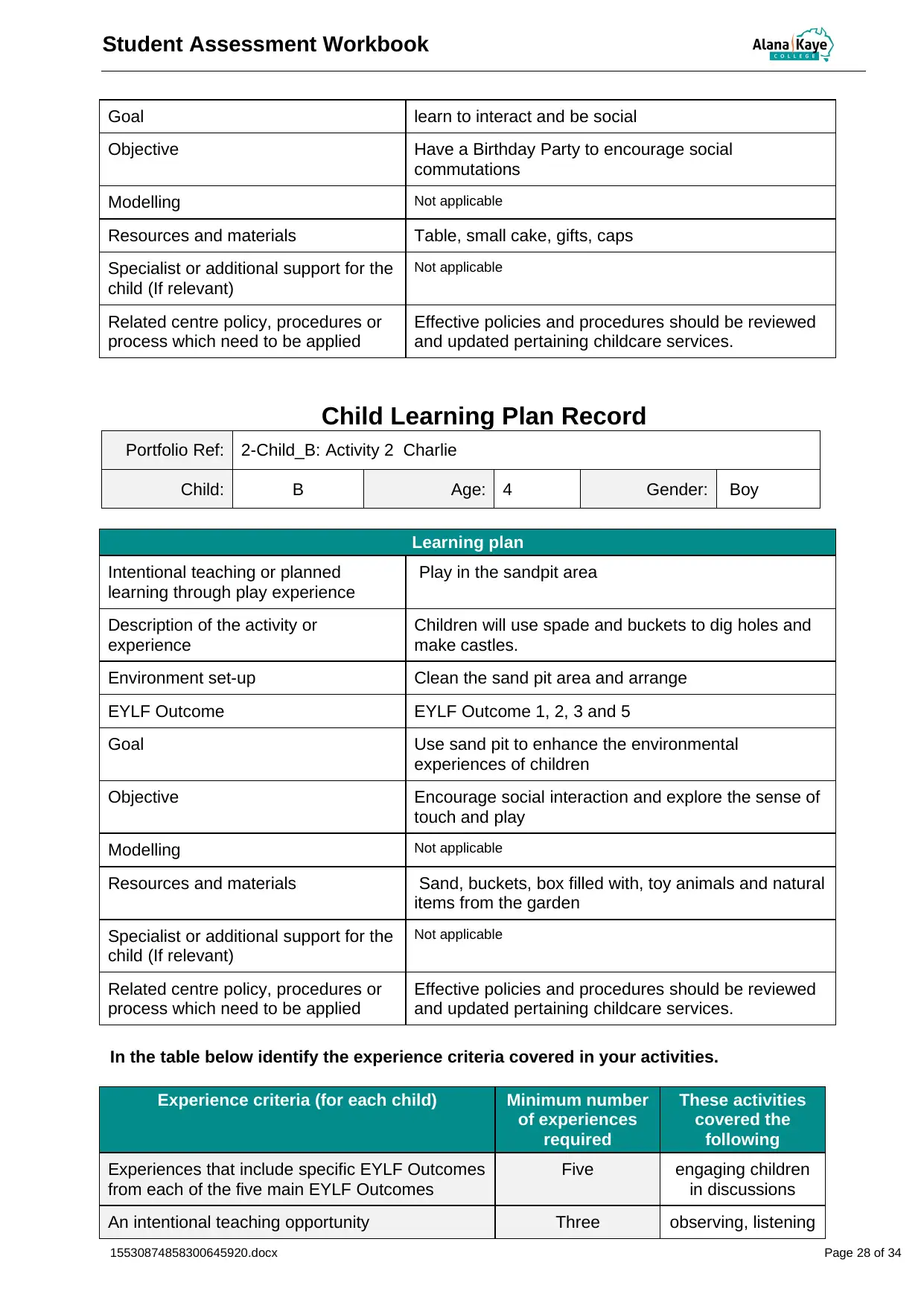
Student Assessment Workbook
Goal learn to interact and be social
Objective Have a Birthday Party to encourage social
commutations
Modelling Not applicable
Resources and materials Table, small cake, gifts, caps
Specialist or additional support for the
child (If relevant)
Not applicable
Related centre policy, procedures or
process which need to be applied
Effective policies and procedures should be reviewed
and updated pertaining childcare services.
Child Learning Plan Record
Portfolio Ref: 2-Child_B: Activity 2 Charlie
Child: B Age: 4 Gender: Boy
Learning plan
Intentional teaching or planned
learning through play experience
Play in the sandpit area
Description of the activity or
experience
Children will use spade and buckets to dig holes and
make castles.
Environment set-up Clean the sand pit area and arrange
EYLF Outcome EYLF Outcome 1, 2, 3 and 5
Goal Use sand pit to enhance the environmental
experiences of children
Objective Encourage social interaction and explore the sense of
touch and play
Modelling Not applicable
Resources and materials Sand, buckets, box filled with, toy animals and natural
items from the garden
Specialist or additional support for the
child (If relevant)
Not applicable
Related centre policy, procedures or
process which need to be applied
Effective policies and procedures should be reviewed
and updated pertaining childcare services.
In the table below identify the experience criteria covered in your activities.
Experience criteria (for each child) Minimum number
of experiences
required
These activities
covered the
following
Experiences that include specific EYLF Outcomes
from each of the five main EYLF Outcomes
Five engaging children
in discussions
An intentional teaching opportunity Three observing, listening
15530874858300645920.docx Page 28 of 34
Goal learn to interact and be social
Objective Have a Birthday Party to encourage social
commutations
Modelling Not applicable
Resources and materials Table, small cake, gifts, caps
Specialist or additional support for the
child (If relevant)
Not applicable
Related centre policy, procedures or
process which need to be applied
Effective policies and procedures should be reviewed
and updated pertaining childcare services.
Child Learning Plan Record
Portfolio Ref: 2-Child_B: Activity 2 Charlie
Child: B Age: 4 Gender: Boy
Learning plan
Intentional teaching or planned
learning through play experience
Play in the sandpit area
Description of the activity or
experience
Children will use spade and buckets to dig holes and
make castles.
Environment set-up Clean the sand pit area and arrange
EYLF Outcome EYLF Outcome 1, 2, 3 and 5
Goal Use sand pit to enhance the environmental
experiences of children
Objective Encourage social interaction and explore the sense of
touch and play
Modelling Not applicable
Resources and materials Sand, buckets, box filled with, toy animals and natural
items from the garden
Specialist or additional support for the
child (If relevant)
Not applicable
Related centre policy, procedures or
process which need to be applied
Effective policies and procedures should be reviewed
and updated pertaining childcare services.
In the table below identify the experience criteria covered in your activities.
Experience criteria (for each child) Minimum number
of experiences
required
These activities
covered the
following
Experiences that include specific EYLF Outcomes
from each of the five main EYLF Outcomes
Five engaging children
in discussions
An intentional teaching opportunity Three observing, listening
15530874858300645920.docx Page 28 of 34
Secure Best Marks with AI Grader
Need help grading? Try our AI Grader for instant feedback on your assignments.
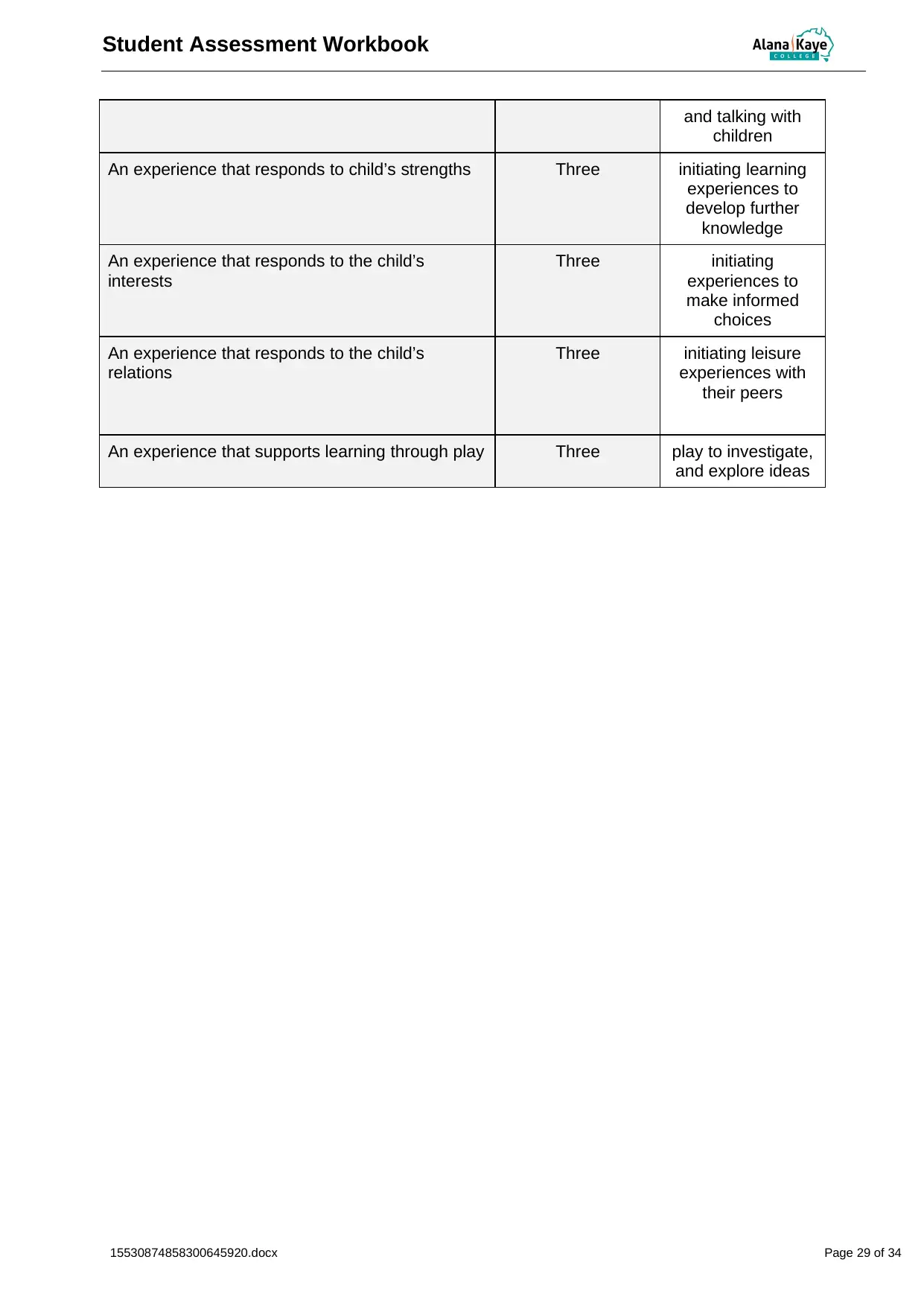
Student Assessment Workbook
and talking with
children
An experience that responds to child’s strengths Three initiating learning
experiences to
develop further
knowledge
An experience that responds to the child’s
interests
Three initiating
experiences to
make informed
choices
An experience that responds to the child’s
relations
Three initiating leisure
experiences with
their peers
An experience that supports learning through play Three play to investigate,
and explore ideas
15530874858300645920.docx Page 29 of 34
and talking with
children
An experience that responds to child’s strengths Three initiating learning
experiences to
develop further
knowledge
An experience that responds to the child’s
interests
Three initiating
experiences to
make informed
choices
An experience that responds to the child’s
relations
Three initiating leisure
experiences with
their peers
An experience that supports learning through play Three play to investigate,
and explore ideas
15530874858300645920.docx Page 29 of 34
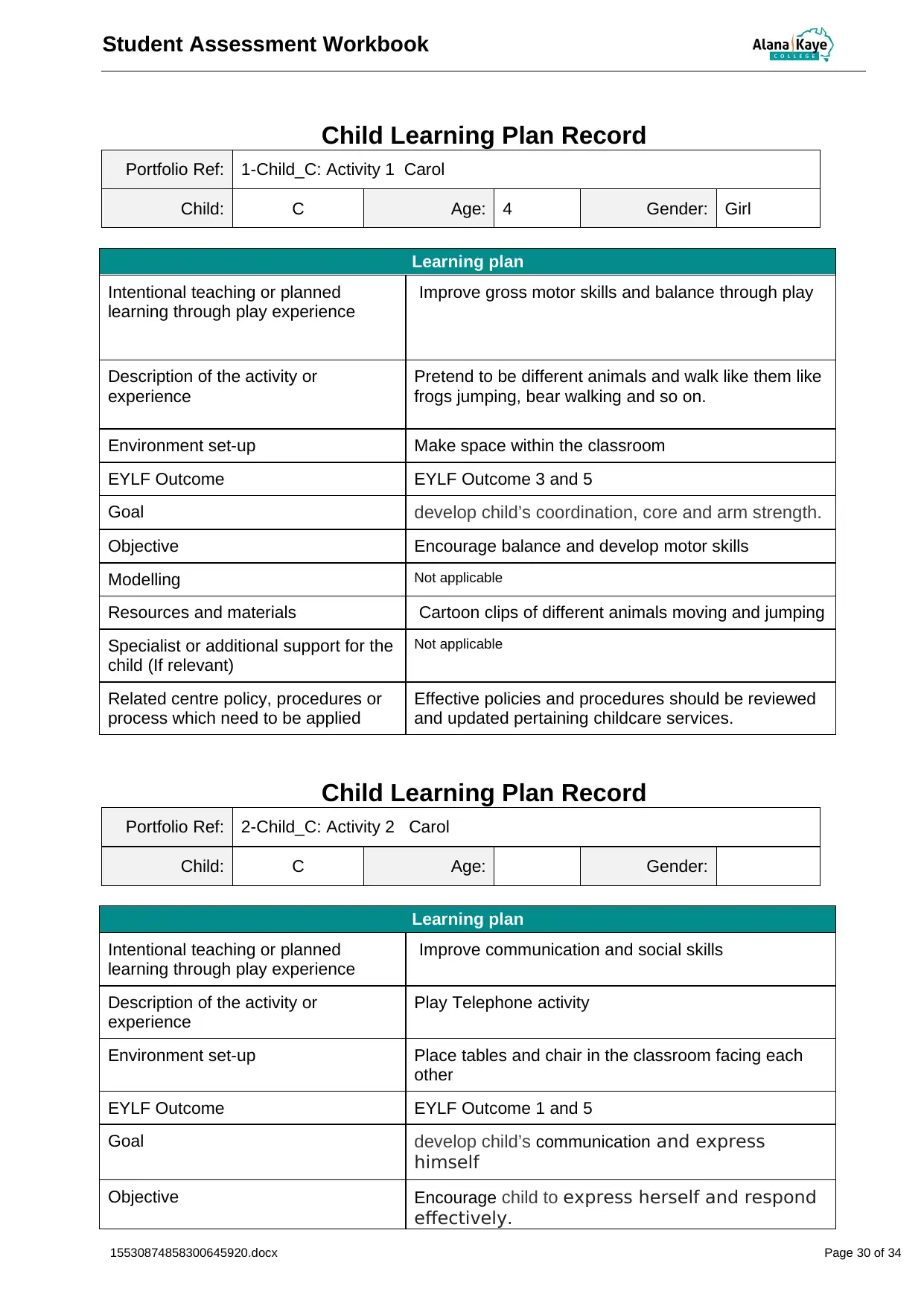
Student Assessment Workbook
Child Learning Plan Record
Portfolio Ref: 1-Child_C: Activity 1 Carol
Child: C Age: 4 Gender: Girl
Learning plan
Intentional teaching or planned
learning through play experience
Improve gross motor skills and balance through play
Description of the activity or
experience
Pretend to be different animals and walk like them like
frogs jumping, bear walking and so on.
Environment set-up Make space within the classroom
EYLF Outcome EYLF Outcome 3 and 5
Goal develop child’s coordination, core and arm strength.
Objective Encourage balance and develop motor skills
Modelling Not applicable
Resources and materials Cartoon clips of different animals moving and jumping
Specialist or additional support for the
child (If relevant)
Not applicable
Related centre policy, procedures or
process which need to be applied
Effective policies and procedures should be reviewed
and updated pertaining childcare services.
Child Learning Plan Record
Portfolio Ref: 2-Child_C: Activity 2 Carol
Child: C Age: Gender:
Learning plan
Intentional teaching or planned
learning through play experience
Improve communication and social skills
Description of the activity or
experience
Play Telephone activity
Environment set-up Place tables and chair in the classroom facing each
other
EYLF Outcome EYLF Outcome 1 and 5
Goal develop child’s communication and express
himself
Objective Encourage child to express herself and respond
effectively.
15530874858300645920.docx Page 30 of 34
Child Learning Plan Record
Portfolio Ref: 1-Child_C: Activity 1 Carol
Child: C Age: 4 Gender: Girl
Learning plan
Intentional teaching or planned
learning through play experience
Improve gross motor skills and balance through play
Description of the activity or
experience
Pretend to be different animals and walk like them like
frogs jumping, bear walking and so on.
Environment set-up Make space within the classroom
EYLF Outcome EYLF Outcome 3 and 5
Goal develop child’s coordination, core and arm strength.
Objective Encourage balance and develop motor skills
Modelling Not applicable
Resources and materials Cartoon clips of different animals moving and jumping
Specialist or additional support for the
child (If relevant)
Not applicable
Related centre policy, procedures or
process which need to be applied
Effective policies and procedures should be reviewed
and updated pertaining childcare services.
Child Learning Plan Record
Portfolio Ref: 2-Child_C: Activity 2 Carol
Child: C Age: Gender:
Learning plan
Intentional teaching or planned
learning through play experience
Improve communication and social skills
Description of the activity or
experience
Play Telephone activity
Environment set-up Place tables and chair in the classroom facing each
other
EYLF Outcome EYLF Outcome 1 and 5
Goal develop child’s communication and express
himself
Objective Encourage child to express herself and respond
effectively.
15530874858300645920.docx Page 30 of 34
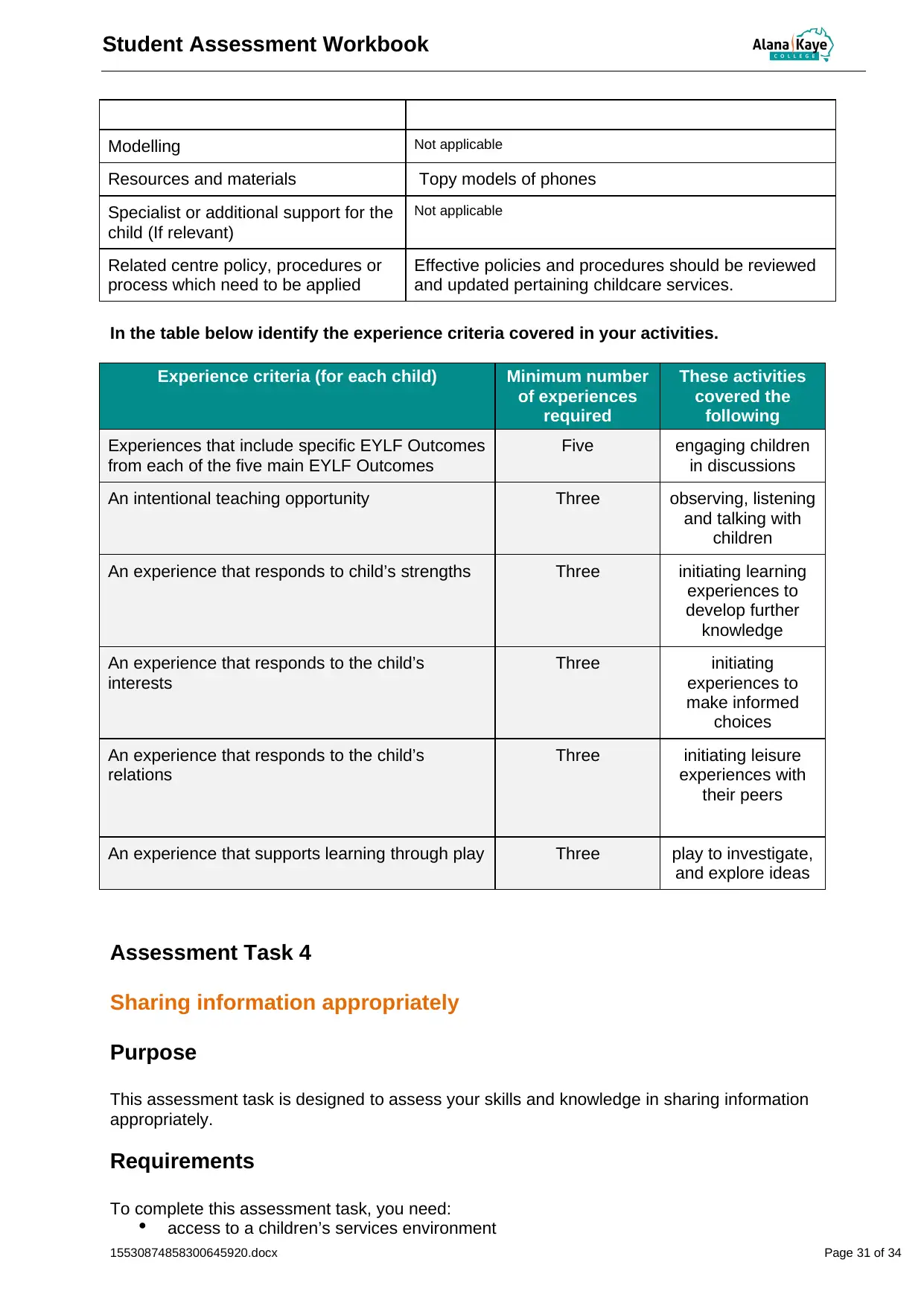
Student Assessment Workbook
Modelling Not applicable
Resources and materials Topy models of phones
Specialist or additional support for the
child (If relevant)
Not applicable
Related centre policy, procedures or
process which need to be applied
Effective policies and procedures should be reviewed
and updated pertaining childcare services.
In the table below identify the experience criteria covered in your activities.
Experience criteria (for each child) Minimum number
of experiences
required
These activities
covered the
following
Experiences that include specific EYLF Outcomes
from each of the five main EYLF Outcomes
Five engaging children
in discussions
An intentional teaching opportunity Three observing, listening
and talking with
children
An experience that responds to child’s strengths Three initiating learning
experiences to
develop further
knowledge
An experience that responds to the child’s
interests
Three initiating
experiences to
make informed
choices
An experience that responds to the child’s
relations
Three initiating leisure
experiences with
their peers
An experience that supports learning through play Three play to investigate,
and explore ideas
Assessment Task 4
Sharing information appropriately
Purpose
This assessment task is designed to assess your skills and knowledge in sharing information
appropriately.
Requirements
To complete this assessment task, you need:
access to a children’s services environment
15530874858300645920.docx Page 31 of 34
Modelling Not applicable
Resources and materials Topy models of phones
Specialist or additional support for the
child (If relevant)
Not applicable
Related centre policy, procedures or
process which need to be applied
Effective policies and procedures should be reviewed
and updated pertaining childcare services.
In the table below identify the experience criteria covered in your activities.
Experience criteria (for each child) Minimum number
of experiences
required
These activities
covered the
following
Experiences that include specific EYLF Outcomes
from each of the five main EYLF Outcomes
Five engaging children
in discussions
An intentional teaching opportunity Three observing, listening
and talking with
children
An experience that responds to child’s strengths Three initiating learning
experiences to
develop further
knowledge
An experience that responds to the child’s
interests
Three initiating
experiences to
make informed
choices
An experience that responds to the child’s
relations
Three initiating leisure
experiences with
their peers
An experience that supports learning through play Three play to investigate,
and explore ideas
Assessment Task 4
Sharing information appropriately
Purpose
This assessment task is designed to assess your skills and knowledge in sharing information
appropriately.
Requirements
To complete this assessment task, you need:
access to a children’s services environment
15530874858300645920.docx Page 31 of 34
Paraphrase This Document
Need a fresh take? Get an instant paraphrase of this document with our AI Paraphraser
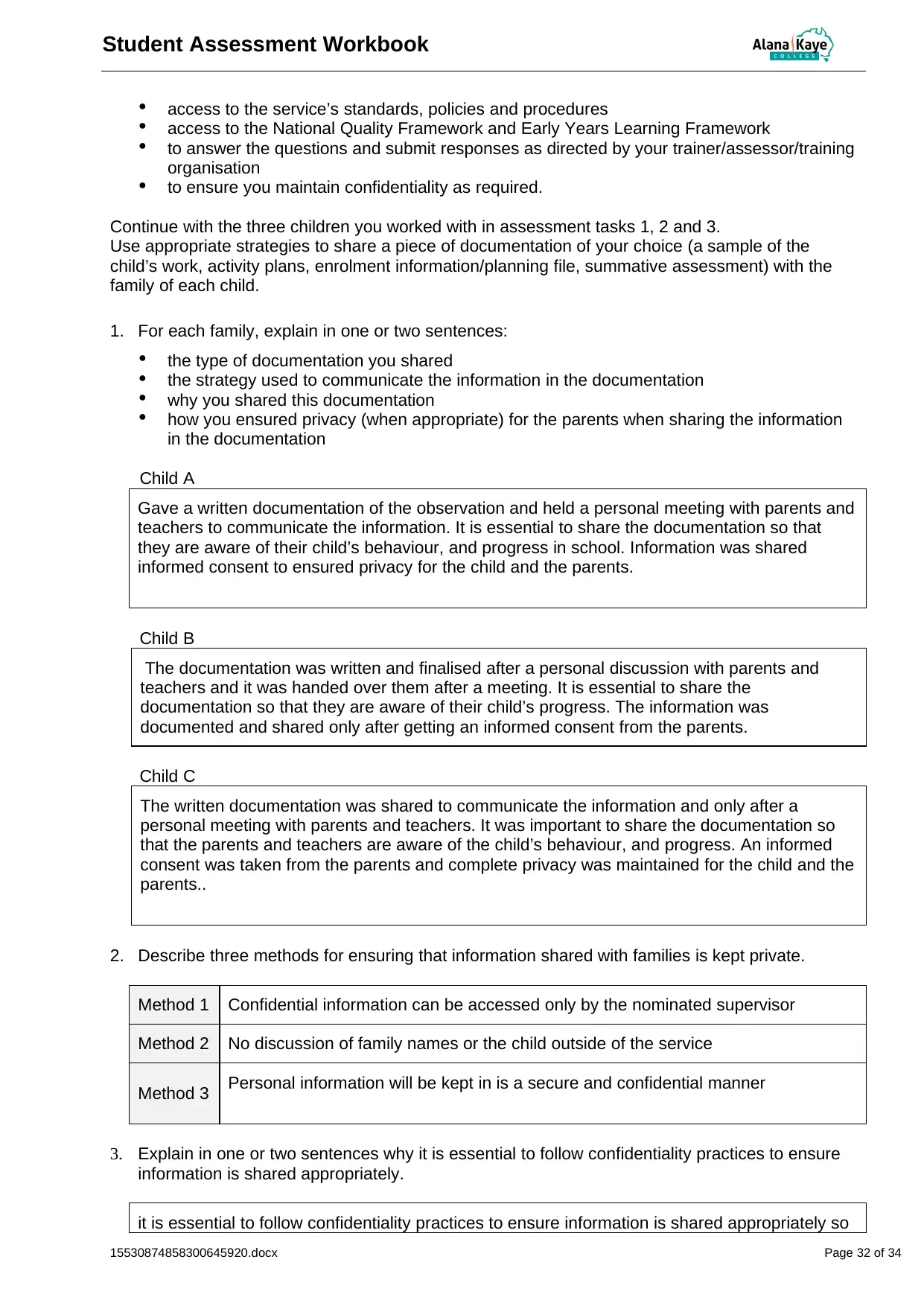
Student Assessment Workbook
access to the service’s standards, policies and procedures
access to the National Quality Framework and Early Years Learning Framework
to answer the questions and submit responses as directed by your trainer/assessor/training
organisation
to ensure you maintain confidentiality as required.
Continue with the three children you worked with in assessment tasks 1, 2 and 3.
Use appropriate strategies to share a piece of documentation of your choice (a sample of the
child’s work, activity plans, enrolment information/planning file, summative assessment) with the
family of each child.
1. For each family, explain in one or two sentences:
the type of documentation you shared
the strategy used to communicate the information in the documentation
why you shared this documentation
how you ensured privacy (when appropriate) for the parents when sharing the information
in the documentation
Child A
Gave a written documentation of the observation and held a personal meeting with parents and
teachers to communicate the information. It is essential to share the documentation so that
they are aware of their child’s behaviour, and progress in school. Information was shared
informed consent to ensured privacy for the child and the parents.
Child B
The documentation was written and finalised after a personal discussion with parents and
teachers and it was handed over them after a meeting. It is essential to share the
documentation so that they are aware of their child’s progress. The information was
documented and shared only after getting an informed consent from the parents.
Child C
The written documentation was shared to communicate the information and only after a
personal meeting with parents and teachers. It was important to share the documentation so
that the parents and teachers are aware of the child’s behaviour, and progress. An informed
consent was taken from the parents and complete privacy was maintained for the child and the
parents..
2. Describe three methods for ensuring that information shared with families is kept private.
Method 1 Confidential information can be accessed only by the nominated supervisor
Method 2 No discussion of family names or the child outside of the service
Method 3 Personal information will be kept in is a secure and confidential manner
3. Explain in one or two sentences why it is essential to follow confidentiality practices to ensure
information is shared appropriately.
it is essential to follow confidentiality practices to ensure information is shared appropriately so
15530874858300645920.docx Page 32 of 34
access to the service’s standards, policies and procedures
access to the National Quality Framework and Early Years Learning Framework
to answer the questions and submit responses as directed by your trainer/assessor/training
organisation
to ensure you maintain confidentiality as required.
Continue with the three children you worked with in assessment tasks 1, 2 and 3.
Use appropriate strategies to share a piece of documentation of your choice (a sample of the
child’s work, activity plans, enrolment information/planning file, summative assessment) with the
family of each child.
1. For each family, explain in one or two sentences:
the type of documentation you shared
the strategy used to communicate the information in the documentation
why you shared this documentation
how you ensured privacy (when appropriate) for the parents when sharing the information
in the documentation
Child A
Gave a written documentation of the observation and held a personal meeting with parents and
teachers to communicate the information. It is essential to share the documentation so that
they are aware of their child’s behaviour, and progress in school. Information was shared
informed consent to ensured privacy for the child and the parents.
Child B
The documentation was written and finalised after a personal discussion with parents and
teachers and it was handed over them after a meeting. It is essential to share the
documentation so that they are aware of their child’s progress. The information was
documented and shared only after getting an informed consent from the parents.
Child C
The written documentation was shared to communicate the information and only after a
personal meeting with parents and teachers. It was important to share the documentation so
that the parents and teachers are aware of the child’s behaviour, and progress. An informed
consent was taken from the parents and complete privacy was maintained for the child and the
parents..
2. Describe three methods for ensuring that information shared with families is kept private.
Method 1 Confidential information can be accessed only by the nominated supervisor
Method 2 No discussion of family names or the child outside of the service
Method 3 Personal information will be kept in is a secure and confidential manner
3. Explain in one or two sentences why it is essential to follow confidentiality practices to ensure
information is shared appropriately.
it is essential to follow confidentiality practices to ensure information is shared appropriately so
15530874858300645920.docx Page 32 of 34
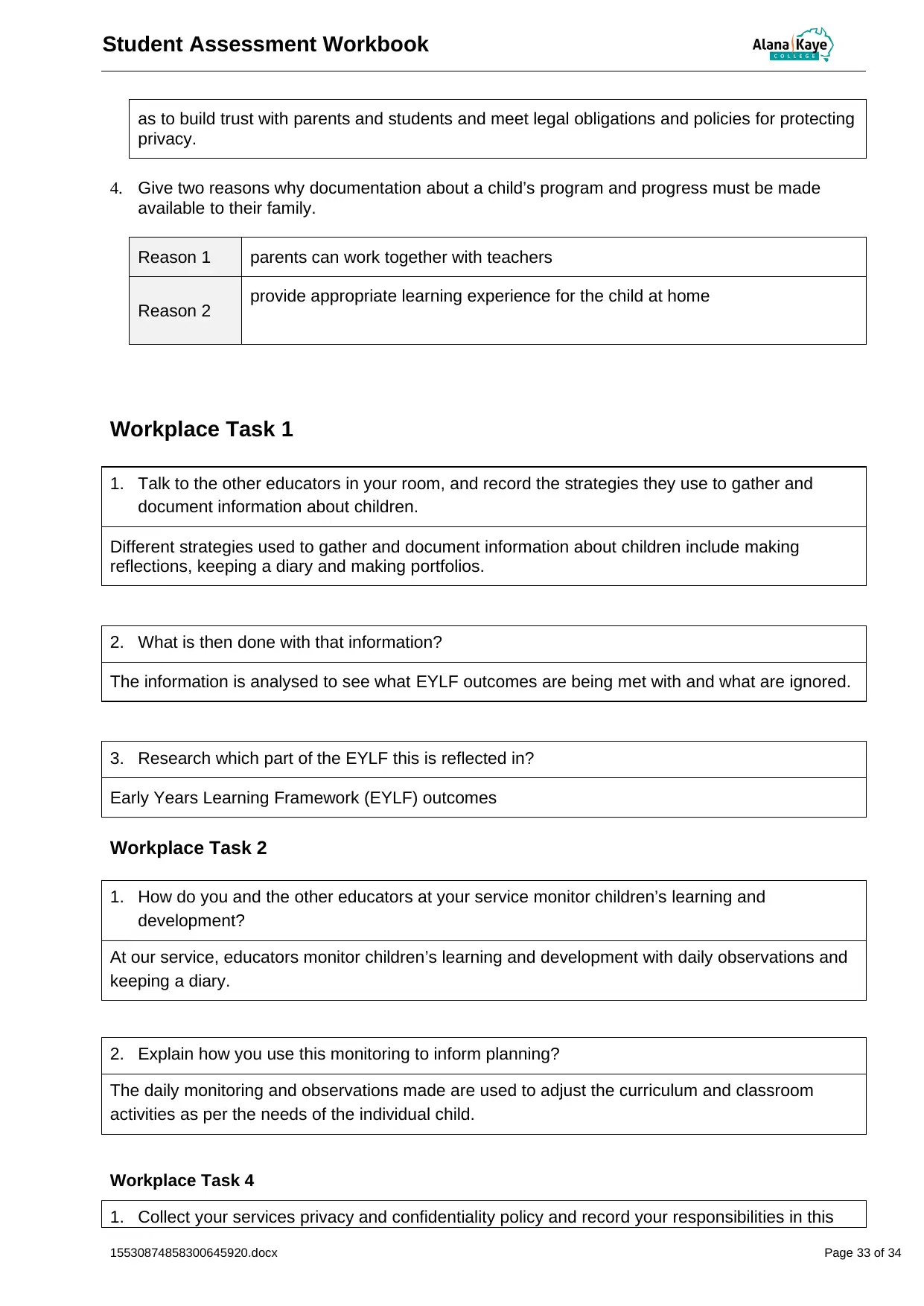
Student Assessment Workbook
as to build trust with parents and students and meet legal obligations and policies for protecting
privacy.
4. Give two reasons why documentation about a child’s program and progress must be made
available to their family.
Reason 1 parents can work together with teachers
Reason 2 provide appropriate learning experience for the child at home
Workplace Task 1
1. Talk to the other educators in your room, and record the strategies they use to gather and
document information about children.
Different strategies used to gather and document information about children include making
reflections, keeping a diary and making portfolios.
2. What is then done with that information?
The information is analysed to see what EYLF outcomes are being met with and what are ignored.
3. Research which part of the EYLF this is reflected in?
Early Years Learning Framework (EYLF) outcomes
Workplace Task 2
1. How do you and the other educators at your service monitor children’s learning and
development?
At our service, educators monitor children’s learning and development with daily observations and
keeping a diary.
2. Explain how you use this monitoring to inform planning?
The daily monitoring and observations made are used to adjust the curriculum and classroom
activities as per the needs of the individual child.
Workplace Task 4
1. Collect your services privacy and confidentiality policy and record your responsibilities in this
15530874858300645920.docx Page 33 of 34
as to build trust with parents and students and meet legal obligations and policies for protecting
privacy.
4. Give two reasons why documentation about a child’s program and progress must be made
available to their family.
Reason 1 parents can work together with teachers
Reason 2 provide appropriate learning experience for the child at home
Workplace Task 1
1. Talk to the other educators in your room, and record the strategies they use to gather and
document information about children.
Different strategies used to gather and document information about children include making
reflections, keeping a diary and making portfolios.
2. What is then done with that information?
The information is analysed to see what EYLF outcomes are being met with and what are ignored.
3. Research which part of the EYLF this is reflected in?
Early Years Learning Framework (EYLF) outcomes
Workplace Task 2
1. How do you and the other educators at your service monitor children’s learning and
development?
At our service, educators monitor children’s learning and development with daily observations and
keeping a diary.
2. Explain how you use this monitoring to inform planning?
The daily monitoring and observations made are used to adjust the curriculum and classroom
activities as per the needs of the individual child.
Workplace Task 4
1. Collect your services privacy and confidentiality policy and record your responsibilities in this
15530874858300645920.docx Page 33 of 34
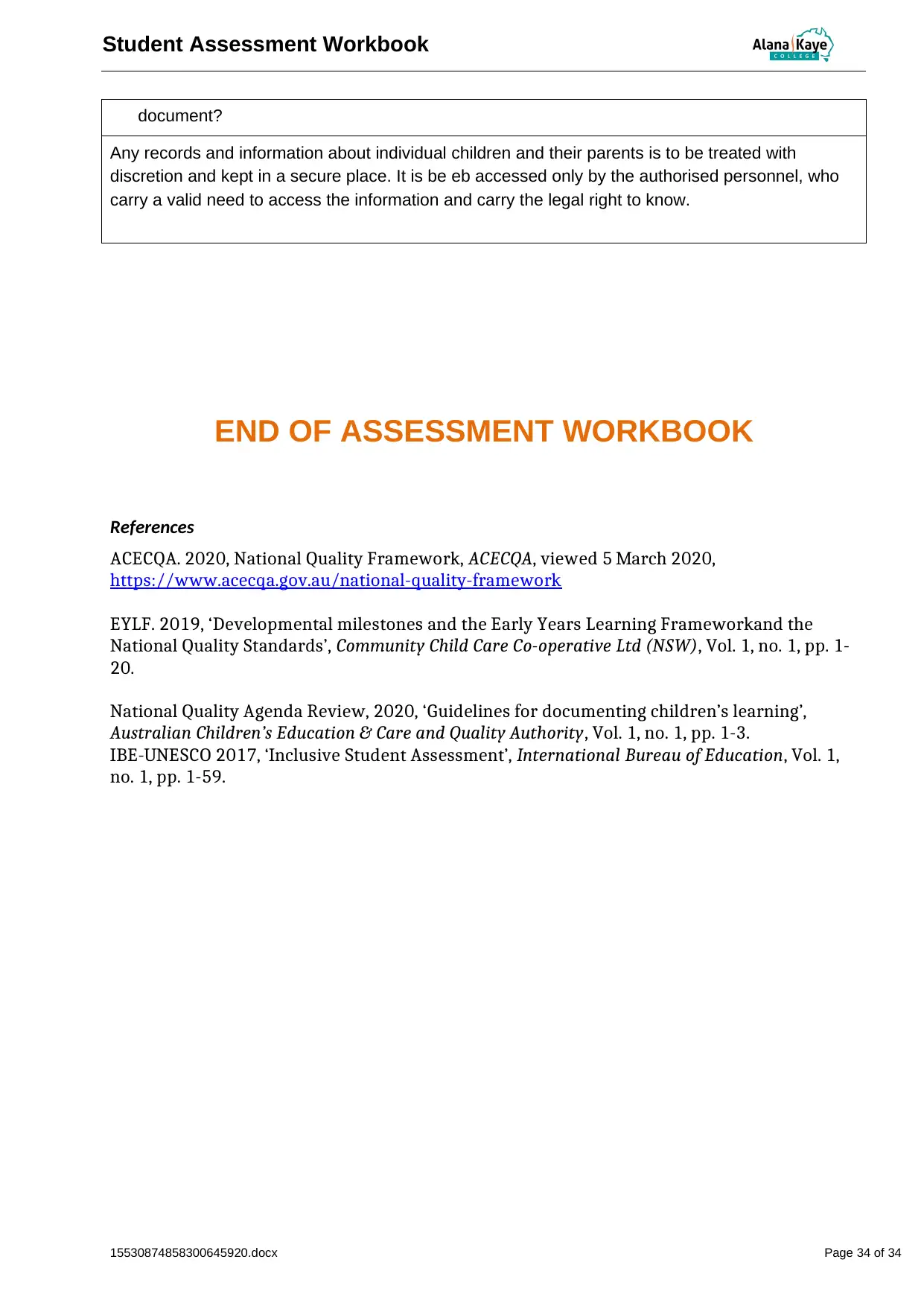
Student Assessment Workbook
document?
Any records and information about individual children and their parents is to be treated with
discretion and kept in a secure place. It is be eb accessed only by the authorised personnel, who
carry a valid need to access the information and carry the legal right to know.
END OF ASSESSMENT WORKBOOK
References
ACECQA. 2020, National Quality Framework, ACECQA, viewed 5 March 2020,
https://www.acecqa.gov.au/national-quality-framework
EYLF. 2019, ‘Developmental milestones and the Early Years Learning Frameworkand the
National Quality Standards’, Community Child Care Co-operative Ltd (NSW), Vol. 1, no. 1, pp. 1-
20.
National Quality Agenda Review, 2020, ‘Guidelines for documenting children’s learning’,
Australian Children’s Education & Care and Quality Authority, Vol. 1, no. 1, pp. 1-3.
IBE-UNESCO 2017, ‘Inclusive Student Assessment’, International Bureau of Education, Vol. 1,
no. 1, pp. 1-59.
15530874858300645920.docx Page 34 of 34
document?
Any records and information about individual children and their parents is to be treated with
discretion and kept in a secure place. It is be eb accessed only by the authorised personnel, who
carry a valid need to access the information and carry the legal right to know.
END OF ASSESSMENT WORKBOOK
References
ACECQA. 2020, National Quality Framework, ACECQA, viewed 5 March 2020,
https://www.acecqa.gov.au/national-quality-framework
EYLF. 2019, ‘Developmental milestones and the Early Years Learning Frameworkand the
National Quality Standards’, Community Child Care Co-operative Ltd (NSW), Vol. 1, no. 1, pp. 1-
20.
National Quality Agenda Review, 2020, ‘Guidelines for documenting children’s learning’,
Australian Children’s Education & Care and Quality Authority, Vol. 1, no. 1, pp. 1-3.
IBE-UNESCO 2017, ‘Inclusive Student Assessment’, International Bureau of Education, Vol. 1,
no. 1, pp. 1-59.
15530874858300645920.docx Page 34 of 34
1 out of 34
Related Documents
Your All-in-One AI-Powered Toolkit for Academic Success.
+13062052269
info@desklib.com
Available 24*7 on WhatsApp / Email
![[object Object]](/_next/static/media/star-bottom.7253800d.svg)
Unlock your academic potential
© 2024 | Zucol Services PVT LTD | All rights reserved.





